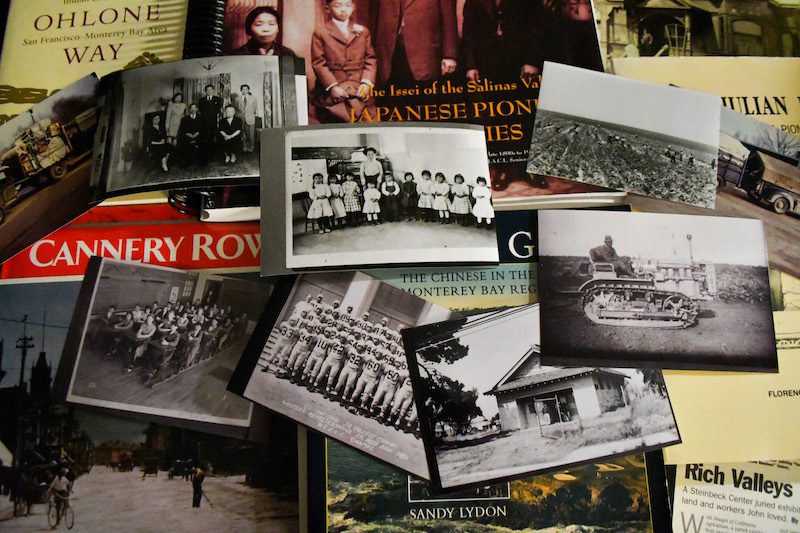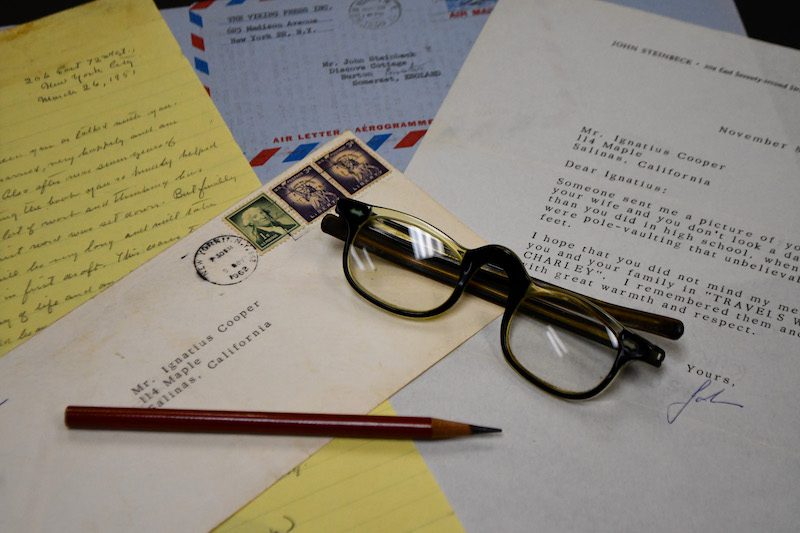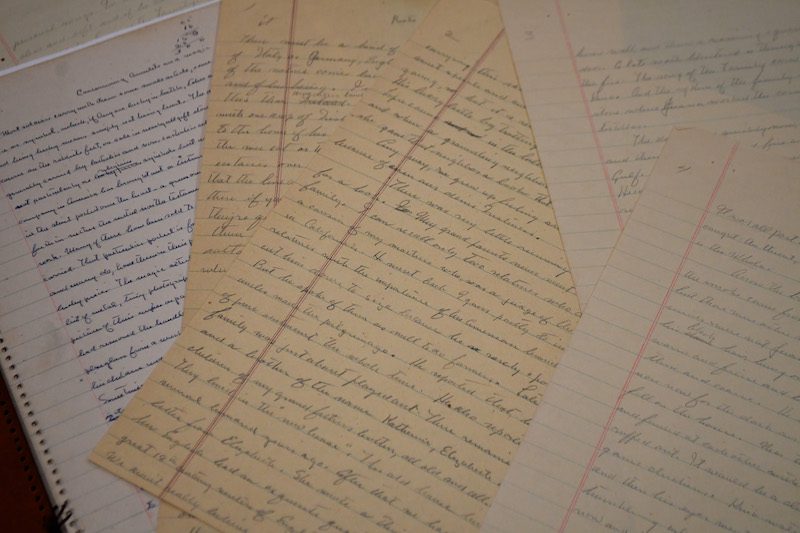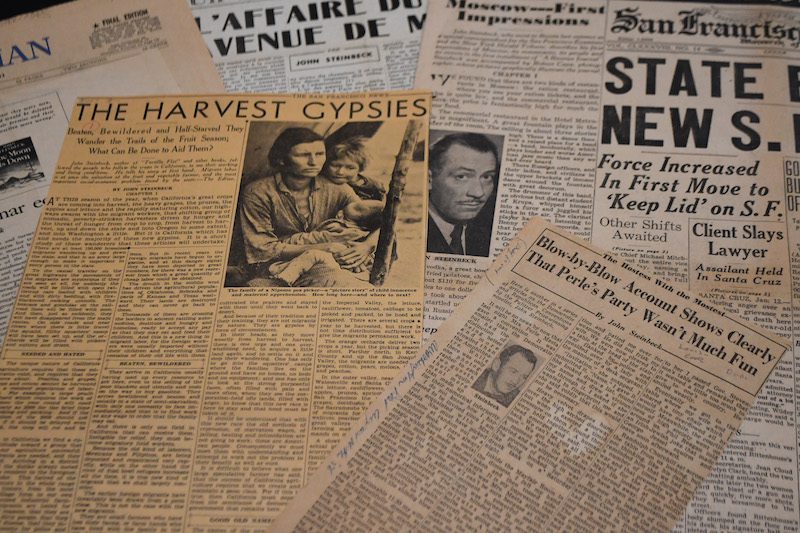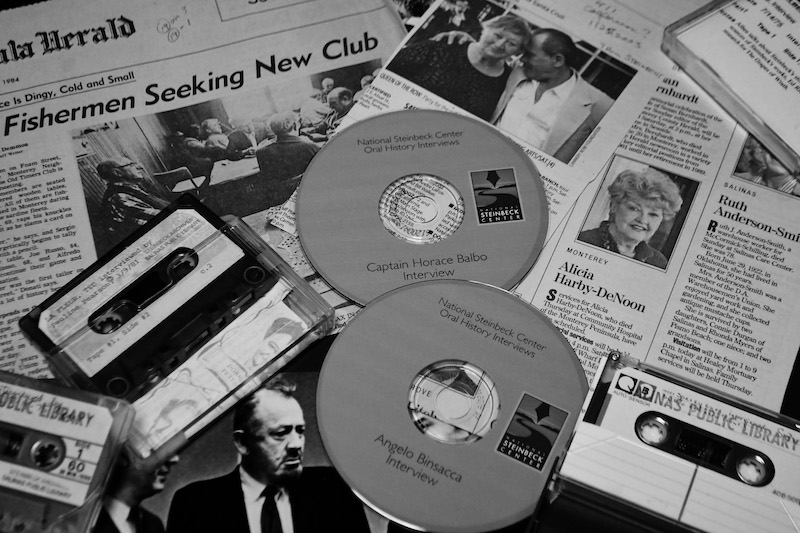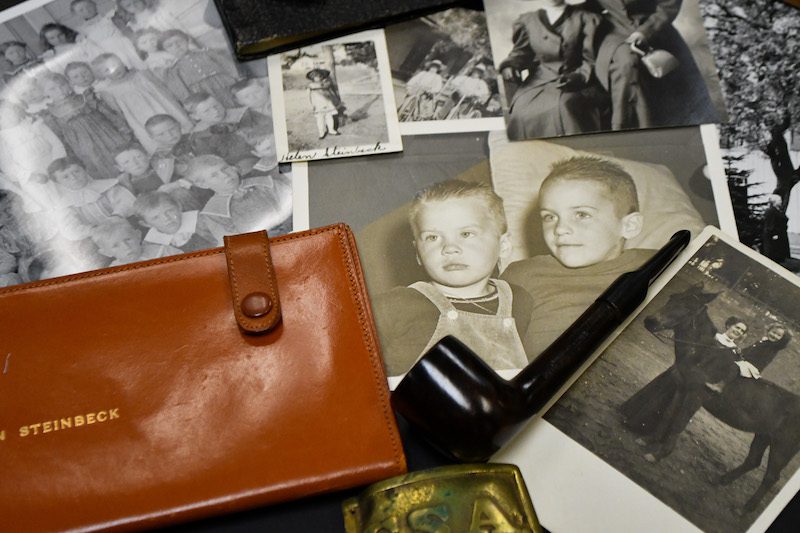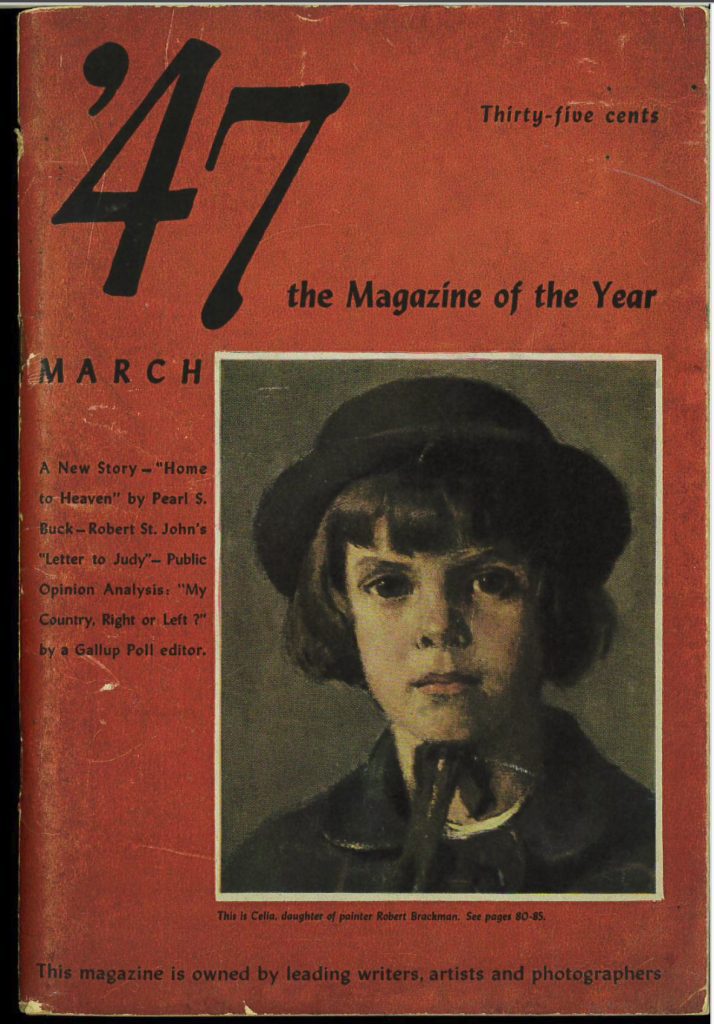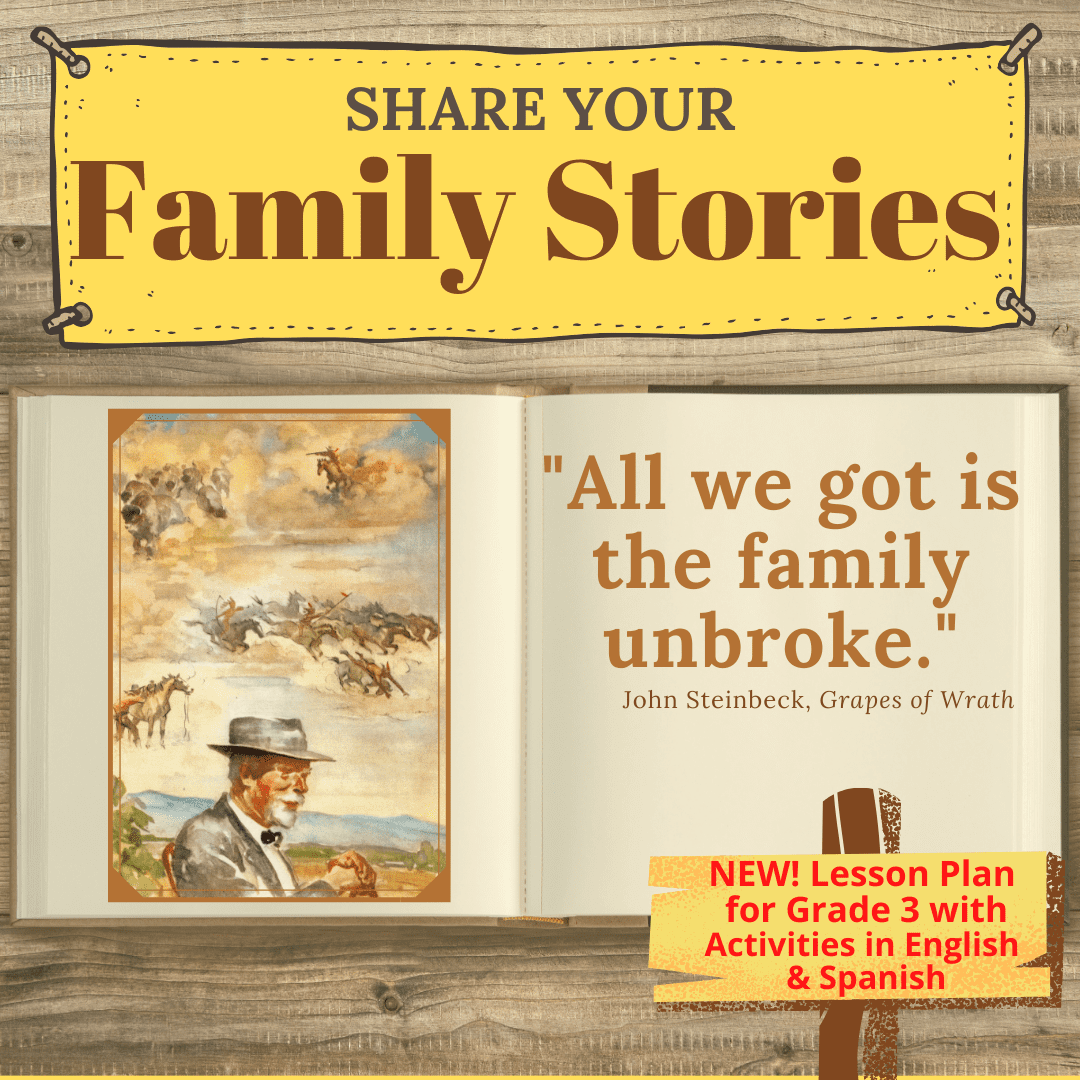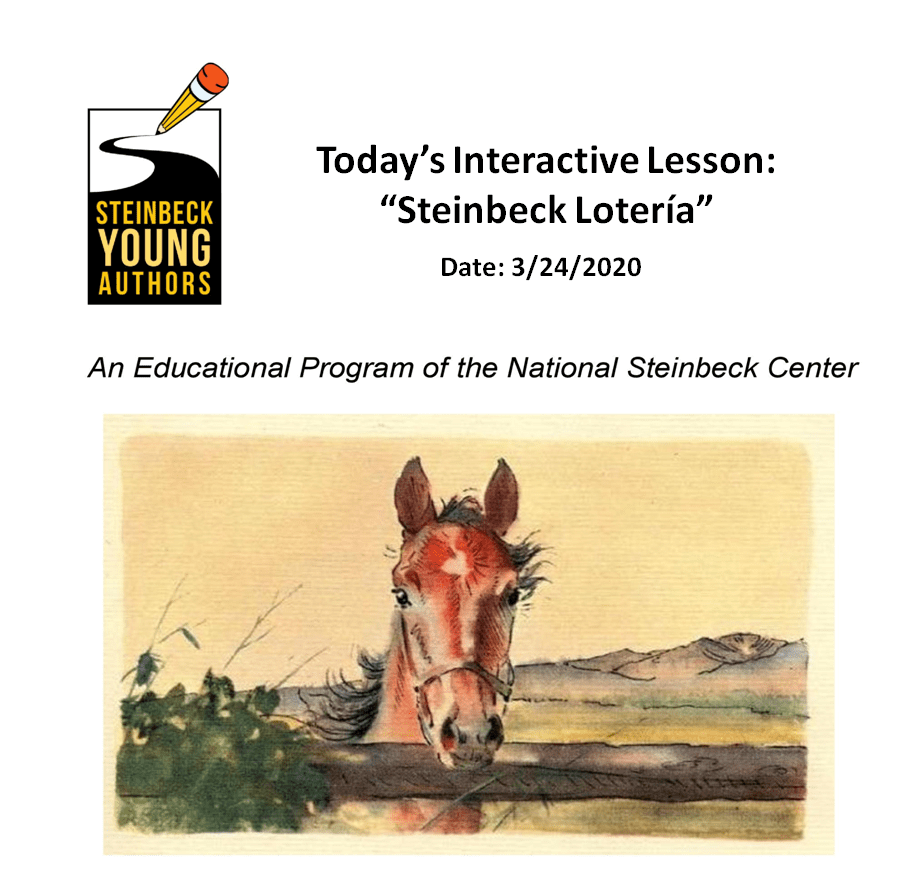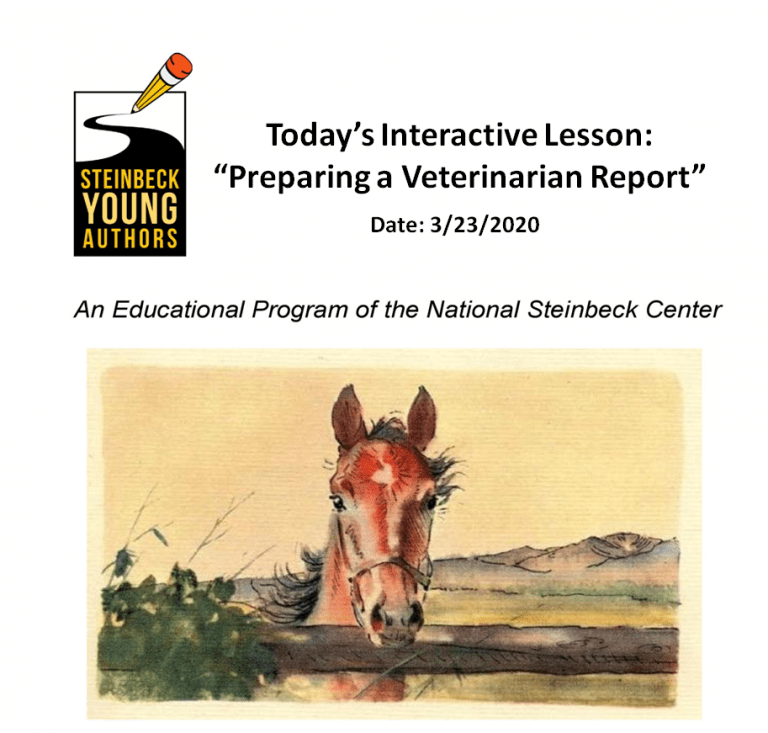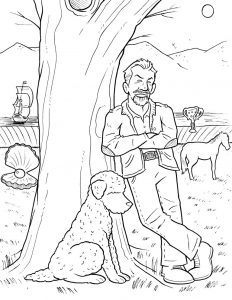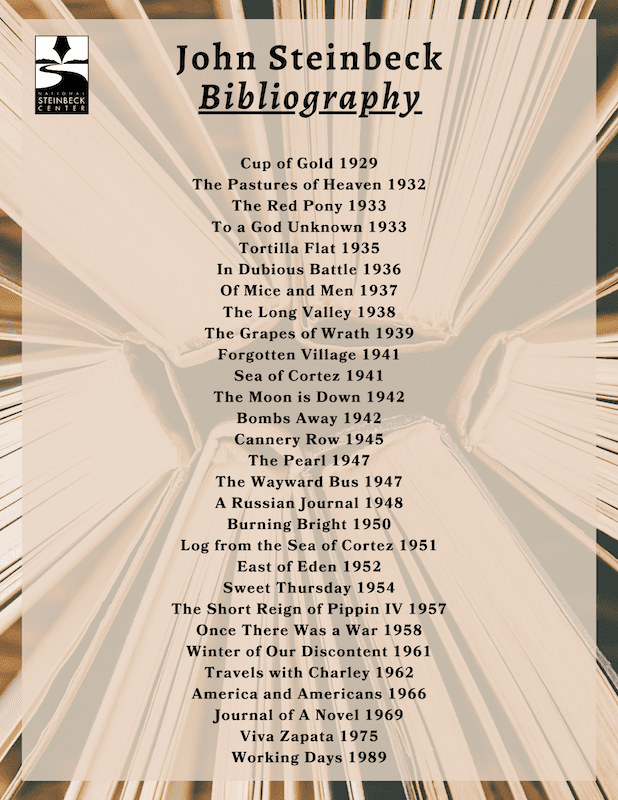Open Wednesday through Sunday 10am to 5pm
We are closed Sunday, April 20, 2025
for the Easter holiday.
We're sorry for any inconvenience.
Help us upgrade our museum!
The National Steinbeck Center is a 501(c)(3) nonprofit corporation. Your donation is tax deductible and has an enduring impact.
Learn
John Steinbeck Bio
John Steinbeck Bio
John Steinbeck was born in Salinas in 1902 to a middle-class family living a few blocks from Salinas’ bustling Main Street. His father, John Ernst Sr., worked as a manager in the local flour mill. Later, he owned a feed store and was later appointed Monterey County Treasurer. Steinbeck’s mother, born Olive Hamilton, was a former school teacher who enforced high academic standards for her children and encouraged a love of literature. John Steinbeck had three sisters: two older sisters Esther and Beth, and a younger sister Mary, whom Steinbeck was close to throughout their childhood together.
Schooling for Steinbeck showed an early love of storytelling and writing. In high school, a favorite teacher of Steinbeck, read his stories aloud to the class as positive examples, both embarrassing him due to his shyness and encouraging him to continue. He carried this love of writing to college, attending Stanford University’s growing selection of creative writing and English courses. However, the details of taking a full roster of requirements for graduation did not appeal to Steinbeck, so he left the University in 1925 without a degree, having taken the courses that interested him over six years.
Steinbeck’s early work and writing as an independent adult were varied and difficult. He worked at odd jobs, including construction work, journalism, as a winter caretaker for a Tahoe estate, and finally in a Tahoe fish hatchery. Throughout this assortment of jobs, Steinbeck tried to write in his free time. The job as a winter caretaker for a Tahoe vacation estate afforded him the most time to write; he finished his first novel-length manuscript, isolated in his cabin after long winters. This became The Cup of Gold (1929). While working at the hatchery the following summer, Steinbeck met Carol Henning, who would become his first wife. The couple married on January 14, 1930, in a courthouse ceremony.
Together, they lived as long as they could in Los Angeles until the money ran out, forcing them to move to the Steinbeck family vacation cottage in Pacific Grove. There, Carol worked a series of odd jobs herself, putting her skills as a secretary to good use, while Steinbeck wrote as much as he could. During this early period of his writing career, Steinbeck wrote The Pastures of Heaven, stories that became part of The Red Pony, The Long Valley, and To a God Unknown. However, his first commercial success came with the publication of Tortilla Flat. This was Steinbeck’s first book published with his new publisher and editor, Pascal Covici. He would remain Steinbeck’s friend and editor until his death in 1964.
After this turning point in Steinbeck’s career, he started work on some of the best-known pieces, including In Dubious Battle, Of Mice and Men, and the crowning achievement, The Grapes of Wrath. At its publication in 1939, The Grapes of Wrath was a controversial book. Steinbeck felt that it plagued the rest of his career: everyone from his literary agents to the reading public was waiting for another Grapes of Wrath. Unfortunately, after fame and fortune came to his life, Steinbeck’s marriage to Carol wavered and fell apart. They divorced in 1943, freeing Steinbeck to marry Gwyndolyn “Gwyn” Conger, whom he had met several years before.
With the dawning of the 1940’s, Steinbeck turned to the growing war effort, producing propaganda pieces supporting the American war effort. The Moon is Down rose to a level of prominence in Europe it never achieved in the United States. For occupied Europe, it became a well-loved work, passed clandestinely from reader to reader even when it could earn them a prison or death sentence. In 1943, Steinbeck experienced war for himself as a war correspondent, writing for the New York Herald Tribune and syndicated in every state except Oklahoma. Upon returning from the war, Steinbeck felt the need for something different. During the war, his injuries and experiences put him in a dark mood that lasted for many months afterward.
Finally moving out of his dark mood, Steinbeck wrote Cannery Row, a book that, in a 1953 essay, Steinbeck says that the soldiers asked for: something funny and not about the war, as they were sick of war. In this post-war period, Steinbeck also returned to pre-war material from his 1940 trip to Baja California, where he and Ed Ricketts went on a trip to collect marine specimens. The Pearl was the result of this tour of his recent past, a novella together with a film by Mexican director Emiliano Fernandez. He also wrote The Wayward Bus, which has its roots in Steinbeck’s time in Mexico.
However, two tragedies struck quickly in 1948: Ed Ricketts died from injuries sustained in a car accident with an oncoming train, and Gwyn asked for a divorce. Later that year, Steinbeck returned to the cottage in Pacific Grove, where he spent much of his time in the 1930s. The following year, he received a visit from actress Ann Southern, who brought along her friend, Elaine Scott. She would become Steinbeck’s third and last wife; the couple married less than a week after Elaine secured her divorce from actor Zachary Scott in December 1950. Then, in early 1951, Steinbeck turned to the “big novel” of his career, East of Eden, drawing on his own family history intertwined with the fictional Trask family. They play out a retelling of the Cain and Abel story. The novel took nearly a year to complete and was published in 1952.
Throughout the 1950s and 1960s, Steinbeck and Elaine traveled widely. Steinbeck finally achieved his goal of supporting their travels through journalism, written about the places they visited. The trip that stood out most for Steinbeck was a ten-month stay in Somerset, England, where Steinbeck worked on a modernized version of the King Arthur stories he loved from his childhood. It stood incomplete for the rest of Steinbeck’s life, though published posthumously in 1976. After months abroad for many years, Steinbeck turned back to his own country, writing about the United States in Travels With Charley and expressing his concern over moral decay in America in The Winter of our Discontent. Later, in America and Americans, Steinbeck returned to the issue of Americans, their culture, and what America was like in the mid-1960s. Although critical of excesses and moral laziness, Steinbeck was clearly sympathetic to Americans as a people and wrote about his belief in the potential Americans have for greatness.
In 1962, Steinbeck was awarded the Nobel Prize for Literature for his body of work. His is “realistic and imaginative writing, combining as it does sympathetic humor and social perception,” said Permanent Secretary of the Swedish Academy Anders Osterling in his presentation speech. In 1964, Steinbeck was awarded the Presidential Medal of Freedom by President Lyndon B. Johnson, with whom the writer was personally acquainted.
Steinbeck’s health continued to decline throughout the mid-sixties, and he eventually died at his home in New York City on December 20, 1968.
The National Steinbeck Center, a museum and cultural center in downtown Salinas, pays tribute to his life and lasting impact on American letters and American identity. The Steinbeck Museum explores his ecological vision, his commitment to social engagement, and his many stories about the working class—all of which ensure his work is deeply relevant today. Steinbeck’s books have been published in more than 45 languages, and he is, truly, a citizen of Salinas as well as a citizen of the world.
Listening to America
Follow along with “Listening to America’s” Clay Jenkinson as he voyages in John Steinbeck’s footsteps and his “Travels with Charley” journey!
Stay up to date by visiting his website!

My Itinerary: Phase One: April 27-June 6, 2024
My plan is to drive about 250 miles per day. My intrepid scout Frank is getting me reservations in campgrounds. Months ago, I provided him with an elaborate set of criteria for choosing locations: county and state parks wherever possible and non-chain commercial campgrounds, unless KOA is the only option. I’ll spend at least one or two nights in Walmart parking lots. Connectivity matters! I’ll be posting photos and commentary virtually every day.
The plan looks like this. Get to the starting gate at Sag Harbor on Long Island: Bismarck to Fergus Falls, Minnesota; Fergus Falls to Mankato, Minn.; Mankato to Cedar Rapids, Iowa; Cedar Rapids to Ottawa, Illinois, home of my friend WGN Chicago radio talk show host John Williams, the brainiest of AM talk show hosts; Ottawa to Big Bone Lick, Kentucky, where Jefferson’s proteges Meriwether Lewis and William Clark dug up mastodon bones for the entry museum at Monticello; Big Bone Lick to Bethany, West Virginia, where I will interview the “bad boy of Steinbeck studies,” Bill Steigerwald, author of Dogging Steinbeck: Discovering America and Exposing the Truth about Travels with Charley; Bethany to Pennsylvania; Pennsylvania to Long Island, New York. I’ve studied his book carefully and printed out his blog prose from his 2010 50th anniversary retracing of Steinbeck’s 1960 journey. Steigerwald did important field research and concluded that:
A: Steinbeck embellished and even fictionalized some of Travels with Charley (TWC).
B: He actually stayed in his truck camper less often than he would have you believe.
C: His wife Elaine was with him for about 40% of the time, a fact he suppressed to keep up the appearance of a lonely journey through the heart of America.
D: He raced through long stretches of the journey to rendezvous with Elaine.
E: He didn’t always sleep where he said he did.
F: Although he said he had to travel incognito so that his fame would not distort the process, he used his celebrity when it was important.
I disagree with many of Steigerwald’s conclusions, and I think his mistook a work of travel literature by demanding punctilious and verifiable reportage. However, he has provided all future Steinbeck re-tracers with an excellent day-by-day guide to what Steinbeck saw and did.
The cad! Steigerwald wrote me an email saying that I could park in his driveway and if I needed a hot shower or a comfortable bed, I could be a guest in his house. I wasn’t born yesterday, Bill. I wrote back to say he was trying to lure me inside his house so that he could later denounce me for embellishing and fictionalizing my own journey! That, of course, was not his intention, but you cannot trust a muckraker on a journey like this.
When I finally reach Sag Harbor on the far end of Long Island around May 10, the actual Steinbeck journey begins.
In a nutshell: through New England to the top of Maine, which he insisted on touching so I will, too; then down through New Hampshire and Vermont to the Erie Canal, which I have always wanted to see; Niagara Falls; then along the underside of the Great Lakes to Chicago, where I will stay in the Ambassador East Hotel, where Steinbeck’s wife Elaine met him for a few days; then through Wisconsin and Minnesota (with stops at Sinclair Lewis’ Sauk Centre, and Frazee, where Steinbeck camped among a sea of turkey farms and Lake Itasca, the “true source” of America’s greatest river the Mississippi); and finally back to Bismarck.

Day 1
Sunday, April 28, 2024 — Well, I’m underway! After somehow managing to assemble a bike rack for my Listening to America Airstream (five hours, the worst instruction manual, bruised knuckles, and several bleeding injuries to my fingers), I locked the front door of my house. “Nothing to do now except go,” I said out loud. It was a chilly and still wintry morning in Bismarck, temperature 42, brisk wind, gray skies. I gassed up in the nearby village of Stirling, then drove nonstop to Fargo, North Dakota where I bought gas and a bag of pretzels. In mid-afternoon, I drove southeast to Fergus Falls, Minnesota, found the Swan Lake Resort, and checked in. The owners were at the lakeside putting docks into place for the summer. I could have stolen sundries, decals, patches, mugs, and t-shirts from the deserted office. Thoreau wrote, “I think we may safely trust a good deal more than we do.”
I chose Fergus Falls for my first stop because it was a moderate distance from Bismarck (262 miles) and because my maternal grandparents had a dairy farm here in the 1950s, ’60s, and ’70s. I don’t know what they would have thought of my career, but they would have been astonished that one can live a whole life without doing any real work. They worked hard every day of their lives; even on Sundays, the steers needed feeding, and the cows had to be milked, all 16 of them, with names like Petunia, Daisy, Whitey, Pal, and Blossom. They would have shaken their heads at the sight of a gleaming Airstream trailer. They seldom traveled far beyond Otter Tail County, Minnesota. They drove once to California, where they were fish out of water at Disneyland and on the LA freeways.
At the “Compass” site at Swan Lake Resort, once I got the rig hooked up to water and electricity, I began to unpack and find places in the cabinetry for clothes, electronic equipment, books (11), food, toiletries, notebooks, and other necessities. The camp hosts had invited me to supper (in the rural Midwest, dinner is served at mid-day), but I declined because I needed to get everything settled in the rig. But — in Steinbeck fashion — I invited them to stop by later. They did, about 8:45 p.m. They lit a fire in the firepit. They brought local beer and a half bottle of whiskey. They are young — in their later 30s. Anna had her 11-month-old baby swaddled in her arms. Tom served as drinkmaster. Anna brought a plate of outstanding carrot cake.
We talked for a couple of hours. About their decision to leave corporate America to buy a modest resort in a place where they had no kin. About the essential goodness of the people who come stay here. The resort doesn’t allow flags at the campsites, so they have no way to know people’s politics and generally avoid the topic. They wanted to know about my ambitious journey. I explained my quest. This led to a discussion of the State of the Nation as we approach America’s 250th birthday. They were thoughtful. Tom’s well-read and ready to talk.
Eventually, the fire subsided and we were all cold (except for the swaddled baby), so we called it a night. I tumbled into bed.
Day Two Begins
It’s a gray morning in northwestern Minnesota, but so far dry, 42 degrees, some wind in the still-bare trees. I’ll pack up soon and head to Mankato, 212 miles south. I want a full day here to finish unpacking and do some writing, but I’ve got to keep moving if I am going to get to the eastern tip of Long Island within 10 days.
Immediate conclusions:
1. Setting up camp only takes about 10 minutes — hose to the spigot, stout electrical cord into the gray metal box.
2. Nothing had tumbled around in the Airstream on a blustery day of driving with many road bumps and potholes. If you pack it right, there is no chaos upon arrival.
3. Driving a pickup-RV combination 60 feet long requires concentration (no texting!), and a few hundred miles will wear you out.
4. Given the spontaneous little party we scared up at my fire pit, and the quality of the conversation, I reckon that it’s going to be easy enough to Listen to America.
A Message from Clay
Hello Everyone,
I write this from central Pennsylvania. After a 4-hour drive today, I arrived at a lovely RV campground an hour ago. Hooked up electricity and water. Deployed my Starlink internet antenna, which resembles a large white plastic cutting board. Then I took a very pleasing hot shower, shaved a two-day beard, erected a new backdrop for video interviews in the Airstream, and now I am checking in with all of you. The last two days have been the only ones in a week without high winds, though it rained hard for more than an hour at dawn today at Bethany, West Virginia, where last evening I had the honor of interviewing the “bad boy of Steinbeck studies,” Bill Steigerwald, author of Dogging Steinbeck: Discovering America and Exposing the Truth about Travels with Charley.
Mr. Steigerwald turned out to be a delight. Mostly I listened to his entertaining account of his travels. I challenged him on a couple of points, one involving my beloved North Dakota, but it was all joy. We’ll be posting parts of the interview soon.
Tomorrow I drive through New York City to Long Island and on Tuesday morning I have the honor of seeing Steinbeck’s Sag Harbor house, now dedicated to supporting writers and artists. Then the true Travels with Charley journey begins.
In this week’s newsletter, my Dispatch about the loveliness of Iowa, and its depiction by the painter Grant Wood (1891-1942). Iowa is much more interesting and beautiful than perhaps you have heard, especially in the fullness of spring.
This week’s podcast is an interview with political cartoonist Phil Hands about the history of American cartoons. You’ll find one here that we talked about on the program. If you want to read a history of political cartoons I recommend The Art of Ill Will: The Story of American Political Cartoons by Donald Dewey; and Victor S. Navasky’s The Art of Controversy: Political Cartoons and their Enduring Power.
It’s 4 p.m. local time. I’m clean, glad to be done driving today, and glad to be alive!!
Please visit our Listening to America Facebook site and return to LTAmerica.org frequently to keep abreast of the great road trek. I’ve traveled just under 2,000 miles so far. I started the day by visiting the Portiuncula Chapel at Franciscan University in Steubenville, Ohio. It’s a marvelous replica of the chapel in Assisi where Francis heard directly from God and rededicated his life to “restoring the church.” I’ve wanted to see it for a very long time, ever since my friend Sharon Kilzer spoke of its beauty and its power to inspire.
Across Iowa

Iowa — I drove across Iowa this week to get to Illinois and beyond. I’ve been to Iowa many times over the years, but this journey — straight through — was particularly beautiful. It’s spring and it has been raining. The wide farm fields are a deep rich black usually without a single weed anywhere to be seen. All the grass in Iowa in early May — from Kentucky bluegrass to alfalfa and prairie — is spring green, clean, almost garish green. Although Iowa is one of the most productive farm states in America, employing state-of-the-art equipment, including GPS driven tractors, sprayers, and combines, the whole countryside is still punctuated with the old concrete tile silos we associate with the mid-20th century, not the 21st. Over every rural hill I saw old classical gambrel (English style) barns, some painted red, others white, most needing paint and in some degree of dilapidation. One or two had smiley faces, and of course a few anti-Biden signs, some homemade.
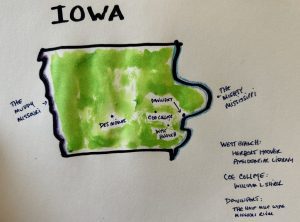
Iowa has the great honor of being bounded on east and west by two of the world’s great rivers. On the west, the Missouri (2,341 miles, beginning at Upper Red Rock Lakes in extreme southwestern Montana; on the east the mighty Mississippi (2,340 miles, beginning at Lake Itasca in northern Minnesota). I know the Missouri River well. I live just two miles from it in Bismarck, North Dakota, and every summer I float the famous White Cliffs section in central Montana on my annual Lewis and Clark cultural tour. (See the Cultural Tours page for details.) But when I came suddenly upon the Mississippi at Davenport, Iowa, yesterday, it took my breath away and I fell into a dreamy Huck Finn meditation. Even this far north the Mississippi is an awesome river, half a mile wide and 30-40 feet deep. If you have not read Twain’s Life on the Mississippi (1883), you owe yourself that pleasure.
Iowa is not at all flat. Its rolling hills look like they were painted by Missouri’s Thomas Hart Benton or Iowa’s Grant Wood. This gives great character to Iowa’s family farms. Many of the fields embrace hills and gentle ridges, and the farmer has to perform some sinuous plowing on the sides of surprisingly angular hillsides.
Grant Wood (1891-1942), by the way, grew up in Cedar Rapids, Iowa, also the boyhood home of the journalist and historian William L. Shirer, the author of The Rise and Fall of the Third Reich (1962), a copy of which John Steinbeck was carrying in his truck camper on the Travels with Charley journey. Everyone knows Wood’s American Gothic (1930). The farm couple were modeled on Wood’s sister Nan Wood Graham and his dentist Dr. Byron McKeeby, neither of whom was pleased with how he depicted them.
But it is Wood’s farm scenes that I was reminded of as I drove Iowa. The state still looks that way.
I’ve been reading about Grant Wood in Shirer’s memoir, American Journey: The Start. Most of his paintings are admiring of rural life and the rural countryside, with a slight edge of irony about what Sinclair Lewis regarded as the psychic claustrophobia of the rural Midwest. The couple in American Gothic do not look happy with their lot.
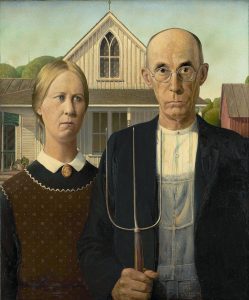
Wood’s most satirical painting is titled Daughters of Revolution (1932). He was commissioned to create a stained glass window at the Veterans Memorial Coliseum in Cedar Rapids. Because he did not regard U.S.-manufactured glass as high enough in quality for his art, he used glass manufactured in Germany for the project. The local chapter of the Daughters of the American Revolution (DAR) criticized Wood for using German glass for a World War I memorial. Wood dismissed his critics as “those Tory gals,” and decried “people who are trying to set up an aristocracy of birth in a Republic.” (This, by the way, was Thomas Jefferson’s criticism of the Society of the Cincinnati, which was planned as a hereditary organization for veterans of the Revolution and their descendants. Jefferson saw organizations like this as attempting to create a hereditary aristocracy in an equalitarian republic.) Wood got his revenge five years later. His Daughters of Revolution depicts pretentious and soulless church ladies sipping tea before a framed print of Emanuel Leutze’s 1851 Washington Crossing the Delaware.
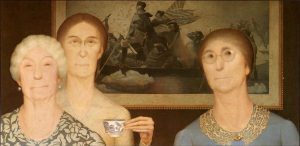
I can tell you from personal experience that members of the DAR are still miffed by Wood’s painting to this day!
I’ve chosen a Grant Wood landscape to give you an accurate sense of what I saw on my travels, and two by Thomas Hart Benton.
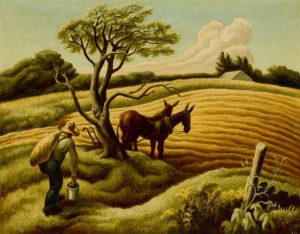

Visiting John Steinbeck's in Sag Harbor, New York
Clay visits John Steinbeck’s Sag Harbor home on Long Island where the noted author began his 1960 cross-country journey, immortalized in Travels With Charley.
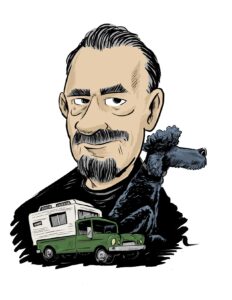 John Steinbeck, his dog Charley and camper rig. (Sketch by Nate Calderone of Salida, Co.)
John Steinbeck, his dog Charley and camper rig. (Sketch by Nate Calderone of Salida, Co.)
A journey in the wake of John Steinbeck’s 1960 Travels with Charley trek has to begin at Sag Harbor on Long Island. Steinbeck lived there off and on beginning in 1955.
So I drove my Airstream, Rocinante, from Bismarck, N.D., to the end of Long Island to do it right. (And learned some RV lessons along the way.)
I was delighted to be shown around the property by Kathryn Szoka of the Sag Harbor independent bookstore Canio’s Cultural Cafe. The bookstore is hosting a marathon public reading of Travels with Charley on June 7. Last year they did Melville’s Moby Dick, compared to which Travels with Charley is a mere pamphlet!
Steinbeck set off on his transcontinental journey from Sag Harbor on September 23, 1960, in a new pickup camper, with hunting and fishing equipment, more books than he could possibly read along the way, a well-stocked supply of liquor, and his giant French poodle Charley.
He drove the perimeter of the United States, 11,500 miles. And then wrote a superb account of his travels, published in 1962.
I’ll write more about this, but for the moment just a few comments:
1) The house at Sag Harbor is smaller than I had expected, but the grounds are larger, with magnificent old oak trees that have just begun to leaf out.
2) The dock is still there in the bay. It was the scene of a preliminary drama, when Hurricane Donna swept through and threatened to crush the Faire Elayne (the boat) against the dock. Steinbeck rescued the boat, anchored it safely, well away from shore, and then swam back through the flood tide. It was a dangerous thing to do and Steinbeck’s wife Elaine was both relieved and scolding when he straggled back to shore.
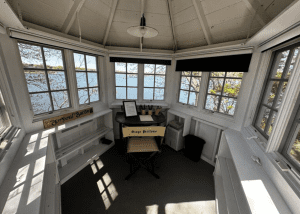 Inside Steinbeck’s writing hut, Joyous Garde, at his home in Sag Harbor, N.Y.
Inside Steinbeck’s writing hut, Joyous Garde, at his home in Sag Harbor, N.Y.
3) His writing hut, Joyous Garde, is quite far from the house, right on the edge of the bay. He had it built small enough so that he would not be beleaguered by visitors while he wrote every day. He strung electrical cords from the house to Joyous Garde when he needed electricity.
4) The Steinbecks divided their time between their place in New York City and Sag Harbor which is more than 100 miles from Manhattan and traffic in our time can be congested.
So now I have touched base at the embarkation point. Tomorrow I will take the ferry to Connecticut and begin — first up to the top of Maine (which he insisted upon and partly regretted), then to Niagara, down along the southern shore of the Great Lakes to Chicago, and from Chicago through Wisconsin, Minnesota, and eastern North Dakota, where Phase One of my great journey ends around June 6.
Special thanks to Kathryn Szoka and Canio’s Cultural Cafe, an excellent bookstore where, of course, I bought a couple of books.
I was deeply moved, grateful, and inspired to wander the property and sense the contentment (and privacy) one of America’s greatest writers enjoyed “far from the madding crowd” of New York City.
A Stop at Thoreau's Walden Pond near Concord, Massachusetts

Walden Pond, near Concord, Mass., immortalized by Henry David Thoreau. (Photo by Nolan Johnson)
I recently had the immense joy of revisiting Walden Pond near Concord, Massachusetts, for the 10th or so time. Perfect weather. In spite of the detractors who abuse Henry David Thoreau for taking his laundry to town and not being John Muir, I regard Walden as America’s greatest book, almost the “bible” of American environmentalism. It’s not really a Nature book (though it is that, too), but a manifesto for simplifying one’s life, advancing boldly in the direction of one’s dreams, and calculating the “cost” of all that we purchase and accumulate.
Guilty, as charged, Your Honor!
My friend Nolan took this stunning drone photograph of the pond, where Thoreau lived two years, two months, and two days, beginning on the 4th of July 1945.

Today, my last day in Massachusetts (for now), I visited the Concord Museum, which has almost all of the furnishings Thoreau put into his cabin. You see here the green desk on which he wrote Walden and On the Duty of Civil Disobedience, not to mention his immense and revolutionary journal.
I had never been to the Concord Museum before. It’s a close to Thoreau as you are ever going to get — inside!
I know some of you will disagree that Walden is America’s greatest book. I’d be interested in your nomination.
I’m now two weeks into my transcontinental journey, thriving in my own little portable Walden cabin, the Listening to America Airstream, with the same square footage as Thoreau himself had.
Reading The Rise and Fall of the Third Reich While Traveling With Charley
 Pioneering CBS radio journalists, Ed Murrow and William Shirer.
Pioneering CBS radio journalists, Ed Murrow and William Shirer.
Clay visits Cedar Rapids, Iowa, boyhood home of pioneering journalist and author William Shirer, who later became friends with John Steinbeck.
As I made my way from Bismarck, North Dakota, to Long Island, New York, to visit John Steinbeck’s Sag Harbor home, I wanted to make several “humanities stops.” These include Pipestone, Minnesota, one of the most important pipestone quarries in North America; Mankato, Minnesota, site of the largest mass execution in American history; and Big Bone Lick, Kentucky, where Jefferson’s friends and proteges quarried mastodon bones to send him at Monticello.
Planning my initial itinerary with maps spread out before me and a copy of Travels with Charley, I decided to pilgrimage to Cedar Rapids, Iowa, the boyhood home of William L. Shirer, the author of The Rise and Fall of the Third Reich. Shirer is one of my heroes. His talent, drive, and some good luck made him one of the most important American journalists of the 20th century. After graduating from Coe College in Cedar Rapids in 1925, Shirer ventured to Paris in hopes of finding a job at an English-language newspaper and maybe writing the great American novel. He found work first as a print journalist and, soon enough, as one of the first of CBS’ Murrow Boys. With Murrow, Eric Sevareid, and a few others in March 1938, during the Anschluss (Hitler’s annexation of Austria), Shirer helped to invent the radio news roundup. His appearances on CBS radio, usually beginning with “This is Berlin!” were not as widely acclaimed as Murrow’s London rooftop commentary during the Blitz; nevertheless, Shirer was famous in America well before the U.S. entered the war in December 1941.

Shirer wrote more than a dozen books, including one of the best autobiographies of the 20th century, the three-volume 20th Century Journey. Volume two, The Nightmare Years, is one of the best books I have ever read.
John Steinbeck met William Shirer in New York not long before he (Steinbeck) traveled to Europe and North Africa in 1943 as a war correspondent. They met through a mutual friend, Lewis Gannett, the book editor for the Tribune. As he prepared to see the war for himself, Steinbeck sought out Shirer several times for advice about what to expect in war-torn Europe and how to report it. Shirer’s Berlin Diary was published in the United States in June 1941, at a time when most of the American establishment was skeptical of the horror stories coming out of Germany — the Gestapo, the SS, persecution of the Jews, the concentration camps.
The Complexity of Marriages
John Steinbeck’s domestic drama began unfolding at the same time. He was married three times. His first wife, Carol Henning (1930-1943), typed his manuscripts, helped him creatively, and named The Grapes of Wrath. She saw him through the lean and hungry years. After their divorce in 1943, Steinbeck selected his second wife on the rebound. He married aspiring singer Gwendolyn Conger in 1943. On the rebound — a leggy blonde with what observers called a “great figure,” a frustrated aspiring singer and actress, 20 years John’s junior, edgy about his celebrity. What could go wrong? In their five years together, Gwyn bore Steinbeck two children: Thom (1944) and John (1946). They divorced in 1948. In 1950, Steinbeck married Elaine Scott. They had most of two decades together. Elaine survived Steinbeck by 34 years. It was the happiest of the three marriages.
The second marriage was never really happy, partly because Gwyn convinced herself that she had sacrificed a promising stage career to become the wife of a selfish and famous novelist. But Steinbeck may have poisoned the marriage from the start by deciding, almost immediately after the wedding in New Orleans, that he had to get himself “into the war.” John and Gwyn were married in New Orleans on March 29, 1943. Just over two months later, he left for Europe. Gwyn was devastated. I think she never really forgave him for running off to war.
Desperate to keep her husband home during the honeymoon period of their relationship, Gwyn had visited Shirer secretly to convince him to dissuade Steinbeck from taking the assignment. Shirer refused. He told Gwyn that he understood John’s desire to get into the arena, contribute to the war effort, and not miss the greatest story of his lifetime.
Steinbeck embarked for England in June 1943. He took a typewriter, 4 quarts of Scotch, 2 pounds of pipe tobacco, and a hundred Multicebrin tablets (vitamins). Some of his war reporting was published as Once There Was a War in 1958. Steinbeck spent considerable time with William Shirer in London, partly, according to his biographer Jackson Benson, because Shirer “was of the breed of correspondent that is part scholar, part newspaperman.”
Readers of Travels with Charley know Steinbeck was carrying Shirer’s magnum opus, The Rise and Fall of the Third Reich, with the other volumes he packed in his truck camper. After a satisfying conversation in the rig with a local farmer in New Hampshire, Steinbeck wrote: “Charley looked after him and sighed and went back to sleep. I ate my corned beef hash, then made down my bed and dug out Shirer’s Rise and Fall of the Third Reich. But I found I couldn’t read, and when the light was off I couldn’t sleep.”
There is a mystery here. This incident occurred in late September 1960 in New England. However, The Rise and Fall of the Third Reich was not published until October 17, 1960. How does John Steinbeck have a copy in his rig? There are only a few possibilities. 1) He’s making this up, perhaps because he doesn’t want to report that he was really reading Heidi or Old Yeller 2) He got an advance copy of the book before he left Long Island. This is entirely possible given Steinbeck’s friendship with Shirer and his celebrity. 3) He bought a hardback copy somewhere on the road when the book came out (Seattle? San Francisco?) and misremembered the sequencing when he came to write Travels with Charley. We have no way of knowing.
How to Read Travels with Charley in an Age of Disillusionment
At this point, I should explain my Travels with Charley methodology.
1. I believe that John Steinbeck really made this 10,000-mile journey in 1960, leaving Long Island on September 23, 1960, and arriving home sometime in December.
2. I believe he is reporting his itinerary accurately.
3. I believe every story or virtually every story in Travels with Charley is true, that every or almost every encounter and incident in the book happened during the trip.
4. Several writers, chiefly Bill Steigerwald, have proven (beyond any doubt) that Travels with Charley is not a book of punctilious fidelity to a kind of reporter’s “the facts and only the facts in precisely the right sequence” objectivity. It is clear that Steinbeck embellished his adventures and, I suppose, invented some of the dialogue. How could it be otherwise?
5. Steigerwald has shown beyond doubt that
- Steinbeck did not sleep in the truck camper as often as he would have us believe.
- Steinbeck’s wife Elaine was with him far more than Travels with Charley acknowledges. Steinbeck admits to meeting Elaine in Chicago for a couple of days of R & R (at a luxury hotel), in Seattle, and in the panhandle of Texas, where John and Elaine celebrated Thanksgiving on an opulent and ostentatious ranch to which Elaine had a connection. It’s not entirely clear how much of the time Elaine was with Steinbeck, but it comes close to 40%.
- Steinbeck tended to rush from one Elaine rendezvous to the next in such a way that he could not have been doing much searching for America.
6. I accept all of that, in substance if not with my friend Steigerwald’s gotcha tone. But I am not nearly so bothered by these discrepancies as Steigerwald. I’ve always accepted that Travels with Charley is the work of a literary master, not a reporter for the Pittsburgh Post-Gazette. Steinbeck reminds us several times in the book that an author inevitably shapes his material. That to turn an adventure into a book requires structure, a beginning, middle, and end, and that the stories he tells in Travels with Charley — like all stories from the beginning of time — behave like stories — they get tidier, more dramatic, and more tightly structured as they are transformed from something that happened at the Maple River in eastern North Dakota into a usable incident in a work of non-fiction literature.
7. My default position, therefore, when I come upon a story, incident, or personage in Travels with Charley is that it is true, or I should say True in a higher sense. My default position is not — and this is where I chiefly break with Steigerwald — that the story is probably not true, that it was probably invented or so heavily embellished as to make it unreliable from the perspective of what a Steinbeck Cam would have revealed on that day.
8. Reporters should read Steinbeck’s Nobel Prize acceptance speech before embarking on this kind of investigative journalism. On that occasion, December 10, 1962, in Stockholm, Steinbeck reminded his worldwide audience that humans are fundamentally a story-telling species:
“Literature is as old as speech. It grew out of human need for it, and it has not changed except to become more needed. The skalds, the bards, the writers are not separate and exclusive. From the beginning, their functions, their duties, their responsibilities have been decreed by our species.”
9. Finally, where there are discrepancies or things don’t quite track or match up, my approach is to figure out what actually happened (where he actually slept and under what circumstances) and then to try to understand why Steinbeck was shaping the narrative as he did. For what literary purpose? The two easiest “distortions” to understand are a: that he exaggerated how often he really camped somewhere and slept in the rig sipping Scotch and reading under the light of a gas lantern and b: how often Elaine was with him in his travels.
 Elaine and John Steinbeck in 1959. (Martha Heasley Cox Center for Steinbeck Studies, SJSU)
Elaine and John Steinbeck in 1959. (Martha Heasley Cox Center for Steinbeck Studies, SJSU)
Steinbeck wants us to picture him at the end of the day, parking under the trees in some quiet and obscure place on the backroads of America, heating a can of chili con carne, reading under the light of his gas lantern, sipping some smooth Scotch, letting Charley out for the last pee of the evening, writing a letter to Elaine, and making up his bed. It’s romantic and a little forlorn, with a bit of risk, a long way from the comforts of home. We’d probably be pretty dismayed if we knew exactly how many (or, as Steigerwald puts it, how few) nights he slept in his rig. Although he admits to staying from time to time in a “motor court” to have a good hot bath, he does not explain how often he wound up in a luxury hotel. That’s not the spirit of the quest.
The book would have been less satisfying if he had admitted how much he was with Elaine on the journey, how often he did not sleep in the truck camper, and how much he rushed to the next rendezvous site with Elaine. He was more candid in the original manuscript, now a treasure of the J.P. Morgan Library in New York City. But by the time the book went to press in 1962, Steinbeck and his editors had done what it took to cast the journey as a lone man’s adventure that ended almost every night in a camper bed converted from the dining table. He refused to eliminate Elaine altogether, but nearly so. This is what good authors and editors do to shape a story for publication.
I certainly don’t doubt that Steinbeck carried his friend William Shirer’s masterpiece for some at least of his 1960 odyssey around America.
And So to Coe College
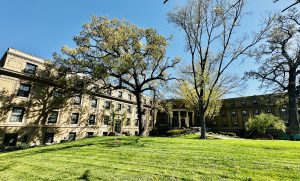 The Quad at Coe College in Cedar Rapids, Iowa. (Photo by Clay Jenkinson)
The Quad at Coe College in Cedar Rapids, Iowa. (Photo by Clay Jenkinson)
So I made an appointment at Coe College to talk with their library staff about Shirer, one of the handful of the college’s greatest alums. The campus is beautiful. Coe’s Stewart Memorial Library has a splendid art collection, including a Picasso, a Matisse, and a fair number of paintings by another Cedar Rapids worthy Grant Wood. I was treated as an honored guest.
But no shrine to Shirer, not even a portrait (or a photograph) or, for that matter, a plaque. What a mistake! When Shirer graduated, Coe College president Harry Morehouse Gage, impressed by the young man’s talent and aware of his big dreams, gave Shirer a loan of $100 (about $1,785 today) and told him to go take on Paris and the world. Thanks to that act of inspired mentoring and faith, Shirer went on to write more than a dozen books, including the critically acclaimed and still widely read Rise and Fall of the Third Reich. Shirer’s father died when William was just 9 years old. Raised by his widowed mother in provincial Cedar Rapids, Iowa, Shirer was lucky to be able to attend college at all, and thanks to big dreams, discipline, and drive, he went on to become one of the 20th century’s most successful journalists, as important to the ways of modern broadcast media as Edward R. Murrow or Walter Cronkite.
What could be a better student empowerment story than this? Or maybe they would all be demanding $1,785 upon graduation!
I lobbied hard for Coe to do justice to Shirer — with the usual result. So far.
Because Steinbeck knew Shirer and because he carried with him a copy of The Rise and Fall of the Third Reich in his rig, I’m carrying the book, too. I first read it when I was 15. It was one of my father’s favorite books, and he urged me to read all 1,249 pages. I did. Much later, I portrayed Shirer in the Great Basin Chautauqua. I suppose I have read it five or six times over the years, and it never ceases to live up to one’s great expectations.
It would be a small but important contribution to Steinbeck studies if I could solve the mystery of how he seemed to have with him a book that had not been published by the time he said he lay awake reading it. An audio interview between Shirer and biographer Jackson Benson, housed at Stanford’s Green Library, may hold some clues. My friend Russ Eagle has ordered a digital copy. Stay tuned.
Resilience and Heart in Lewiston, Maine
 The recently reopened Just-In-Time recreation center in Lewiston, Maine.
The recently reopened Just-In-Time recreation center in Lewiston, Maine.
Today on my way to Bar Harbor, at a friend’s suggestion, I visited the Just-In-Time recreation center in Lewiston, Maine. It’s a bowling alley. It just reopened, six months after yet another in the endless string of mass shootings in America. A mentally ill man shot and killed 18 innocent people on October 25, 2023, eight in the bowling alley, and 10 more down the street at a bar and grill. Thirteen others were wounded.
Sometime after the shooting, the perpetrator committed suicide.
The story is both about the worst of America — an epidemic of mass shootings and a political establishment that refuses to do anything meaningful about it — and also about the wonderful resilience of humanity. Just-In-Time reopened quickly to reassert normal life in the second largest community in Maine, after the worst shooting incident in the state’s history.
I spent half an hour in the bowling alley. There are several signs welcoming people back to the recreation center and a wall with 18 bowling pins painted with the names of the victims. Four or five small clusters of people were bowling on this Saturday afternoon, and a handful were sitting at the bar/snackbar, but the large facility was mostly empty.
It will take time.

Bowling pins painted with the names of two victims of the tragic shooting at the recently reopened Just-In-Time recreation center.
(Photo by Clay Jenkinson)
Visitors from Jupiter — heck, visitors from France or Germany — could only shake their heads in wonder and disbelief that an advanced civilization finds it possible to tolerate mass shootings, now so frequent that they no longer always reach the front pages of our newspapers or the lead on the nightly news.
Surely we are capable of addressing this appalling national disorder in a reasonable way, protecting people’s Second Amendment rights but nevertheless doing what it will take to stop the mayhem. Most Americans have indicated their desire for reasonable firearms restrictions such as mandatory waiting periods, rigorous background checks, red flag laws, and some serious restrictions on assault rifles and the AR-15.
What do you think we should do about the problem? Please don’t say, “just enforce existing laws,” because that is no real solution …
I’m glad I diverted my trajectory to visit the bowling alley. If I am wandering America trying to make sense of our national experiment on the eve of our 250th birthday (July 4, 2026), surely trying to understand the plague of gun violence has to be a central theme.
Here are the names of the people of Maine who were minding their own business and enjoying an evening out on October 25, when they were slaughtered by a man with guns his moral compass could not manage:
Ronald G. Morin
Peyton Brewer-Ross
Joshua A. Seal
Bryan MacFarlane
Joseph Walker
Arthur Strout
Maxx Hathaway
Stephen Vozzella
Thomas Conrad
Michael Deslauiers
Jason Adam
Tricia Asselin
William Young
Aaron Young
Robert Violette
Lucille Violette
William Frank
Keith Macneir

18 bowling pins painted with the names of victims of the shooting at
Just-In-Time recreation center (recently reopened) in Lewiston, Maine.
(Photo by Clay Jenkinson)
Mount Katahdin - Maine's Tallest Mountain
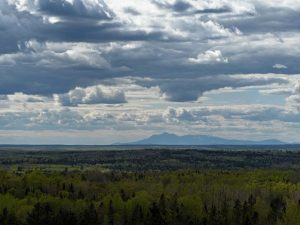
Mt. Katahdin, which translates to “Greatest Mountain” in Penobscot, is the highest mountain in the state of Maine at 5,269 feet.
(Photo by Clay Jenkinson)
As I drove up the eastern spine of tall Maine this week, I pulled over to gaze at Mount Katahdin.
Henry David Thoreau and two companions ascended Katahdin nearly to its summit in 1846. He loved its unsympathetic rawness: “This was that Earth of which we have heard,” he wrote, “made out of Chaos and Old Night. Here was not man’s garden, but the unhandseled globe. … Man was not to be associated with it. It was Matter, vast, terrific.”
From 27 miles away Katahdin took my breath away.
The photograph cannot do justice to the quality of light or the quality of the afternoon breeze in mid-May in America’s most tree-carpeted state. But you get the idea!
Sports, Lawn Care and Fishing at Karen's Diner - Waterville, Maine
 The counter of Karen’s Diner in Calais, Maine. That’s Karen on the left. (Photo by Clay Jenkinson)
The counter of Karen’s Diner in Calais, Maine. That’s Karen on the left. (Photo by Clay Jenkinson)Waterville, Maine, May 2024 — It’s a little early to draw many conclusions about the country’s mood, but this is what I have heard in a little more than two weeks on the road in America.
Most people I have met are just tired out. They are weary of the endless national narrative — our dysfunctional do-nothing Congress; the mutual demonization of each party towards the other; Trump’s narcissism and disruptions, Biden’s shuffling and verbal gaffs, two old men running for president that nobody seems excited about; Stormy Daniels and Hunter Biden; the perpetual crisis at the border; the fundamental intractability of things in the Middle East; the campus protests; the ongoing Culture Wars; the seeming futility of the west’s support for Ukraine; the flirtation with autocracy, including here in the U.S.
Etc., etc., etc., etc.
“That’s why the wife and I are out here,” one man told me as he grilled chicken at a KOA Kampground in Maine, “to tune all that stuff out. We’re just seeking our own happiness now. I know that’s probably bad, but that’s exactly how we feel.”
“A plague on both their houses,” another said as we gassed up our rigs at a giant service plaza in New Hampshire. “We just want it to end.”
When I asked people whether America is:
A: circling the drain
B: doing just fine
C: lurching on as always
Most began by saying, “Duh!” but they invariably stepped back and provided a more thoughtful answer: “We’ll get through this. We always do. There is more right with America than wrong with America, but our leadership on both sides is really letting us down right now.”
“I’m worried, but what are we going to do about it?” my server said at a lunch counter the other day.
This morning at breakfast at Karen’s Diner in Calais, Maine, sitting at the counter, I asked Karen what the coffee klatches of men (there were six at a nearby table) talk about when they come in a couple of times per week. “Everything,” she said with an affectionate grunt. “The political situation?” I asked. “No. I’m not ok with that. When I bought this place 18 years ago I told my husband there were two subjects we wouldn’t have people talking about in here: politics and religion.” Pause. “So, you know, sports, lawn care, the fishing season, Canada (just across the St. Croix River), tourists!”
I should immediately acknowledge that I’m not meeting a representative sample of the American people. In campgrounds — state parks, county parks, ma and pa RV parks, and KOA campgrounds — the people I meet are overwhelmingly white senior citizens with enough money and freedom to travel the country in comfortable RVs, some that cost $10,000 and some that cost $350,000, not to mention the splendid pickups that haul them. Most of the people I meet aren’t rich, but they are privileged.
The limitations of my observational lens came home to me yesterday when I went into a local museum in Calais, Maine, not far from the Penobscot Indian Reservation. On the registration desk, I saw a stack of “please take one” documents about Missing and Murdered Indigenous Women & Girls in America. And food pantries in every town or village I drove through. And plenty of rural shabbiness, which I take to mean rural poverty.

This, too, is America.
As I plugged in my Airstream last evening beside a lovely Maine lake, the man doing the same next to me (wearing an absurd and expensive mosquito net helmet) asked me what I was doing with whatever Listening to America is. “I’m driving around the country retracing John Steinbeck’s Travels with Charley journey, trying to listen to the mood of the country as we approach our 250th birthday,” I said. “I’m more concerned about the gnats,” he replied. “Look, we’re out here partly to get away from all that. We love America. But we’re worried. Mostly, we’re just sick of it.”
I’m only just beginning to listen to America. Still, the full picture will not likely emerge around the Kampfire, where a perky KOA employee in a yellow shirt is making s’mores to order.

A Visit With Author Jay Parini of Middlebury, Vermont
 Author, Jay Parini, talks with Clay about his book John Steinbeck: A Biography.
Author, Jay Parini, talks with Clay about his book John Steinbeck: A Biography.
Middlebury, Vermont — Last night I had a delightful interview (in the Airstream Rocinante) with Steinbeck biographer Jay Parini of Middlebury College in Vermont.
In his driveway.
Parini’s John Steinbeck: A Biography was published in 1995. It was, he said, his first biography. He was invited to write the book by Steinbeck’s third and final wife Elaine. She gave him unlimited access to Steinbeck materials and a list of scores of people he should interview.
Although we concentrated on Steinbeck’s 1960 Travels with Charley tour of America, our conversation was wide-ranging. Parini has written more than a score of books, including a critically acclaimed biography of the poet Robert Frost. His 2020 memoir, Borges and Me: An Encounter is being made into a movie. He has written eight novels, with subjects ranging from Herman Melville to the apostle St. Paul. He is an accomplished poet. At the moment I’m reading two of his books — his biography of Gore Vidal, Empire of Self: A life of Gore Vidal; and Promised Land: Thirteen Books that Changed America.
He’s a brilliant man and a superb writer. We had about 75 minutes together in the Airstream and then Jay and his wife Devon served me homemade pasta and fresh asparagus provided by a neighbor. Plus rhubarb pie!
Perhaps the most important thing Parini said about Travels with Charley is that it must be seen as “autofiction” and not mere reportage. In other words, Steinbeck organized, shaped, and indeed embellished his experience as he transformed something that happened in the autumn of 1960 into a minor literary classic. “This is what great writers do,” Parini said. “This is what we all do when we remember our experiences. This is the essence of storytelling.”
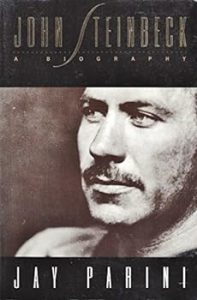
John Steinbeck: A Biography by Jay Parini
My goal is to interview as many Steinbeck experts as possible during my travels. So far I’ve had — in my rig — Professor Parini and also Bill Steigerwald, the author of an important investigation into “the real story” behind Steinbeck’s 1962 book Travels with Charley.
Parini was a friend of the late Gore Vidal. He guided the late Jorge Luis Borges around the Scottish Highlands. He debated Christopher Hitchens about the war in Iraq.
What an honor to spend an evening with such a humanist, writer, storyteller, and dedicated college professor.
Clay's Personal Cartographic Detail of the Steinbeck Journey Through New England

Clay’s personal cartographic detail of his Steinbeck journey through New England the last two weeks.
The Romance of America's Greatest Game: An Emotional Visit to the Baseball Hall of Fame

The National Baseball Hall of Fame in Cooperstown, N.Y.
Cooperstown, New York — When I bought my ticket Saturday afternoon at the National Baseball Hall of Fame, the clerk asked for my zip code — 58503. “Huh,” he said, “isn’t that where Roger Maris comes from?” I was about to say yes when a free-floating usher who had been standing 10 feet away jumped into my personal space and shouted, like a contestant on Jeopardy, “Fargo, but he’s not in here.” I pulled back a bit, shocked by the intensity of passion that this game generates, and asked why not. The interrupter looked at me with derision. “His stats just aren’t there. It was a one-off, and it doesn’t really count because there were more games in 1961 when he hit 61 homers. It’s still the Babe, man. Maris was great, but he doesn’t belong in the Hall.” The original clerk asked me who other great North Dakota Major League Baseball players were. I shrank away in shame.
It was going to be that sort of afternoon.
Among great baseball players not in the Hall of Fame: Mark McGwire (performance enhancement drugs, PED); Barry Bonds (PED); Sammy Sosa (PED); Roger Clemens (PED); Curt Schilling (what are regarded as “character issues”); Alex Rodriguez (PED); Rafael Palmeiro (PED).
I don’t know what I expected when I drove my Airstream into Cooperstown, New York. Having never really thought about it before (it is my first, but not my last, hall of fame), I had reckoned that Cooperstown would be a city of about 75,000 and the Hall of Fame would be a gleaming aluminum and glass one-story structure built or rebuilt in the 1990s. Turns out Cooperstown has fewer than 2,000 permanent residents. The Hall of Fame building was dedicated in 1939. It was constructed with rose-colored atom bricks (slightly smaller than typical) with a central three-story tower and two wings, right on Main Street, and without the acres of parking I had expected.
Cooperstown is a lovely village, exceedingly tidy and well-groomed. It has Victorian gingerbread houses and brick buildings everywhere on Main Street, about three blocks long. Virtually every building houses a sports paraphernalia shop or a sports-themed restaurant. My friend Russ, who has been there four times, says there are several outstanding restaurants in Cooperstown. These are the kinds of things he knows.
Big History in the Hall of Fame
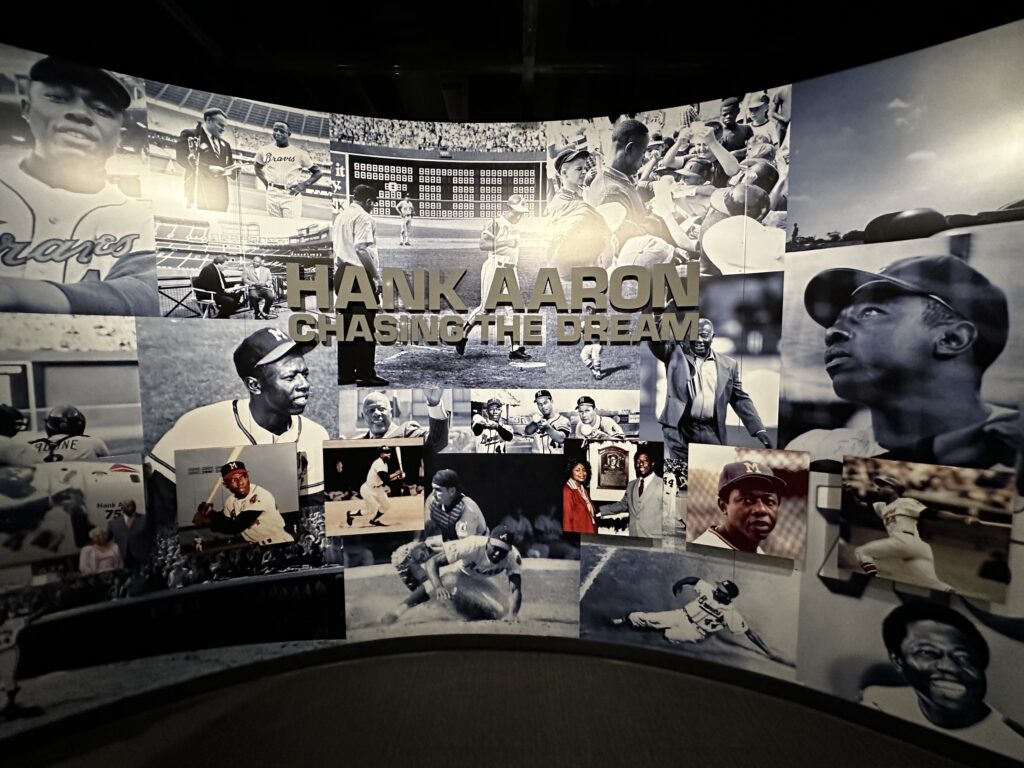
I suppose 200 people were working their way through the three floors of the Hall of Fame. It was very moving to see fathers with their wide-eyed 9–12-year-old sons high-tailing it from display to display, with the fathers explaining baseball history to their sons or their sons to their fathers. Seeing African Americans standing at attention before the panels dedicated to Hank Aaron and Jackie Robinson was equally moving. Jackie Robinson, who broke the color barrier in the Majors in 1947, is as important in the history of Civil Rights in America as Rosa Parks or James Meredith. Hank Aaron received vicious death threats couched in the vilest of racist language as he approached the home run record in 1973 and 1974. What’s the proper chorus for this sad fact of American life: “God shed his grace on thee?” or “A hard rain’s gonna fall?” Aaron hit his 715th HR on April 8, 1974 (Ruth topped out at 714 on May 25, 1935). Aaron ended his career at 755 in 1976.
Barry Bonds hit 762 home runs altogether, but in the minds of many, that doesn’t count since he was boosted by performing enhancing drugs.
A Black woman in a wheelchair sat quietly before a monument to Jackie Robinson, wiping away her tears.
Some of the white males who were visiting the Hall of Fame looked like overgrown boys locked in the last days of pre-adolescence. They were almost all alone. They were all dressed alike: shorts, a player jersey untucked, and a ball cap. They had all put on some poundage since their prime, and none of them seemed to have taken any exercise for a decade or more. I was surprised some of them weren’t wearing their old sandlot glove. They were there to worship and to re-fantasize their boyhood dreams.
Sports addicts are passionate people. Every few minutes, I happened upon two or three men having mostly friendly arguments about baseball stats and debating who was the greatest third basemen in the sport’s history, who is “terribly overrated,” who “changed the game,” and who would absolutely have been inducted if he hadn’t used steroids: “and he didn’t need to, for God’s sake, he was that good without any help from big pharma.” I’m glad to report that I didn’t hear a single argument over Pete Rose, one of the greatest players of all time: 4,256 hits (most of anyone), most at-bats, most games played, most singles. He won three batting titles, one MVP Award, two Gold Gloves, and was Rookie of the Year in 1963. But he gambled. He gambled on his own games. He’s barred from the Hall of Fame, but he mounts a campaign to be reconsidered every five years or so. He’s 83 years old now, and that was a very long time ago. Now that gambling has become an integral element of major league sports, I say put him in while he is still alive to take some late-life satisfaction. Still, you can get into a sports bar fight over this almost anywhere in America. The title of Rose’s autobiography, My Prison Without Bars, tells you what you need to know about his ordeal.
One of the two vertical “decision kiosks” asks you to “vote” about Rose. Results so far? 44% say “Those Games Are Tainted,” but 56% say “Gambling’s Impact is Overrated.”
Speaking of Roger Maris, for a short time, I listened in as a tall, thin man of about 70 threw a fit over the absence of Maris on the Hall of Fame list. He sputtered. He gesticulated wildly. He shouted in a low-key way. He said, “You watch, I’m going to go down there and demand to speak to someone in charge. This is an outrage. You wait; this will not stand. This is NOT ok.” His long-suffering wife nodded in the official spouse’s “yes, but calm down already” manner. He was virtually foaming at the mouth. I wanted to ask if he were a North Dakotan, but I reckoned it was better to move to another room.
Most of the girlfriends and wives were there because their men wanted to be there, and some seemed genuinely interested, but a few of them were super-fans, the kind who out-fan their men, scream at the television when the umpires make bad calls, and high five anyone in sight when things go well. Men outnumbered women 10 to one in the building.
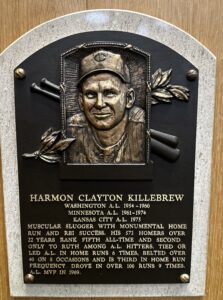
In the formal hall (of fame), I found the Minnesota Twins’ Harmon (“Harmless,” my grandfather called him) Killebrew in the 1988 class, Tony Oliva (2022), Jim “Kitty” Kaat (2022), and Rod Carew (1991). I suppose everyone who visits the Hall of Fame has a short list of must-see plaques and tributes.
Three or four times in the afternoon, I got choked up and burst into tears. Some of this is lost youth, and some of it is lost innocence. Once the asterisk started to attach itself in the record books to the careers of great players — think Barry Bonds or, in bicycling, Lance Armstrong — and Major League Baseball became yet another expression of the corrosive power of television on everything it touches, I quietly turned away. I haven’t watched the All-Star Game since 2002, when the game was called after 11 innings because neither team had any pitchers left in the bullpen. I’ll watch a bit of the fall playoffs depending on what else is going on in my life, and almost always a couple of games of the World Series if one of “my teams” is involved: the Dodgers, the Yankees, the Red Sox, the Cubs, the Mets, or the hapless Twins. But if it is Astros-Diamondbacks, I’ll watch a couple of innings and move on. The Astros’ 5′ 6″ Jose Altuve, with his Pete Rose zeal and his 5 o’clock shadow (maybe it’s seven o’clock), bugs me for some irrational reason.
The Greatest Moments in Baseball
At a special screen with a menu of the greatest moments in baseball, I watched Hank Aaron hit his 715th home run, and Ken Griffey, Jr. hit a home run on his first Major League at-bat. I watched a ball bounce off of Jose Canseco’s head (I think the correct technical term is noggin) and over the outfield wall (home run), which is even more delightful when you see Canseco giggling in the aftermath. Perhaps he regarded it as a standing rule double.
Twice, I watched a clip of Kirk Gibson’s walk-off home run in the 1988 World Series. Weird, isn’t it? I remember where I was when JFK was assassinated, where I was when the Challenger blew up, and where I was on 9/11, which makes perfect sense. Still, I also remember the evening when Gibson blew the minds of 55,983 fans at Dodger Stadium on October 15, 1988. I was living in Claremont, California, at the time. I had invited my English department friends Ray Frazer, Bob Mezey, and Brian Stonehill over to my small house to watch the game. Mezey was a fierce Dodgers fan. He had taken me to several home games that year. We chose my house because I had the best TV — an old color console set with a large picture tube. I made hot dogs for the occasion with all the fixings — plenty of beer. Bob liked only basic beer: Schlitz, Hamms, Grain Belt. We turned the sound off and listened to the immortal Vin Scully call the game on the radio. By the end of the ninth inning, with the A’s ahead 3:2, Mezey, who was something of a pessimist, reckoning that the game was over and the Dodgers would surely lose, was beginning to collect his things to go.
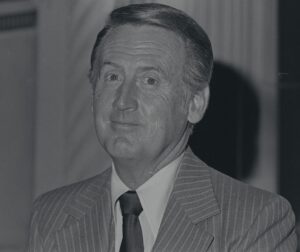 Vin Scully, long time Los Angeles Dodgers announcer. (UCLA/LA Times)
Vin Scully, long time Los Angeles Dodgers announcer. (UCLA/LA Times)
Then, one of the greatest moments, not just in baseball but in all of sports history, occurred. The Dodgers’ slugger Kirk Gibson was called in with two outs in the bottom of the ninth to pinch hit. He was in a severely injured state. As Scully put it, “he has two bad legs, a bad left hamstring, and a swollen right knee.” No one expected Gibson to play that night. Scully said Gibson was “so banged up he was not introduced, did not come out on the field before the game.” Scully’s sidekick, Jack Buck, said, “he almost has to talk to his legs to get anything out of them.” The crowd went wild when he came out of the dugout, though that ovation was nothing compared to what happened next.
It was game one of what turned out to be a five-game series.
Gibson’s at-bat went on for more than seven minutes. It unfolded like Shakespearean drama or the second iteration of Ernest Lawrence Thayer’s 1888 Casey at the Bat. If Hollywood had scripted the episode it could not have been finer. It was a perfect narrative as well as a perfect sports moment. Oakland’s Dennis Eckersley was one of the best closers in the business. He was extremely handsome and almost unbearably confident. Almost nobody ever got a hit against him when he was brought in for the last inning. Gibson was as gimpy as it is possible to be. He looked old at the plate, unshaved, and hunched over. He swung widely, almost desperately, almost convinced he would make an easy out.
Eckersley threw over to first base four times to keep the Dodgers’ Mike Davis from stealing second. Gibson was clearly having trouble swinging the bat. “He can’t push off, and he can’t land,” Scully said. “He’s shaking his left leg, making it quiver like a horse trying to get rid of a troublesome fly.” Gibson fouled the ball away several times, and Eckersley eventually threw three balls outside the strike zone.
So the whole game came down to one final pitch, Eckersley’s 14th of the at-bat.
And here’s the pitch:
Gibson swung awkwardly (almost like a cricket batter) and drove the ball deep into the right field stands. It was a walk-off home run with two outs in the bottom of the ninth. What could be better than that? The crowd went wild. Bob Mezey went nuts in my living room. The Dodgers’ dugout erupted. The chubby coach, Tommy Lasorda, lurched out of the dugout and “sprinted” toward home plate, gamely trying to jump in triumph a few times along the way. Scully was perfect: “In a year that has been so improbable, the impossible has happened,” he said. He added, “Now the only question was whether he could make it around the base path unassisted.”
Then Gibson, who was limping around the bases and favoring his right leg, rounded third and performed the greatest double fist pump in sports history. In fact, all subsequent fist pumps, including Tiger Woods’ superb version at the Masters in 1997, originated in Gibson’s 1988 moment of sports apotheosis.
“Look at Eckersley, shocked to his toes,” Scully said. “They are going wild at Dodger Stadium; no one wants to leave.”
In a 1995 poll, Gibson’s miracle home run was voted the “greatest moment in LA sports history.”
I cried openly as I watched the clip (for the 20th or 30th time in my life). What was I crying for, surrounded by strangers with far better baseball credentials than mine in the middle of the Hall of Fame? Well, partly for the “thrill of victory and the agony of defeat.” Partly for Gibson’s demeanor after he reached home plate, a mixture of ultimate triumph but not a little surprise. Partly, as Scully said, for the sheer improbability of the result. Partly because I had shared that moment with three of the best people I ever knew when I was young, and the world was all before me. Partly because 60,000 people were in true ecstasy together at a ball game in Los Angeles. Partly because Scully was the perfect sportscaster for that extraordinary moment of drama. I cannot imagine Harry Caray, Al Michaels, Joe Garagiola, or Mel Allen doing it as well.
In many respects, the Baseball Hall of Fame is lost on me. I haven’t stayed current with the game into the 21st century. I need to be there with someone who really still loves and follows the sport. I did not feel out of place, but I reckoned I was probably the most ignorant person in the building, like someone who lives for NASCAR suddenly finding himself in Britain’s National Portrait Gallery and recognizing only a handful of worthies — Princess Diana, Shakespeare, and Churchill — and bewildered by the rest. I gravitated to the little clusters of conversation throughout the building, hoping to learn from the “experts.”
The Amazing Museum Shop
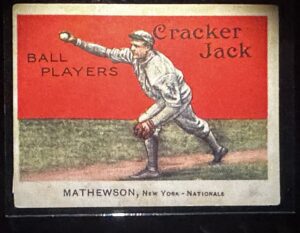
After a couple of hours in the museum, needing to hit the road, I browsed in the tremendous bookstore with its hundreds of titles. Then I moved on to the giant museum shop (the word “shop” does not do it justice) where I thought I would buy a baseball signed by Nolan Ryan or Mark McGuire for one of my friends. Still, when my application for a second mortgage got stuck in paperwork, I had to settle for a couple of postcards and a pack of cards honoring the Negro League. It was great fun to watch boys and girls of about 12 years old literally dragging their parents through the aisles to some cherished souvenir that the parents were almost certainly not going to buy for them. No such veto was available to the 45-year-old overgrown boys. Several of them spent a very large amount of money to obtain some treasured memento (a ball, a bat, a plaque, one of those matted and framed ensembles of an autograph, a beautiful photograph, maybe a three-dimensional object like a jersey or a glove). It was no different, except in net worth, from the New York lawyer at a Sotheby’s auction buying a Picasso drawing for an amount they couldn’t afford.
As I stood gazing at impossibly expensive autographed baseballs, the clerk, a 19-year-old man who looked as if he had just left an Eagle Scout meeting, asked me if I was looking for “anything in particular?” I said I was browsing. “What’s your team?” he asked. “When I was a boy, it was the Twins.” He took on a look of pity and condescension. Then I made things worse by invoking the name of my boyhood hero, Harmon Killebrew. “I’m afraid we don’t have anything for him, but if I remember, he was inducted sometime in the 1980s, and you can probably find his plaque in the Hall.”
Harmon Killebrew was a home run specialist (573) who hit 49 home runs in a single season twice, in 1964 and 1969. He ranks 12th on the home run list, just below Mark McGwire (583) and just above Rafael Palmeiro (569) and Reggie Jackson (563). Killebrew’s top salary came in 1973 at $105,000.
As I drove away from Cooperstown in my rig towards the Erie Canal, I determined to visit the NFL and NBA halls of fame and the Rock and Roll, Country Music, Cowboy, and others as I happen upon. But I doubt that the NFL or the NBA can bring me the same emotional satisfaction. There is something about baseball. Ken Burns, as always, was right. I lament what has happened to Major League Baseball, and I now usually confine my visits to bush league stadiums, where something of the original feel of baseball still prevails.
I’ve seen games in five Major League parks in my lifetime, and I’m about to sit through a White Sox game (against the Toronto Blue Jays) in Chicago with my friends Dennis and Russ. Russ really knows the game, as they say, and has contributed articles to several baseball books.
Meanwhile, come on, put Pete Rose in, the poor bastard.
Theodore Roosevelt and the Rough Riders at Montauk Point, New York- Video Dispatch

Montauk Point at the tip of Long Island. (Google Maps)
Assessing My Steinbeck Trip at Week Four
It has been about four weeks since Clay began retracing John Steinbeck’s Travels with Charley Tour. Shadowing the famous author’s 10,000-mile trek around the USA, Clay notes some advantages and disadvantages between his trip in 2024 and Steinbeck’s 1960 journey.
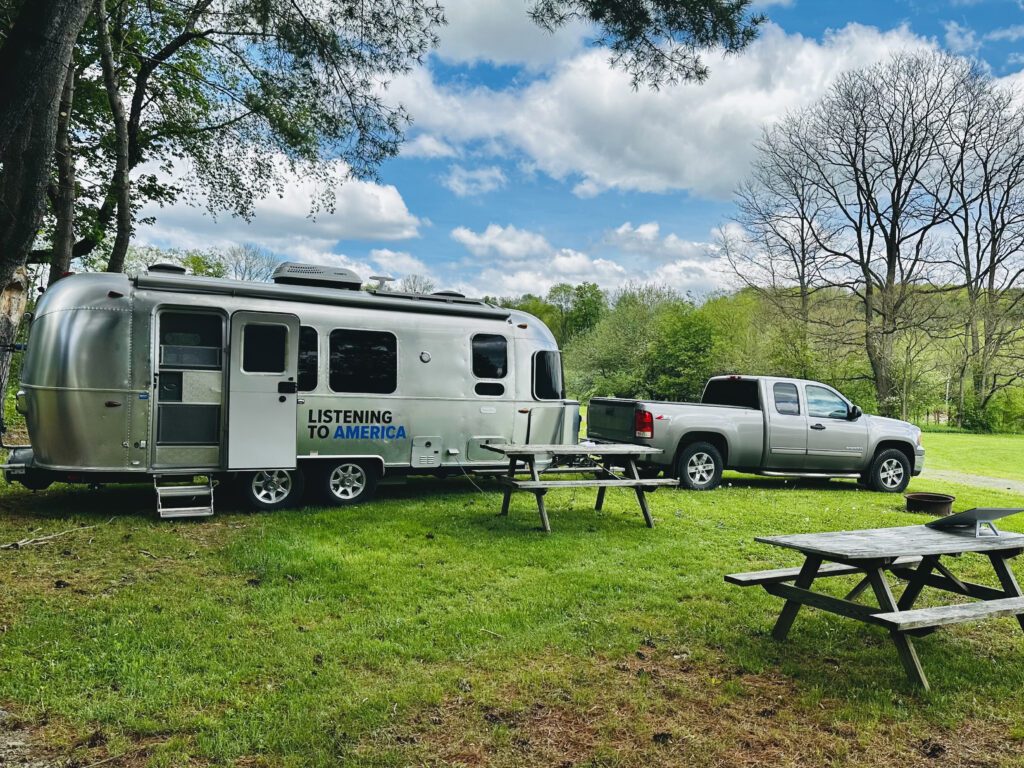 The Listening to America Airstream at a campground outside of Cooperstown, New York.
The Listening to America Airstream at a campground outside of Cooperstown, New York.
John Steinbeck stopped every week or so to reflect on what he had seen and experienced and what it signified about America or himself in 1960. I’m a month into my trip, somewhere in Ohio, vaguely on my way to Chicago, and with a bit of time on my hands, I thought I might summarize my sense of what is different in a journey of this sort today, in 2024, from a similar (but far from identical) journey in 1960. Here’s my preliminary report.
I have so many advantages over Steinbeck — all except transcendent talent.
Here’s a short list.
1. Air conditioning. Fortunately, he was traveling in the autumn, but we now have sophisticated climate control systems in our vehicles. When Steinbeck wanted to open the windows, he had to hand-crank them.
2. His seat did not recline. My grandfather had a 1957 I-H pickup. It held you upright, and the cushions were adequate. Over time, you could feel the springs beneath the fabric. My vehicles, including my pickup, have seats that can recline enough to make it possible to get a good night’s sleep. The pickup has electric seats and lumbar support, too.
3. Safety features. Back then, the dashboard was made of metal. There were no seat belts, shoulder belts, airbags, or emergency flashers. My father, otherwise enlightened, removed the seatbelts from our new Ford Falcon in 1964.
4. Steinbeck had power-assisted steering. That was the Beta or VHS tape phase of what would become true power steering a few years later. He reported being exhausted after driving his GMC pickup a couple of hundred miles. He actually did fairly ridiculous calculations of how much arm and foot muscle was expended in driving such vehicles.
5. There were no RV parks in his time. He often squatted on private property, which I would not dare to do today. I’ve had two run-ins with property owners on the Little Missouri River, and though both ended civilly enough, in both instances, I was required to acknowledge that I was trespassing and that one does not have the right to trespass on private property.
6. I have GPS and Google navigation. This matters much more in the East and New England than it would west of the Mississippi River. Steinbeck was frequently lost. He got lost on the final day when he ventured back into New York City over the bridge. But it is more than just the accuracy of GPS guidance. If you constantly fumble with a map or an atlas, you are not concentrating enough on the road. This always matters, but it matters most when driving a trailer or a truck camper.
7. The roads are infinitely better today than in Steinbeck’s time. I don’t mean the interstate highway system, which he decried, but I am certain that he would have used it and loved it when he was trying to eat up miles, as when he flashed across the Great Plains from Chicago to Seattle to meet his next rendezvous with his wife, Elaine. The non-interstates are dramatically safer today, with better and wider shoulders. Most secondary roads have passing lanes every few miles. Road signage is better now. When my family drove from Fargo to Fergus Falls, Minnesota, in the 1960’s on old U.S. 52, there were dangerous concrete curbs at the edges of the narrow roadway. And, as William Least Heat Moon explained in Blue Highways, the interstates have drawn 90% or more of the traffic off the secondary and tertiary roads, making them much safer and dramatically less congested.
8. Steinbeck had only a tube-type AM radio. Today, we have entertainment systems. He could have made a Steinbeck playlist if he had lived in our time. He liked to write to the sound of great symphonies. My pickup is ancient (2013), but it has AM/FM/XM and (because it is so old) a CD player, and I can plug it into my smartphone with a USB cord. I can remember traveling America with only an AM radio. There was a compensatory pleasure in spending time fine-tuning the radio to get the best signal available in what was (especially in the West) a media desert.
9. I’m trailing an Airstream, which would be like a five-star hotel by the standards of Steinbeck’s 1960 truck camper. He had a small chemical toilet. No shower. The barest of refrigerators, and they didn’t work well back then. He had to take down the dining table and convert that space to a bed when he wanted to sleep. I believe this caused him to stay in motels more often than he admits because setting up such a bed at the end of a long day is tedious. He reports that when he was in a hurry to get started the following day, he frequently just slept on the dining couch. The lights in a modern camper are excellent. I have his and hers reading lights over the bed. He often read by gas lantern.

Clay with Steinbeck’s custom made truck camper. The famous rig is on display at the National Steinbeck Center in Salinas, California.
10. Gas stations in 1960 were just gas stations. Perhaps they had a glass cabinet of candy. They were cramped. Usually, they had no more than two pumps. You could only fuel up with the help of a gas station attendant. Most people paid cash for fuel back then. If you wanted food, you had to find a grocery store or a ma-and-pa store. Today’s “fueling stations” are spectacular. You can cross the country today without ever going into a grocery store or a restaurant by selecting good plastic-wrapped sandwiches, boiled eggs, or individual packets of cheese, or — if you were starving — those hot dogs that have been slowly turning all day in the open air!
11. Fast food was in its infancy in 1960. There were just 228 McDonalds in 1960. Although Burger King had been created in 1953, there were only 274 stores by 1967, a year before Steinbeck’s death. The first Arby’s opened in 1964, Subway in 1965. If you were looking for fast food in Steinbeck’s time, you either found a locally owned drive-in or looked in cities for White Castle or Big Boy. Steinbeck railed against the coming of commercial homogeneity in America, but sometimes you need provender. The easy-on, easy-off fast food options of our time — as well as nationally franchised motel chains and fuel stations — make long-distance traveling easy and efficient. They have also helped to hollow out the downtowns of America, local restaurants, and regional variety. I can imagine Steinbeck preaching jeremiads against fast food, but I can also imagine him saying, “You know, the Big Mac is pretty darn good,” at least until he read Eric Schlosser’s Fast Food Nation.
12. Today’s audio devices are tiny, inexpensive, and — used properly — they can provide state-of-the-art audio recordings. He would have had to take a reel-to-reel tape recorder to capture sound or conduct interviews. If you wanted “video” in Steinbeck’s time, you had to have an 8mm movie camera. I know from experience all the things that can go wrong with 8mm cameras. I routinely record interviews on one of five devices (a teeny digital recorder, a handheld digital recorder, a recorder the size of an old transistor radio, a 35mm SLR camera, and my smartphone).
13. We have the internet, with everything that represents, makes possible, distorts, and damages.
14. When Steinbeck wanted to be in contact with his wife Elaine, he had to find a phone booth, work through an operator to place a collect call, and hope that Elaine was actually at their phone in NYC or Long Island. The calls would have been brief, even for a wealthy man like Steinbeck, because they were horrifically expensive then. When I was a boy, if we called my grandmother long distance over in Minnesota except on holidays, the first question she asked was if anyone was sick or dead. Today, I can text anyone I know, send instant photos or short videos, or speak with my daughter on FaceTime or WhatsApp.
15. Books on tape. I can listen to thousands of books, some of them read by outstanding professional voice artists. Steinbeck carried a just-published copy of his friend William L. Shirer’s massive Rise and Fall of the Third Reich in 1960, but he was too tired at the end of a long day to read much. Today, he could have listened to all 57 hours and 11 minutes of R&FoTR read by the outstanding Grover Gardner as he drove America. I am sure he would have done that if such a technology had existed.
16. Weather prediction has become a reliable science and art in our time. Not so, then. The other day, I heard a massive storm with tornadoes would rock the country’s central section. Fortunately, I was hundreds of miles north of the storm, but if I had been in its path, I would have found a giant concrete warehouse and parked adjacent to the northeast wall to wait out the trouble.
Probably, there are more advantages today that do not come readily to mind. Still, if you think about the accumulated advantage of all of this, you may wonder (as I do) in what sense this guy is actually retracing John Steinbeck’s 1960 Travels with Charley journey. Indeed. I wonder how much I would like this journey if I tried to travel in an identical truck camper (the chemical toilet alone makes me shudder), with its unreliable and primitive amenities and the rigor of driving a pickup with such rigid seats, no air conditioning, and only power-assisted steering; if I used only AM radio, called home from whatever’s left of phone booths, found few or no RV campgrounds, and drove on narrow hair-raising roads choked with slow-moving traffic.
I can report that I have been on the road for a month and have not stayed in any motel or hotel. I have yet to purchase a single fast-food meal. I have stayed in commercial campgrounds as seldom as possible. At least six times, I have been in state or county campgrounds without water or electricity. However, I regard staying in contact (at least with my website and social media platforms and my daughter in Great Britain) as so vital that we splurged on the Starlink system, which usually (but not invariably) permits me to contact the outside world.
So, What Were Steinbeck’s Advantages?
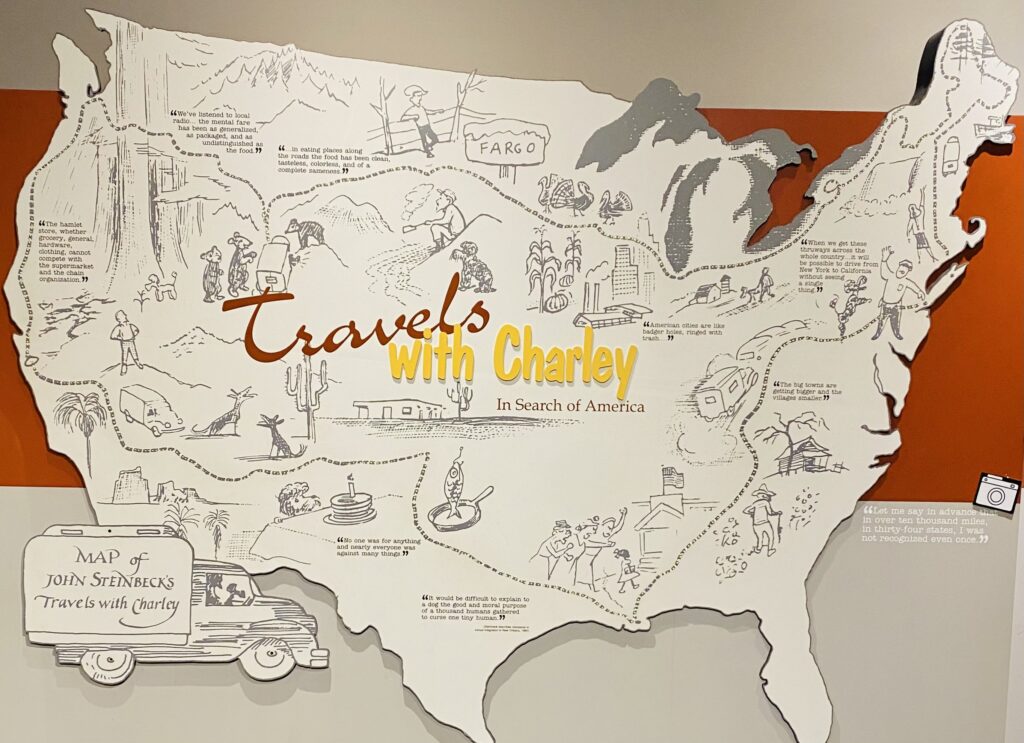
A map of Steinbeck’s trek around the USA on display at the National Steinbeck Center in Salinas, California.
The list is shorter but of extraordinary importance.
1. His pace was necessarily slower. The pace of America was dramatically slower then. He had a better opportunity to just amble along, passing through the center of countless villages, towns, and cities. If you want to reconnect with America, that pace is superior.
2. He wrote letters to communicate. Most of them went to Elaine back in New York. Since he does not seem to have kept a journal, they formed the basis from which he later wrote Travels with Charley in 1961. I lament the disappearance of the handwritten or typed letter. He took a manual typewriter with him. How often he used it is unclear, though my sense is not much. He preferred to write his notes and letters by hand.
3. America was more regional and varied then. The great homogenization of America was only beginning. He lamented the loss of regional accents, vocabularies, and ethnicities, but compared to today, the America of 1960 was a dizzying patchwork of localisms and regional diversities.
4. America today is more sophisticated and savvy, but there has been a palpable loss of trust and innocence. Even if you haven’t read Bowling Alone, you know the thesis: that voluntary associations and group activities have been eviscerated by all sorts of factors, including, of course, home entertainment systems. In most places, the Masons, Elks, Eagles, Optimists, and Kiwanis are either gone or on life support. People don’t know their immediate neighbors now. There has been an atomization in virtually all aspects of American life.
5. America has always had a potent politics, but the great paralysis had not set in yet in 1961. Steinbeck heard the presidential debates in 1960. John F. Kennedy and Richard Nixon were civil and respectful of each other. Aside from the John Birch Society, few Americans believed that people of different political persuasions threatened the future of democracy. Three times in three days of the last week, while minding my own business at my campsite, strangers have ambled over and within minutes spewed exceedingly angry opinions, all three assuring me that the 2020 election was stolen, that Joe Biden is only a figurehead and Obama is really running the country “from the basement,” that the people who did the rioting on January 6 were either Antifa or the FBI, and that there will be civil war if the Democrats steal the 2024 presidential election. I do not exaggerate. Because I am trying hard to listen to America, I have not done much more than ask a few careful Socratic questions, but none of these bothered to ask me what I think. So far, I have not been approached by a single Democrat, as far as I can tell, and the number of what might be called centrists has been negligible. Perhaps I am choosing the wrong campgrounds!
6. I have no Charley. Steinbeck rightly understood that everyone loves a good dog, with the possible exception of the governor of South Dakota. When he stopped, he turned Charley loose, and Charley served as his ambassador. It worked almost every time. Because I chose not to take a dog, I have no such advantage, and I believe it has limited my contact with people along the way. My daughter lived in New York for five years. She dog sat for a few weeks, and suddenly, scores of people in Central Park were friendly and eager to engage in conversation.
7. But the great difference is that John Steinbeck was one of America’s great writers. He had long since perfected his craft. Now 59 and in declining health, he felt he had nothing to lose or gain in the fall of 1960. He knew exactly how to shape a journey narrative — having written one of history’s best — and you can feel in the prose of Travels with Charley that he was at ease. He knew, too, that whatever he wrote would be read by hundreds of thousands and perhaps millions of readers in America and beyond. He says he traveled incognito, but this was not entirely so. When he needed to get special treatment, he could invoke his celebrity. As the author of Of Mice and Men and The Grapes of Wrath, he could instantly make doors open for him should he wish.

The Listening to America Airstream aboard a ferry, leaving Long Island for Connecticut. (Photo by Clay Jenkinson)
Still, I am having the time of my life. I am not homesick. My little private aluminum domicile is working admirably. The only errors are human. I’m seeing the vastness of America and appreciating American landscapes in the East and Midwest that I did not know very well, having always been a denizen of America west of the Mississippi River. Even at the University of Minnesota long ago, I lived on the west bank and only walked over the Mississippi River bridge to study Latin at 8 a.m. five days a week. I’ve had the opportunity to interview (on audio and video) three of the great John Steinbeck scholars in America — so far. I’ve listened to everyone I have met with an open ear and, I hope, an open mind. I’m struck by the friendliness of the people I’ve encountered, at least until the conversation strayed to “you know what.” Gasoline is not exactly cheap (except by European standards), but it is affordable. America has a very welcoming infrastructure for the wandering class. As I sit at a metal picnic table in central Ohio, the giant Denali rig next to me (currently uninhabited) has an above-ground sewer line with a series of slightly shorter plastic supports worthy of the Roman aqueducts. This keeps things moving to their ultimate destination. Most of the rigs I see have at least two bathrooms and three large-screen televisions, one deployed outside the rig for alfresco viewing.
I’m keeping in mind that Steinbeck’s journey was much more strenuous and difficult than mine, more romantic in essential ways, and perhaps more authentic. Having pounded the pavements of America for a month now, I have increased respect for the near-elderly man who undertook the big journey back in 1960. He was more truly out of contact for most of the adventure than I could possibly be in this America. No wonder he was sometimes lonely and desolate. If you are squatting on someone’s dairy farm in Connecticut, with no neighbor 20 feet away in either direction, without any immediate way of connecting with the broader world, you will feel profoundly alone at times. The fear that you will be awakened in the middle of the night by a curious or enraged property owner changes the equation dramatically. And, finally, I believe strongly that by 1960, Steinbeck had become so dependent on the unfailing love and solicitude of his third wife, in his most successful marriage, that his heart and often his mind were back at Sag Harbor, not in the “monster country” he was ostensibly attempting to explore.
I have two-and-a-half more weeks of Phase One of my great adventure. I miss my big library back home but little else, and because I am a moving target, my Amazon.com purchases have declined to a trickle. So something good comes of everything.
Pondering Thomas Jefferson at Niagara Falls
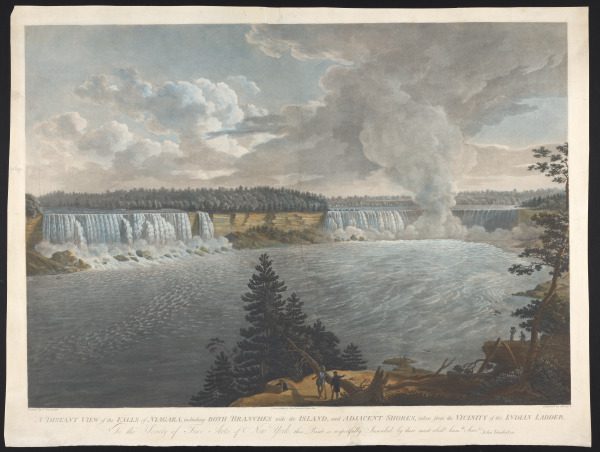 A Distant View of the Falls of Niagara by American artist, John Vanderlyn, 1804.
A Distant View of the Falls of Niagara by American artist, John Vanderlyn, 1804.
Niagara Falls, New York — Thomas Jefferson said it is worth a trip across the Atlantic to see Niagara Falls. Although he never got there.
Jefferson displayed two prints of Niagara Falls in his dining room at Monticello, both by the American-born artist John Vanderlyn. He ordered them in 1803 and began to display them in 1804 in the last year of his first term as president.
In Jefferson’s short list of reasons to visit (and paint) America were Niagara Falls, the Natural Bridge in Virginia, and the confluence of the Shenandoah and the Potomac at Harpers Ferry.
 Mrs. Maria Cosway
Mrs. Maria Cosway
In a love letter to the painter and musician Maria Cosway on October 12, 1786, Jefferson made the case for Mrs. Cosway and her husband Richard Cosway making a visit to the United States:
“Where,” he asked in the third person, “could they find such objects as in America for the exercise of their enchanting art? … especially the lady, who paints landscape so inimitably. She wants only subjects worthy of immortality to render her pencil immortal. The Falling spring, the Cascade of Niagara, the Passage of the Potowmac thro the Blue mountains, the Natural bridge. It is worth a voiage across the Atlantic to see these objects; much more to paint, and make them, and thereby ourselves, known to all ages.”
The Cosways never made it. Mrs. Cosway later made it clear that she was prepared to come — alone — to see the Sage of Monticello but by that point Jefferson had decided what happens in Paris should probably remain in Paris.
So she never saw the dining room at Monticello.
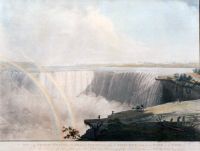 A View of the Western Branch of the Falls of Niagara by John Vanderlyn.
A View of the Western Branch of the Falls of Niagara by John Vanderlyn.
One of Vanderlyn’s depictions is entitled A View of the Western Branch of the Falls of Niagara, Taken from the Table Rock, Looking Up the River, Over the Rapids, the other A Distant View of the Falls of Niagara, Including Both Branches with the Island and Adjacent Shores, Taken from the Vicinity of the Indian Ladder.
Jefferson may also have known the illustration from the London-based Gentleman’s Magazine from 1851. You’ll recognize it here from the rope ladder Native Americans had built to descend to the base of the Falls.

An illustration of Niagara Falls from the English Gentleman’s Magazine, 1851.
Travel was difficult in Jefferson’s America and Jefferson himself was not an adventurous traveler. The closest he got was Albany, New York, which he visited with his closest friend and collaborator James Madison on their “botanizing tour” of New England in 1791. Albany is 325 miles from Niagara. Jefferson never saw the Great Lakes.
This was my third visit to Niagara Falls. I was in the company of friendly guides and while gazing at American Falls I met two sisters who were about to bicycle the entire length of the towpath of the Erie Canal. I was filled with envy.
Two Views of the Nightmare Road to Athens, Ohio
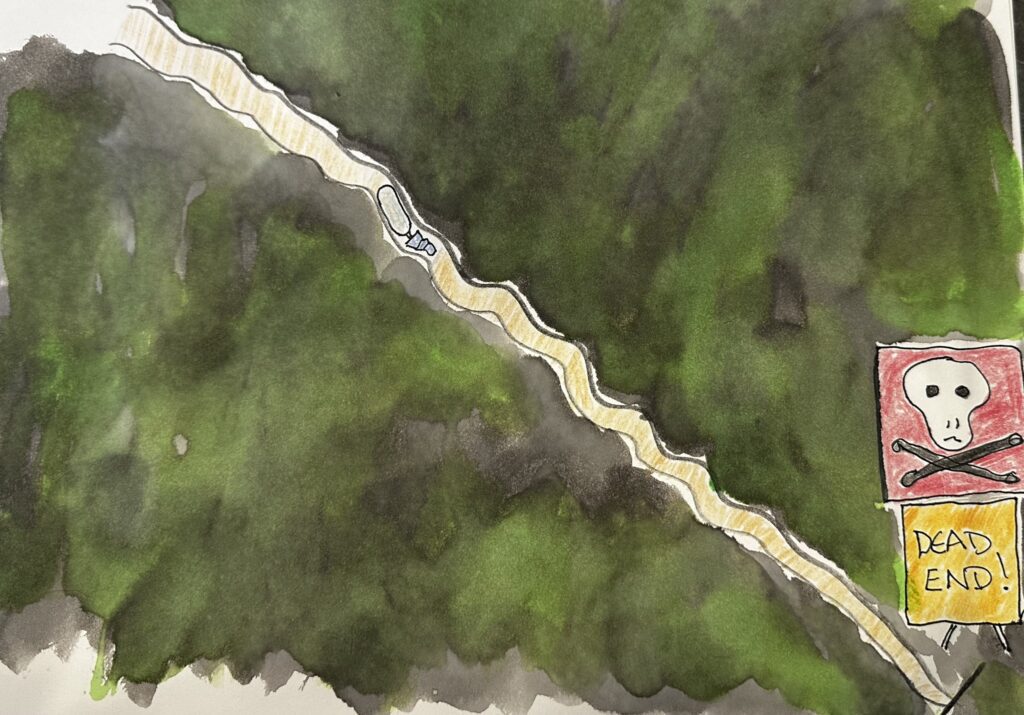
Taking a wrong turn on the way to Athens, Ohio, Clay, his pickup, and Airstream head down a narrow, steeply descending, unimproved road. Is there a way out? Or is this the end of the line for Clay’s Steinbeck journey? (Sketch by Clay Jenkinson)
Was it Google Maps that led me astray? Last week, on the way to Athens, Ohio, I took a wrong turn and wound up on a narrow, one-lane, broken asphalt and gravel road with a grade that the Ohio Department of Transportation would never approve of.
Once on the road there was no turning back, nothing to do but see what happened next. The “road” went on for a couple of miles, and deteriorated as I descended. I suddenly had a waking nightmare of reaching a washed out wooden bridge or a Dead End. There was absolutely no chance of turning around because the forest encroached and there were no driveways. Not even the U.S. Trucker of the Year could have backed up that hill given the grade and the disintegrating pavement.
For a moment I realized that this was the end of the journey and the end of everything. There is no AAA for this. It would take a couple of helicopters and some kind of Airstream diaper to lift me out. The only thing to do would have been to pour kerosine over the rig and the pickup and light a match.
I could hear strains of the theme song of “Deliverance” rising like the music at the end of a talk show segment. …
I had long since broken into a cold sweat. Somehow I bucked and slid at 2 miles per hour down to the end of the road and there was a left turn onto something like a real farm-to-market road.
I drove to the nearest truck stop and slumped over the wheel for a while.
I’ve provided two views of my situation here.
First, (see above) how it seemed as I reviewed my life and tried to compose a farewell note that exonerated me to the extent possible.

Mercifully, the narrowing forest route intersected with a wider farm road. Disaster averted! (Sketch by Clay Jenkinson)
Second, how it actually was.
I reckoned the rig would eventually be found like the green bus of Chris McCandless in Jon Krakauer’s “Into the Wild.” I’d gain a worldwide reputation for being the D.B. Cooper (D.B. Nincompoop) who disappeared into the wilderness 6 miles from the university town of Athens, Ohio.
Et in Arcadia Ego, (And in Arcadia I am.)
Clay drops in at Sagamore Hill, Theodore Roosevelt's Beloved Home on Long Island- Video Dispatch
There is no point in going to the eastern tip of Long Island to see John Steinbeck’s Sag Harbor without also stopping earlier on Long Island at Theodore Roosevelt’s home, Sagamore, at Oyster Bay. The house was closed the day I visited. Still, the grounds were open, which gave me time to wander the estate, imagine the hyperkinetic Roosevelt family in residence, observe TR’s home base without the usual press of visitors, and — for half an hour — sit in one of the rocking chairs on the veranda. Here’s my report.
Tortilla Flat: Steinbeck's Early Years
Steinbeck struggled against poverty and a sense that his career as a writer might never happen until he published Tortilla Flat. After that the money started to come and so did critical acclaim. He structured Tortilla Flat on the Arthurian legends but most readers did not recognize the parallels. Not much left of that landscape near Monterey today.

John Steinbeck by James Fitzgerald, 1935. National Portrait Gallery, Smithsonian Institution; gift of Mr. and Mrs. Edgar F. Hubert. © The James Fitzgerald Legacy Monhegan Museum of Art & History.
From this time forward Steinbeck became increasingly secure financially and his reputation grew until he was one of America’s best loved writers. Just a few years later he published The Grapes of Wrath, regarded by most as a top 10 novel in American history.
In many respects Steinbeck was at his artistic best when he wrote about the Monterey Peninsula and his native Salinas, California.
As I tour the country following his great 1960 journey, I find late echoes of his deep commitment to the economically marginalized Americans. He admired and championed the people who just want a little piece of the American dream and find it difficult if even possible to succeed.
John Steinbeck Among the French Canadian Harvest Gypsies
Clay visits Northern Maine on the trail of John Steinbeck’s visit with French Canadian potato harvesters, detailed in Travels With Charley.
 Steinbeck hosts a family of French Canadian potato harvesters in his truck-camper, Rocinante, while visiting Maine in 1960. (Illustration by Nate Calderone of Salida, Colorado)
Steinbeck hosts a family of French Canadian potato harvesters in his truck-camper, Rocinante, while visiting Maine in 1960. (Illustration by Nate Calderone of Salida, Colorado)
In my second week of travels, I drove up much of the length of Maine, because in 1960 John Steinbeck was determined to touch the roof of the United States before turning west, and I reckoned you aren’t really fulfilling the mission unless you follow his path.
When I was in central and northern Maine, I asked about “Canucks” or, more specifically, French Canadian potato harvesters. Everyone I met said you have to go all the way up to Fort Kent to have any chance to meet such people, and maybe not even then. When Steinbeck came through, Maine still ranked first in American potato production and automation had not yet eliminated the need for human laborers.
Maine is no longer the great potato producer it once was. Today, it ranks eighth after Minnesota, Colorado, North Dakota, Oregon, Wisconsin, Washington, and Idaho.
We don’t use the word “Canuck” anymore. Various dictionaries label it as “sometimes offensive,” “often derogatory,” or”considered by some insensitive.” It can refer to all Canadians but is more often used by eastern Canadians or French Canadians.
John Steinbeck had a chance encounter with a family of French Canadian potato harvesters during the first week of his transcontinental journey in 1960. He called them Canucks with no sense that the term might be regarded as unflattering.
At the end of a day of travel, Steinbeck parked his rig on the edge of what he called a lovely lake about 95 yards from a cluster of tents and trucks where the agricultural laborers spent their nights. He did a little lakeside laundry. When he smelled the odor of soup wafting in from their camp, he wrote, “I found myself thinking, ‘What charming people, what flair, how beautiful they are. How I wish I knew them.’ And all based on the delicious smell of soup.”
Steinbeck decided to make contact with them. As usual, he sent his French poodle Charley out as his ambassador, waited a few minutes, and then wandered over to reclaim the dog and apologize for any trouble he may have caused. The party consisted of three giggling girls, the family chieftain in the prime of his life, three wives, one pregnant, the elderly patriarch of the family, two brothers-in-law, and “a couple of young men who were working toward being brothers-in-law.” Plus, an unspecified number of children.
After some small talk about Charley’s birthplace in France, during which the French Canadians praised Rocinante (what they called his “roulette”), Steinbeck invited them to stop by later to look at his rig.
The great novelist bustled about preparing his camper cabin for guests.
The French Canadian family (never named) stopped by in the evening. Steinbeck invited them into the “cabin” and urged them to sit around his dinette table. I’ve been in Steinbeck’s camper (at the National Steinbeck Center in Salinas, California), and I can confidently declare that it must have been a tight fit. Here’s how he puts it: “Six people can squeeze in behind my table, and they did. Two others beside me stood up, and the back door was wrenched with children’s faces.” Counting the host, that puts nine adults in the little cabin, 10 if you include Charley, who was a very large dog.
Steinbeck served the adults beer.
He wrote, “After the [previous] night of desolate loneliness, I felt very good to be surrounded by warm and friendly but cautious people. I tapped an artesian well of good feeling and made a small speech in my pidgin type of French.”

In the conversation that followed, the family told their story in that congested cabin. They were migrant laborers. They crossed the border from Canada every year to harvest potatoes in Maine. The border authorities of both nations were friendly, understanding, and cooperative. Their transnational transits and paperwork were handled by a professional agent who took a small percentage of their pay for his services. Steinbeck, who knew something about seasonal laborers, wrote that wherever he had met migrant workers in America, “there has always been a contractor in the background to smooth the way.”
The family had a small farm in Quebec. Each year, they “came over the line to make a small nest egg. They even carried a little feeling of holiday with them.” All of the adults worked in the fields, and the children helped to the extent that they were able.
After a decent interval, when everyone had relaxed and the atmosphere seemed right, Steinbeck reached into a storage bin and produced a bottle of fine cognac. The “chieftain” John, who managed the family’s day-to-day affairs, passed the bottle to the patriarch, “and the old man smiled so sweetly that for the first time I could see that he lacked front teeth.”
Steinbeck poured. When his guests tasted the “particulier du Departement de Charente,” the cabin hummed with non-verbal sounds of pleasure all around. “The cognac was very, very good,” Steinbeck reported, “and from the first muttered ‘Sante’ and their first clicking up you could feel the Brotherhood of Man growing until it filled Rocinante full — and the sisterhood also.”
His guests predictably and properly refused seconds, but they quickly yielded and let Steinbeck refill their cups. Then Steinbeck wrote one of the best lines in Travels with Charley: “And the division of thirds was put on the basis that there wasn’t enough to save.” Occasional lines like this one make Travels with Charley such an endearing book.
Steinbeck realized he was experiencing a moment of magic in a far corner of the United States.
“And with the few divided drops of that third there came into Rocinante a triumphant human magic that can bless a home, or a truck for that matter — nine people gathered in complete silence and the nine parts making a whole as surely as my arms and legs are part of me, separate and inseparable. Rocinante took on a glow it never quite lost.”
A glow it never quite lost.
Shortly thereafter, the patriarch motioned everyone out of the camper: “Such a fabric cannot be prolonged and should not be. … They went into the night, their way home lighted by the chieftain John carrying a tin kerosine lantern. They walked in silence among sleepy stumbling children and I never saw them again.”
He never saw them again.
Verisimilitude
Travels with Charley recounts about a dozen major (and many more minor) encounters between Steinbeck and the people he met along his 11,500-mile journey in 1960. The first of the major encounters was with the Canuck family in northern Maine.

Clay sits at the table inside Steinbeck’s famous truck-camper, Rocinante, during a visit to the National Steinbeck Center in Salinas, Calif.
(Photo by Dennis McKenna)
Virtually all Steinbeck scholars now agree that there are some fictional elements in Travels with Charley. At the very least, there is now a consensus that some of the dialogue in the book was embellished as he wrote up his journey in retrospect, months after his return to New York. It is possible, too, that there are a few composite characters in the book. It is even possible that Steinbeck invented parts of or all of a few of the encounters. I doubt this, but it is possible. One end of the spectrum of critical opinion is occupied by the investigative journalist Bill Steigerwald, a determined and militant skeptic who gives credence to few, if any, of Steinbeck’s road encounters. The other end of the spectrum is represented by Steinbeck scholars like San Jose’s Susan Shillinglaw, who is, of course, aware that Travels with Charley is what is known as autofiction but who believes that there is substantial authenticity in the bulk of Steinbeck’s encounters.
At this point, every Steinbeck scholar (and readers interested in this exercise) must decide where they land on the spectrum. My view, which comes after repeated readings and rereadings of Travels with Charley, several close readings of Steigerwald’s Dogging Steinbeck, Jackson Benson’s relevant chapters in his massive 1980 biography of Steinbeck, the outstanding literary criticism of Steinbeck scholar Robert DeMott and biographer Jay Parini, and my own long, careful interviews with Steigerwald, DeMott, and Parini, all conducted on this national Steinbeck journey, is that the great majority of the encounters in Travels with Charley actually occurred, in much the way Steinbeck remembered them. That there is embellishment is undeniable. Travels with Charley is a work of literature, not objective reportage. As Steinbeck notes several times in the book, storytellers inevitably shape their experiences to give them coherence and narrative bite. That some encounters might have occurred elsewhere than reported in the book is quite possible. That several minor encounters and conversations picked up along the way may have been melded during the writing process into composite characters — consciously or unconsciously — is certainly possible. But I doubt Steinbeck invented anything in the book out of whole cloth.
I may be wrong. One of the fruits of a long, obsessive adventure like this, indeed one of the purposes of my journey, is to feel my way through his 1960 journey as it was reported in the book he published 18 months later; to let my journey enlighten my understanding of his. My mind is open.
The probability that the Canuck incident never occurred at all approaches zero. That it happened in precisely the way Steinbeck writes about it is unlikely. But I believe it happened, and here’s why:
- The encounter came early in the mission when Steinbeck’s energy and exploratory spirit were still high. He went on his journey to reconnect with the peoples of America, and at the top of Maine, he did so.
- The incident seems to have carried Steinbeck back to the mid-1930s when he traveled the Central Valley of California in his “pie wagon,” a panel truck formerly used to deliver bakery goods, to study the plight of the displaced Okies, and to provide help where possible. Here, at the other end of the country, was an economically marginal itinerant family, toiling together to eke out some modest prosperity away from their home across the border, and here — in his new pie wagon — was the American novelist who achieved his fame writing about a family in a similar, albeit more desperate, situation. These were, in a sense, French Canadian Joads. In a number of the episodes of Travels with Charley, Steinbeck seems to be hearkening back to themes of his earlier books. In some respects, Travels with Charley is a kind of summing up.
- Steinbeck tells us at the beginning of his book that he stocked up on a fairly serious volume and variety of alcohol precisely to be in a position to host parties in Rocinante. Here in potato country, it was his first real opportunity. One of his goals was to entice some of the people he met into his little aluminum den, hear their stories, and show them genuine hospitality. The success of his early Canuck and cognac party boded well for the transcontinental quest he had undertaken. Unfortunately, there would not be many such intimate evenings in Rocinante, but he had started the trip successfully.
- As usual, “the genius is in the details.” Because he did not have enough glassware to host so large a group, Steinbeck cobbled together “three plastic coffee cups, a jelly glass, a shaving mug, and several wide-mouthed pill bottles,” from which he “emptied their capsules into a saucepan and rinsed out the odor of wheat germ with water from the tap.” He made coasters out of “folded paper towels.” He had “picked a bouquet of autumn leaves and put them in a milk bottle on the table.” I ask of the Travels with Charley skeptics: how likely is it that Steinbeck made these particulars up? After he “set my cabin in order,” and fussed over all of these preparations, Steinbeck wrote,”It’s amazing what trouble you will go to for a party.” As far as I am concerned, this has the ring of truth and authenticity.
- Why would Steinbeck make this incident up? I ask this question of each of the major encounters in Travels with Charley: the Canucks, the Canadian border officer, the couples in the mobile homes, the itinerant Shakespearean actor in eastern North Dakota, the taciturn and the voluble ranch denizens of the North Dakota badlands, the closeted young gay man in Idaho, the four men he questioned about Civil Rights in the Deep South? What does Steinbeck gain by inventing this encounter with French Canadian harvest gypsies? What convincing argument can be made that he invented an encounter with potato pickers?
- Retracing Steinbeck’s journey in 2010, my friend Steigerwald became so disillusioned when he discovered that not everything in Travels with Charley happened as if recorded by a “Rocinante cam,” that he determined to prove that the whole thing was a sham and Steinbeck a fraud. Of this famous incident, he writes: “The extended family of Canucks jamming into Rocinante is a favorite scene in Charley. But like other favorite scenes in the book, it most likely never happened — certainly not in the protracted, theatrical way Steinbeck described. … My guess is [that this incident happened] only in his novelist’s imagination.” Later, Steigerwald concludes, “The more I learned about Steinbeck’s journey, the more obvious it was becoming that nothing in it could be believed.”
- Above all, Steinbeck was deeply moved by his evening with the shy potato harvesters, which had an innocence that carried him back to the most intense period of his creative life. The following morning, “I made a little sign on cardboard and stuck it in the neck of the empty brandy bottle, then passing the sleeping camp I stopped and stood the bottle where they would see it.” He drove away “as quietly as I could.” And he concludes the episode with two sentences that essentially guarantee the authenticity of the encounter: “There are times that one treasures for all one’s life, and such times are burned clearly and sharply on the material of total recall. I felt very fortunate that morning.” There is, I believe, no snarky answer to this.

Modern potato harvesting equipment. (Qingdao Demeter Agricultural Equipment Co)
Unfortunately, I had no such encounter with a French Canadian family in northern Maine. At any rate, it would have been impossible to replicate the magic. The agricultural and petrochemical industrial complex manufactures today’s potato harvester. And we are no longer a people much open to innocence.
I asked my friend, Nate Calderone of Salida, Colorado, to make one of his delightful and spirited illustrations in honor of the Canuck incident. (See top of story.) I find his work whimsical and deeply satisfying. I hope you enjoy his art as much as I do.
Back Home and Planning Phase Two of the Great John Steinbeck Tour of America
Clay returns home to Bismarck, North Dakota after traveling 39 days and 6,679 miles in the shadow of John Steinbeck’s great 1960 Travels with Charley journey.

Illustration by official Listening to America artist, Nate Calderone of Salida, Colorado.
Well, I’m home now for a few weeks, writing up my travels and planning Phase Two of the great John Steinbeck Travels with Charley tour of America, which begins in the second week of July.
Over the last 39 days, I traveled 6,679 miles or 171 miles per day. That’s too brisk. I will slow down on Phases Two and Three to about 150 miles per day to give myself more time to explore, read, write, reflect, and get more hiking in.
I spent time in 17 states: North Dakota, Minnesota, Iowa, Illinois, Indiana, Kentucky, Ohio, West Virginia, Pennsylvania, New Jersey, New York, Connecticut, Massachusetts, New Hampshire, Maine, Vermont, and Wisconsin.

Clay snaps a photo from the cab of his truck as he navigates the George Washington Bridge on his way to Long Island, New York.
I did some things not part of the Steinbeck itinerary in 1960. A short list includes Acadia National Park in Maine; Big Bone Lick, Kentucky, where Thomas Jefferson obtained his mastodon bones (though not by himself); the National Baseball Hall of Fame in Cooperstown, New York; the magnificent Field Natural History Museum of Chicago; Jack Kerouac’s grave and Walden Pond, both in Massachusetts; the Source of the Mississippi River and effigies of Paul Bunyan and his Blue Ox Babe in northern Minnesota; and the World’s Largest Sandhill Crane in Steele, North Dakota.
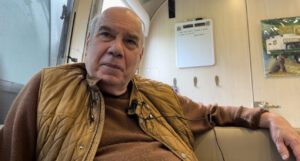
Steinbeck biographer, Jay Parini of Middlebury, Vermont.
Along the way, I conducted interviews in the Airstream with three important Steinbeck scholars: Bill Steigerwald of Bethany, West Virginia, the author of Dogging Steinbeck; Jay Parini of Middlebury, Vermont, a polymath and principal Steinbeck biographer; and Robert DeMott of Athens, Ohio, one of the finest Steinbeck literary critics, who signed for me a copy of his most recent book, Steinbeck’s Imaginarium. Taking my cues from Steinbeck, I offered each of them a snort of whisky in their coffee — they all declined!
I’ve taken a few thousand photographs along the way and several videos. And I’ve emerged as one of America’s unsung colored pencil and magic marker artists!! (Sung to the tune of Don’t Quit Your Day Job).
From the dining table in the Airstream, I have recorded three Listening to America podcasts, two with fellow Steinbeckian (and Lewis and Clark lover) Russ Eagle of North Carolina, and one with David Horton of Radford, Virginia, a frequent guest host on the LTA podcast.
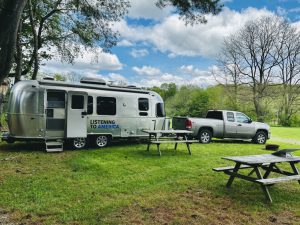
I stayed in state parks in Minnesota, New York, and Ohio, at seven or eight KOA Campgrounds, and at a fascinating series of locally owned (Ma and Pa) RV parks, a couple of them slightly sketchy. I stayed at the Ambassador East Hotel in downtown Chicago for two nights because Steinbeck stayed there with his wife Elaine in early October 1960. (It felt like cheating.)
And, alas, I had four nights in a lonely Best Western in Wapakoneta, Ohio, when my Airstream broke down. But — there’s always what I now call an “aluminum lining” in the storm clouds of travel — I was able to spend time at the Neil Armstrong Air & Space Museum in Wapakoneta.
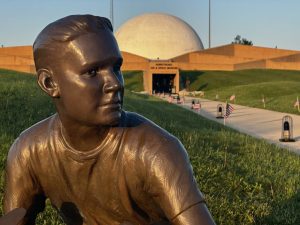
While the Airstream was getting repaired, Clay visited the Neil Armstrong Air & Space Museum in Wapakoneta, Ohio.
Still on my list of camp arrangements: I plan to stay in a few Walmart parking lots along the way, spend at least one night in Airstream-only campgrounds (to see how the other half lives), and try Harvest Hosts, wherein farms, ranches, wineries, etc., provide parking spaces for short stays. It sounds wonderful.
I’ve had dozens of encounters with people along the way, and all but two of them have been friendly. Keep in mind that I have spent most of my time so far in the heartland as I distill two very unscientific conclusions: 1) Most people are so exhausted from the political paralysis and the massive disruption of the Trump years that they declared that they were weary and worn down and one reason for their travels is to cut themselves off from the megaphone madness of our siloed cable “news” cosmos. 2) The Trump appeal, while diminished, is still very strong throughout heartland America.
It has been a wet spring on the eastern side of the Mississippi River. Now I understand why Ethan Allen called his insurgents the Green Mountain Boys. The eastern half of the United States is dramatically more forested than I had reckoned, and, as a plainsman, I sometimes found myself longing for the treelessness that begins at about 96 degrees longitude (the Minnesota-North Dakota border). It rained for parts or all of my days and nights for more than half of my Phase One journey.
Because of the LISTENING TO AMERICA logo on the side of my Airstream and the LTA ball cap I wore, I was asked about this project and my purposes at least a dozen times. Some people looked up Listening to America on the internet before approaching my rig in campgrounds or on the street. But the number one question I heard was, “Where’s your dog?”
Traveling alone, I’ve learned to hitch the trailer to my pickup with only a modest loss of time and dignity. And if you just leave me alone for a few hours, I can back the rig into a campsite! I witnessed husbands and wives bickering over backing up the rig in half a dozen states.
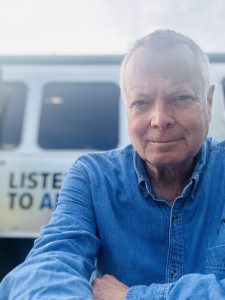
Clay with the LTA Airstream.
Only on three nights did I need to hook my Airstream up to a small whisper generator (it turns out to be a very loud whisper). I never let the gas in the pickup go below a quarter tank.
I was never lonely, but on a couple of occasions, I felt very alone out there, if that makes any sense. Give me a few books, connectivity, a laptop, and a caffeine source, and I can be happy and productive almost anywhere.
In short, I have thrived on the John Steinbeck trail. More to the point, retracing his 1960 odyssey has given me a new understanding of the book Travels with Charley and Steinbeck’s purposes and state of mind as he attempted to regain his creative mojo by exploring what he called “this monster country.”
Finally, I’ve been able to share with you several delightful drawings by my friend Nate C. of Colorado, with more to come.
I’m only just getting started, my friends, with two more Steinbeck phases to come. And next year, I’ll be retracing the entire Lewis and Clark Trail from Jefferson’s Monticello and Philadelphia all the way to Astoria, Oregon.
I’m using these historical and literary frameworks to try to make sense of America and its place in the world as we approach our 250th birthday on July 4, 2026. That’s my overarching purpose. I’ve been reading books that address this theme along the way, most recently Richard Slotkin’s A Great Disorder: National Myth and the Battle for America, and David E. Sanger’s New Cold Wars: China’s Rise, Russia’s Invasion, and America’s Struggle to Defend the West.
It has been a blast — or was that the fire in the battery box of the Airstream?
An Assortment of Clay’s “Sketches From the Road”



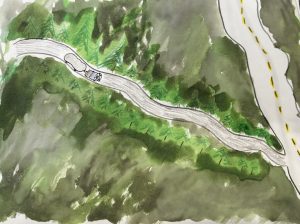


Sag Harbor to Bismarck: What I'm Learning About John Steinbeck and His "Search of America"
This spring, Clay departed Sag Harbor, New York, on an expedition to follow John Steinbeck’s 1960 cross-country trek immortalized in Travels with Charley. Recently, after completing the first phase of the trip, Clay reflects on what he’s learned about Steinbeck and how he now sees the story behind the classic travelogue.
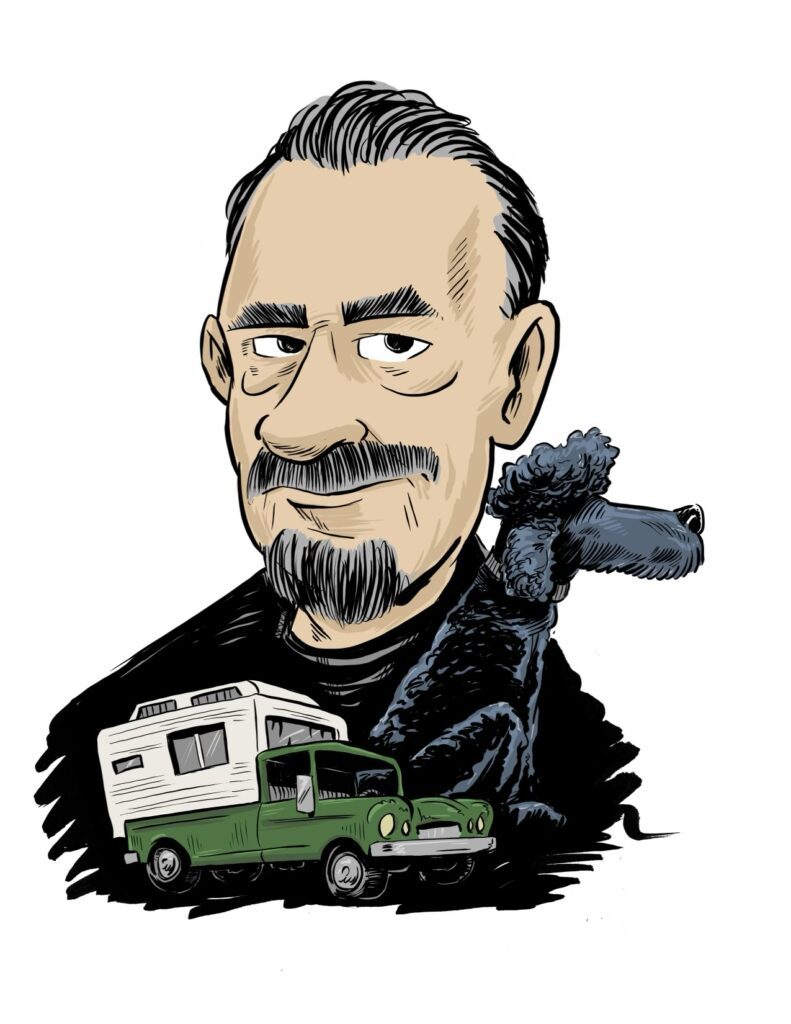
John Steinbeck, his dog Charley and his camper rig.(Sketch by Nate Calderone for LTA)
I’ve been repeatedly reading John Steinbeck’s Travels with Charley: In Search of America and books about Steinbeck’s 1960 journey. I’ve also been reading Steinbeck’s letters, especially those about Travels with Charley. I’m slowly reading through Steinbeck’s 30 books, and last, but not least, I have been retracing his great journey in a 23-foot Airstream. Phase One, Sag Harbor to Bismarck, has ended. I depart for Phase Two on July 5th.
So there’s a lot of Steinbeck percolating through my heart and head these days. It turns out there are things you cannot know about Travels with Charley without getting out there and experiencing it firsthand: pace, rhythm, the nature of the roads, easy drives, hard drives, the varieties of road fatigue, the massive size of the Great Lakes, and the unfolding of the American landscape as you venture slowly west. Dozens of passages in Travels with Charley clicked into place for me as I traveled the landscapes that inspired his prose.
Here are my preliminary conclusions. Some of them may seem critical but I don’t mean them to be. I’m merely trying to understand a journey that has come to play an outsized role in my own life as a traveler. We all need to accept the essential truth: the 1960 journey is not the same as the book John Steinbeck wrote about that journey. The 1962 book is not meant to be a literal and inflexible account of everything that happened out there. There are three John Steinbecks at play here. One John Steinbeck was a 58-year-old novelist who journeyed around the United States’ perimeter. There is a second John Steinbeck, the persona who appears in Travels with Charley and tells the story of his travels. There is a third, John Steinbeck, the author who wrote the book. The three Steinbecks have much in common, but they are not identical. Travels with Charley is a work of literary nonfiction with the kind of embellishments we all bring to bear on the stories we tell of our adventures. Some critics call it autofiction. Travels with Charley is, in some respects, a novel written about a journey. It’s no more true- or false – than Kerouac’s On the Road, William Least Heat Moon’s Blue Highways, or Robert Pirsig’s Zen and the Art of Motorcycle Maintenance, all of which are inevitably somewhat fictionalized accounts of journeys that happened in real-time.
While critics like Bill Steigerwald want to interrogate Steinbeck’s strict veracity, I’m more interested in Steinbeck’s creative strategies, first as a traveler and later as the narrator of those travels. In the twilight of his career, after many creative disappointments, Steinbeck wrote a lovely book about his travels searching for America with Charley, the poodle. For many, it is his most likable book. It is the most relaxed of the books he wrote, the most personal, with the least strain after literary greatness. I’m very interested in the differences between his journey and the narrative he constructed from that experience, but the differences don’t disgust or disillusion me. They tell us a good deal about John Steinbeck’s state of mind in the autumn of 1960, his state of health, his creative life, and his outlook on America as a man, a citizen, and a creative artist.
My preliminary conclusions.
First:
His heart wasn’t really in it. He says that he took the trip for several reasons: because he had lost touch with America, because New York City is not America, because he did not want to surrender to what Shakespeare called the “second childhood and mere oblivion” of old age; because he no longer understood what he called “this monster country;” because he wanted to prove to himself (and others, including his third wife Elaine) that he still had the right stuff.
So, Steinbeck commissioned an Indiana company to fashion a newfangled truck camper for him, and he decided to drive the perimeter of the United States alone. He engaged in extensive planning and provisioning. He defended his bold plans when those closest to him tried to talk him into something less strenuous, risky, and exhausting. He spent a lot of money to get precisely the traveling rig he envisioned. For weeks or months, he poured over maps and atlases.
But his heart wasn’t really in it. He confesses that as the departure date neared, he half-hoped he’d find a good reason to cancel his plans. “I didn’t want to go. Something had to happen to forbid my going, but it didn’t.” When he was finally underway on September 23, 1960, he acknowledged that he mostly felt “desolation.” He admits throughout the journey that he was lonely and missed his wife, Elaine. And though he did not quite admit it, it is clear that he missed the comforts of his wealth and celebrity — drinks with his literary and artistic friends, fine dining, luxury hotels, and access to all the fruits of life for a wealthy and privileged American author.
Steinbeck started strong in New England. He devoted 68 of the 214 pages (32%) of Travels with Charley to the New England portion of the journey, where he had some specific travel goals and had meaningful encounters with farmers, a submarine operator, a fire-and-brimstone preacher, and a family of French Canadian potato harvesters. In other words, a third of the narrative only gets him to Buffalo, New York (or Erie, Pennsylvania), and the remaining two-thirds has to take him all the rest of the way around the perimeter of the United States, at least four-fifths of the total mileage and most of the nation’s geography. As soon as the initial honeymoon period of the journey wore off somewhere on the shores of the Great Lakes, he pursued the rest of it with dogged determination not to quit but without the capacity to thrive.

Map of Steinbeck’s 1960 trek around the USA on display at the National Steinbeck Center in Salinas, Calif.
Second:
Steinbeck ran out of mojo long before he ran out of miles. As early as Monterey, when he had to turn the rig around and head back into the heart of America, Steinbeck confessed that he had run out of steam. “My impressionable gelatin plate was getting muddled,” he wrote. “I determined to inspect two more sections and then call it a day — Texas and a sampling of the Deep South.” That’s a slender agenda for a 3,000-mile journey back to New York. And did he really explore Texas? While crossing New Mexico, he realized, “I was driving myself, pounding out the miles because I was no longer hearing or seeing. I had passed my limit of taking in.” Texas is a mere blur. Most of the Texas chapter is about the “orgy” of conspicuous consumption he and Elaine enjoyed over Thanksgiving at a wealthy ranch in the Texas panhandle. There is nothing in Travels with Charley about the colossal size of Texas, the endlessness of trying to drive across it, its long border with Mexico, its great river system, or its many distinct bioregions. He did not explore Houston, Galveston, Dallas, Fort Worth, El Paso, or the hill country that gave America Steinbeck’s future friend Lyndon B. Johnson. Texas was just a vast amount of landscape that stood between Steinbeck and his homecoming. After New Orleans, he descended into a self-described road fugue state and just hurtled home robotically to New York, stopping only to get gas and a bit of food and to sleep for a couple of hours by the side of the road.
Travels with Charley is easily the most personal of his 30 books. And the most confessional.
Third:
Travels with Charley is easily the most personal of his 30 books. And the most confessional. Steinbeck was an exceptionally private man, and though he reveals his social and political convictions from time to time in his books, especially The Grapes of Wrath and East of Eden, he seldom calls attention to himself as the author of his works. He always insisted that the book is the thing the public has a relationship with, not the author, who is just a grumpy, obsessed person (often an SOB) alone in a room with blank paper or a ledger book open before him. Nothing to be gained from knowing what kind of pencil he preferred or his daily writing habits. He writes, “I have found many Readers more interested in what I wear than in what I do. In regarding my Work, some readers profess greater Feeling for what it makes [in sales and profits] than for what it says.” But in Travels with Charley, Steinbeck was in a confessional mood for the first time. He describes his physical appearance and his physiognomy, including his reason for having a beard. He acknowledges that he had experienced several serious health episodes in the previous year. He confesses that he frequently gets lost on the journey, especially in cities. He confesses that he has lost touch with the American people. Above all, Steinbeck confesses that “I hadn’t been thinking very well of myself for some years.” This is a significant sentence.
Fourth:
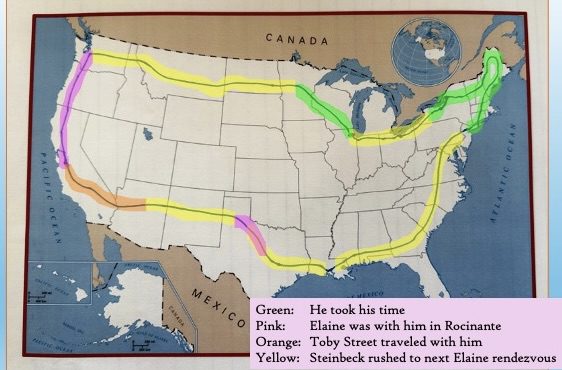
Retracing his journey (at any pace) immediately confirms how much of the time he was rushing from one Elaine encounter to the next. He rushed from Buffalo to Chicago to catch up with her. He lingered just a bit in the Midwest, from Chicago all the way to Sauk Centre, Minnesota, or even Detroit Lakes, but then he barreled across the Great Plains, the Rocky Mountain West, and the Columbia Plateau — to another encounter with Elaine in Seattle. After Thanksgiving in the Texas panhandle, once Elaine flew back to New York City from Austin, Steinbeck traveled as quickly as possible to New Orleans, briefly observed the racist women (the “cheerleaders”) who were protesting the integration of Louisiana’s schools, and then drove hell bent for leather back to New York. He admits the last of these forced marches. “My own journey started long before I left,” he writes, “and was over before I returned. I know exactly where and when it was over. Near Abingdon, in the dog-leg of Virginia, at four o’clock of a windy afternoon, without warning or good-by or kiss my foot, my journey went away and left me stranded far from home.” He confesses now that “I bulldozed blindly through West Virginia, plunged into Pennsylvania and grooved Rocinante to the great wide turnpike. There was no night, no day, no distance. I must have stopped to fill my gas tank, to walk and feed Charley, to eat, to telephone, but I don’t remember any of it.”
If you take out an atlas of the United States and do the math while tracing Steinbeck’s itinerary, you immediately realize that he raced across the bottom of the Great Lakes to Chicago. He raced from the North Dakota border to Seattle. He raced from Austin to New Orleans. And then he raced home. That leaves New England, a bit of the Midwest, the Pacific Coast Highway (with Elaine at his side), and arguably the road from Salinas, California, to Flagstaff, Arizona, as sections of the journey in which he took his time.
Fifth:
Like the great French traveler Alexis de Tocqueville before him, Steinbeck recognized that the American people are restless. In his classic study Democracy in America (1835), Tocqueville wrote: “An American will build a house in which to pass his old age and sell it before the roof is on; he will plant a garden and rent it just as the trees are coming into bearing; he will clear a field and leave others to reap the harvest.” Steinbeck makes the same point: “Could it be that Americans are a restless people, a mobile people, never satisfied with where they are as a matter of [natural] selection? The pioneers, the immigrants who peopled the continent, were the restless ones in Europe.”
 Steinbeck was fascinated by mobile homes and mobile home parks he saw in his travels. (Photo by Clay Jenkinson)
Steinbeck was fascinated by mobile homes and mobile home parks he saw in his travels. (Photo by Clay Jenkinson)
Steinbeck was fascinated, possibly even obsessed, by the mobile homes and mobile home parks he first saw in his travels. He was so curious that he accepted dinner invitations from several couples who lived in mobile homes. They both told him their stories and extolled the economic benefits of mobile home living. He was impressed by the efficient floorplans of such mobile homes, their storage space, and the panoply of modern appliances. And you could just pick up and move!
Thanks to my own trip, I now understand why Steinbeck was obsessed with mobile homes. They are everywhere in New England, particularly Maine, and not so much concentrated in trailer parks as scattered individually all up and down Maine’s blue highways. The phenomenon continues 60 years later to catch the attention of all visitors.

The mistake Steinbeck made in 1960 was to overstate mobile homes’ mobility and fail to recognize how important the recreational vehicle (RV) would become as a better symbol of American mobility. Theoretically, anyone who owned one could pick up stakes quickly and have the mobile home hauled to another part of the country, but this rarely happens. Once they are settled on their foundations and the deck and other enhancements added, they seldom ever move again.
Today, RVs exhibit mobility, and some of them are larger, grander, and more luxurious than the best mobile homes of 1960. However, in Steinbeck’s time, there were few RVs and very few RV parks in the United States. The RVs of the time were modest and basic by today’s standards. Many RVs are more spacious and luxurious today than most people’s homes. It is not at all uncommon to see a dozen or more RVs the size of luxury buses, rock star buses in a single RV park, with several bathrooms, slide-outs, full bedrooms, a “home” theater, and four or five television monitors, one of which deploys outside from a compartment on the side of the rig.
Because there were so few RV parks in his time, Steinbeck frequently … well, squatted. He simply turned up a promising side road, found a level spot, and bedded down for the night. On several occasions, he was confronted by a concerned or angry property owner or his agent. On such occasions, Steinbeck was gratified to have Charley with him, for though Charley was, Steinbeck assures us, a pacifist and a coward, he could roar like a lion when a stranger approached Rocinante, and his bark was bigger than his bite — by magnitudes. Once a landowner confronted Steinbeck, the usual pattern was to apologize, offer to move, and then invite the stranger into the camper for a compensatory cup of coffee, which morphed on most occasions to coffee graced by a dollop of whiskey. In the end, Steinbeck was invited to go ahead and spend the night, and, on one occasion, the next morning, he and his antagonist went fishing together.
I wouldn’t be comfortable squatting on anyone’s private property these days. It’s a different time. And when push comes to shove, I can’t say I’ve won the Pulitzer Prize for Literature! We, the RV warriors of America, are fortunate to have lots of options today — RV parks of all sorts; Harvest Host, in which you get to spend a night on someone’s winery or ranch or dairy farm; and, of course, truck stops and Walmart parking lots.
Sixth:
“I must confess to a laxness in the matter of National Parks. I haven’t visited many of them.” – John Steinbeck
Steinbeck was surprisingly uninterested in museums, historic sites, scenic wonders, and the national parks. He drove Maine but did not slow down to explore Acadia National Park, established in 1919 during the Woodrow Wilson administration. Acadia is Maine’s only full-on national park. It finds no mention in Travels with Charley. When he stopped at Niagara Falls, which Thomas Jefferson insisted was worth a trip across the Atlantic to see, Steinbeck wrote only this. “Niagara Falls is very nice. … I’m very glad I saw it because from now on, if I am asked whether I have seen Niagara Falls, I can say yes, and be telling the truth for once.” This is different from a rousing appreciation of one of the wonders of North America.
Steinbeck wrote, “I must confess to a laxness in the matter of National Parks. I haven’t visited many of them.” He explained that he was not interested in “the deepest canyon, the highest cliff, the most stupendous works of man and nature.”
On his journey through Montana, Steinbeck dropped down briefly to Yellowstone, the first and, in the minds of many, the greatest of America’s national parks. Steinbeck characterized it as a “wonderland of nature gone nuts.” He reiterated his casual indifference to scenic wonders. He declared that Yellowstone National Park was “no more representative of America than is Disneyland,” and he admitted that he only diverted from his beeline to Seattle out of “fear of my neighbors. I could hear them say, ‘You mean you were that near to Yellowstone and didn’t go. You must be crazy.” He concluded, “I would rather see a good Brady photograph than Mount Rushmore.” Ok, then. Point made.
Earlier in his transit of Montana, Steinbeck made a side trip to visit the Little Bighorn Battlefield. He gave it one short paragraph. “We made a side trip to pay our respects to General Custer and Sitting Bull. … I removed my hat in memory of brave men, and Charley saluted in his own manner but I thought with great respect.” In other words, Charley lifted his leg and peed on the battlefield. And then they drove on.
I had only really registered Steinbeck’s indifference to these places once I began to retrace his journey. As I neared my home state of North Dakota, I diverted about 50 miles from Frazee and Detroit Lakes, through which he passed, to see again the source of the Mississippi River at Lake Itasca in Itasca State Park. The source of one of the world’s greatest rivers gets no mention in Travels with Charley. Itasca State Park, established on April 20, 1891, is not only Minnesota’s oldest state park but the second oldest state park in the United States. It held no allure to Steinbeck, who pressed on from Detroit Lakes to Fargo because “Fargo to me is brother to the fabulous places of the earth, kin to those magically remote spots mentioned by Herodotus and Marco Polo and Mandeville.” Whoa. Herodotus and Marco Polo? After this buildup, Fargo could only disappoint — and it did. What he encountered was not the Silk Road or the Hanging Gardens of Babylon, or even the hitching posts and Wells Fargo freight wagons of the Old West, but a town “as traffic-troubled, as neon-plastered, as cluttered and milling with activity as any other up-and-coming town of 46,000 souls.” After seeing nothing impressive or special about Fargo, Steinbeck traveled a few dozen miles on old U.S. Highway 10 and stopped at a roadside turnoff “to lick my mythological wounds.”
Seventh:
Although Steinbeck made a big deal about the need to travel incognito across America, lest his fame distort the conversations he sought with average Americans, I believe he revealed his identity several times. When he arrived many hours too early at the swank Ambassador East Hotel in Chicago and was told that he’d half to wait until check-in time, he managed to persuade the hotel staff to let him spend the interim resting in a room recently vacated by a traveling salesman, but not yet serviced by the housekeeping staff. Steinbeck had been driving much of the night. He was tired and grungy. Nobody likes to arrive at a hotel and be told your room is not ready. In his book, Steinbeck tells an amusing story — he informed the hotel clerks that until his room was ready, maybe he’d lounge like a vagrant in the lobby, splay out, and doze off in one of its plush chairs, surrounded by his “luggage,” which he says consisted of a cardboard box he found in the garbage can and tied with fishing line. At that point, the staff scrounged up a temporary room for him. It is hard to believe that Steinbeck did not play his celebrity card on this occasion. If ever there was an instance on the journey when it would be advantageous to reveal his true identity, this was it. At the beginning of the episode, he wrote, “I think I am well and favorably known at the Ambassador East.” That sentence probably governs the entire episode. Which is more likely that Steinbeck maintained his anonymity and played his vagrancy card to get a temporary room at the Ambassador East or that he told the management, “Look, I’m John Steinbeck, touring America for a book I’m writing, and (sotto voce) I’m traveling incognito because it’s important that I’m not recognized. Can you help me out here?”

Elaine and John Steinbeck in 1959. (Martha Heasley Cox Center for Steinbeck Studies, SJSU)
When Steinbeck and Elaine arrived in San Francisco in November and checked into the luxurious St. Francis Hotel, he decidedly did not travel incognito. He permitted himself to be interviewed by San Francisco journalists, including Herbert Caen, one of the most prominent newspaper columnists on the West Coast. How did they know he was there? When he returned to Monterey, another interview, and he hung out at some of his old haunts with some of his old cronies from the Cannery Row days. When Steinbeck caught up with Elaine a few weeks later in Amarillo, they celebrated Thanksgiving at an ostentatious ranch (just this side of a dude ranch) owned by prominent Texans in Elaine’s social circle. There is nothing incognito about that.
I’m guessing that Steinbeck was very seldom, if ever, recognized as he traveled America. It was a time when photographs of authors were neither widely circulated nor widely recognized by the public. In addition, it’s always hard to recognize someone when they appear entirely out of context. Steinbeck usually wore a sailor hat east of the Missouri River, a Stetson west of the river. It would have been quite improbable for someone to say, “Hey, aren’t you the guy who wrote the Grapes of Wrath?” But on those very few occasions when Steinbeck wanted to be recognized, he was not, I think, averse to playing the famous author card.
Eighth:
Steinbeck said a journey of this sort had to be made alone. “Two or more people disturb the ecological complex of an area. I had to go alone and I had to be self-contained.” He was indeed correct. If Elaine and John Steinbeck had traveled America as a couple, it would have been a much different journey, a much less romantic quest, and a much less interesting book. But how much of the time was he really alone? He spent a number of days in Chicago with Elaine. A couple of weeks later, Elaine flew out to Seattle to meet him for a few days, and when he resumed the journey, Elaine was at his side in the truck camper until San Francisco, Monterey, and Salinas. After Elaine flew home to New York, Steinbeck asked his old friend Toby Street to join him on the trip’s next leg. Street was with him until Flagstaff, where he announced that he had had enough. Elaine met Steinbeck in Amarillo, and she was at his side as he drove from Amarillo to Austin. Steinbeck’s detractor, investigative journalist Bill Steigerwald, estimates that Elaine was with John about 40% of the time.
Charley is not only delightful in himself but also the source of most of the delight in the book
Ninth:
Charley, the giant poodle, is essential to Travels with Charley’s success. Remove Charley, and the book will make for a pretty thin gruel. I’ll write separately about the genius of making Charley a full-blown character in the book, with tons of personality, a great sense of timing, and a truly rich capacity for comedy. For the moment, know that Charley steals the show. He dominates the narrative with his French elan, anthropomorphic wit, and insouciant air of superiority. I’m sure the actual aging poodle added materially to Steinbeck’s pleasure on what was otherwise a lonely and often desolate journey around the United States. However, the enormous presence of Charley in the book may be the result of some literary enhancement. As he wrote Travels with Charley in the winter and spring of 1961, I believe Steinbeck realized that both his journey experience and his narrative of it were both a little thin and even a little tedious (a long essay on the ingenious mobility of mobile homes, an occasional rant about plastic wrappings for food, dishes, and toilet seats, the deepening homogeneity of American life), so he devoted more space to Charley, who thus emerges as the most interesting personality in the book. It would be fascinating to distribute two versions of Travels with Charley to two sets of readers: one in which Charley joins Steinbeck in his travels, and the other where the poodle stays back in New York with Elaine. I very much doubt that Travels with Charley would have achieved its status as a literary classic had it not been for the presence of Charley, the gap-toothed vociferator of “ftt,” a creature of timely and meaningful coughing fits, who reads Steinbeck’s mind and bends it to his will, and who decides to forgive Steinbeck “in a nauseatingly superior way” for putting him in a kennel for a few days.
Charley is not only delightful in himself but also the source of most of the delight in the book. We love dogs, especially dogs with personality and whimsy. Charley lightens the tone, reveals Steinbeck as a man of genuine sympathy, and — oddly enough — the great dog humanizes the travelogue.

John Steinbeck with his dog Charley.
Some Conclusions:
None of this is meant to find fault with John Steinbeck, certainly not to diminish the great literary achievement of Travels with Charley. Writers shape the raw material of their experiences into compelling stories. Steinbeck needed us to think that he was alone most of the time. He wasn’t. Steinbeck needed us to believe he spent most of his nights in the camper. It’s impossible to know how many nights he spent in motor courts, cabins, and hotels, but it is clear that he spent far more nights in commercial accommodations than he would have us believe. Steinbeck needed us to believe that he (a well-known American writer) could shed his fame for three months and wander unrecognized through America. It’s a very charming conceit. It is likely not entirely true.

Above all, Steinbeck did not want us to know that he spent much of his time with Elaine. That would spoil the romance of the story. In the original manuscript (now at the J.P. Morgan Library in New York City), Steinbeck provides a more accurate account of how much of the journey Elaine participated in. But most of that material was wisely excised during the editing process.
I have learned all these things by taking Steinbeck and Travels with Charley on the road. As intellectual historian Yuval Harari says, we have our experiencing self and then our narrating self, and though they overlap, they are not identical. Anyone who expects Travels with Charley to be a punctiliously faithful account of Steinbeck’s fall 1960 journey — and blames him for anything in the book that could not survive strenuous fact-checking — does not understand the nature of literary creativity.
The greatness of Travels with Charley is in Steinbeck’s relaxed writing. In this late-career book, Steinbeck lowers his guard more than he had ever done before. No matter what actually happened out there between September 23 and mid-December 1960, Steinbeck wrote a lovely, whimsical, quirky, informal, wry, and ironic book in which he confesses a great deal about what he had previously walled off as private. He does not attempt to strain for literary effect. From the book’s opening passages, he makes us want him to succeed in his lonely journey around America. We embrace the image of a distinguished American writer in khakis, a plaid wool shirt, and a ship captain’s cap reading after dark by kerosine lamp in his snug camper after he warmed up a can of chili con carne with an unusually intelligent and enterprising dog draped around his feet. I know few individuals who are not drawn to the romance of envisioning an eminent writer silhouetted with Charley behind the yellow light of his camper’s windows somewhere under the trees, sipping a snort of bourbon, traveling the whole of America in search of meaning.
It’s the relaxed Steinbeck, writing relaxed prose, that makes Travels with Charley so wonderful.
And Charley.
Grasslands Renaissance on the Great Plains

Dan O’Brien, author, falconer and regenerative rancher, founded Wild Idea Buffalo Company in 1997. (Photo by Clay Jenkinson)
Dan O’Brien and his business partner Jill O’Brien (his former wife) live in one of the most beautiful places in America — in the Cheyenne River valley south and east of Rapid City, South Dakota. Their enterprise — the Wild Idea Buffalo Company — and Dan’s excellent books drew me there in mid-June. I’ve been reading his books for a long time, and from afar, I have been fascinated by their experiment in grass stewardship. I knew they host tours, but I was shy about visiting.
That was a mistake. They welcomed me into their world far beyond my merit. Jill had sent careful driving directions, so I didn’t get lost, but you do drive 20-some miles on gravel (this was fresh gravel) to get there. Dan’s house is in a draw, and as far as I could tell, the steep road down to his driveway is deliberately left a little adventurous, probably to make pilgrims earn the experience. I loved it.
We had dinner in Jill’s studio, perched on the western edge of the Cheyenne River valley. She’s a nationally acclaimed cook. The meal was exquisite, as was the rhubarb sauce on the ice cream as things wound down. Braised chuck roast, mashed potatoes, fresh asparagus, hot bread. Prosecco and very good wine. And the conversation was as good as the meal.

Jill O’Brien, business partner in Wild Idea Buffalo Company.
These are highly enlightened, well and deeply read, culturally omnivorous people, living in a magnificent place in the middle of nowhere and using their creative energies to regenerate the American grasslands, or at least their modest parcel of it. At dinner, we talked about Theodore Roosevelt, John Steinbeck, Henry David Thoreau, Jack Kerouac, Willa Cather, what happened at Wounded Knee, and William Hornaday (the man who saved the buffalo — with important help from others).
Dan O’Brien is the author of something just under 20 books. The one that brought him fame was Buffalo for the Broken Heart: Restoring Life to a Black Hills Ranch (2001). My next read will be his fictional account of the Pine Ridge Indian agent Valentine McGillycuddy, who is one of my fascinations. McGillycuddy was at Fort Robinson when Crazy Horse was killed. McGillycuddy offered to try to intervene during the Ghost Dance controversy. He argued that the U.S. government should just let the Lakota dance themselves out and that by sending in the military, the U.S. was making a potentially tragic mistake. He was right.

Dan O’Brien is the author of just under 20 fiction and non-fiction books, including Buffalo for the Broken Heart.
After supper, Dan, his partner Emily, and I drove around the ranch to smell the ozone awakened by a small but impressive thunderstorm that drifted over from the Black Hills during dinner. We rode in an open ranch ATV. It was just this side of chilly — in other words, perfect. The sky was washed and the grass hills were unusually green at the end of a wet spring. The quality of light was exquisite.
It’s not clear what the O’Briens’ neighbors think of them, but I know there is a relatively narrow range of eccentricities that most of America’s ranchers are willing to accept. In some quarters, the idea of running bison on prime cattle range is regarded as wrongheaded or even threatening, and complicated regeneration practices sound like hippy stuff.
The proof of O’Brien’s regenerative practices is in the … grass.
Dan picked me up from their guest cottage the next morning at 6:30 a.m. (I’m sure he thought I was a slacker.) We drove along slowly in his ATV through two or three gates, where I jumped down to open them and shut them after he drove through. It was a perfect morning. The grass was higher than the wheels of the ATV. He brought along an old-school thermos with coffee so black that it made you shudder on the first two sips. On our left, the Pine Ridge Indian Reservation, including the Stronghold, where the Lakota danced the Ghost Dance in the weeks before they were massacred by the remnants of the Seventh Cavalry on December 29, 1890. On our right, Black Elk Peak, the highest point between the Rocky Mountains and Europe. It was formerly named Harney Peak — named back when we celebrated the army officers who dispossessed Native Americans of land.
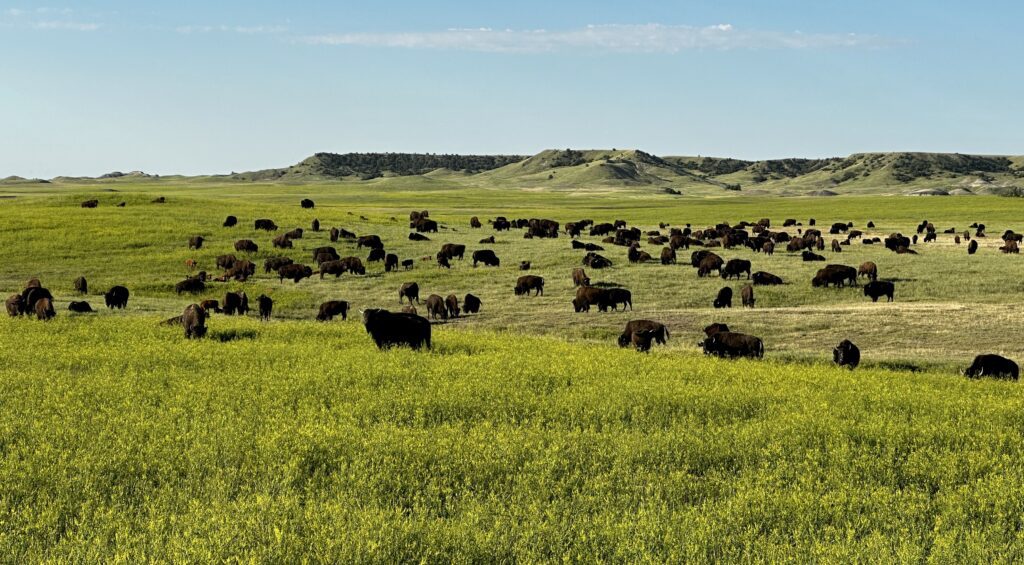
Over beyond a couple of swales and swells, we finally found the buffalo, some 800 of them, placidly eating grass, standing around, drifting a little now and then, the usual occasional rebuffed attempt by one sad male to mount cows. Dan shut off the ATV. The buffalo were entirely relaxed. A few of them nosed up within a couple of feet of the open cab. We saw a buffalo daycare facility a little ways away, with a few strong females watching over a dozen red calves. I had no idea. Dan had the confidence of a beekeeper amid swarms, and I took my confidence from him. Only once did the buffalo jump away when my 35mm camera “thucked” when I took a photograph. I apologized.
We sat there for most of an hour, sipping coffee, trading stories and perspectives, but I mostly just wanted to learn from this remarkable man. O’Brien doesn’t want to be romanticized. What they are doing in the Buffalo Gap region of South Dakota is hard work against considerable odds and some opposition for much less profit than the equivalent Angus ranch would produce. Because the buffalo are humanely raised and butchered — not merely trucked off like gold on the hoof to a commercial abattoir — the Cheyenne River Buffalo Ranch is more labor intensive than average. It’s hard work, and — compared to the dominant corn-petroleum-feedlot-industrial-complex — it’s a negligible part of the grasslands economy. But Dan and Jill believe what they are doing is a: intrinsically important, b: deeply soul satisfying, and c: a possible template for change on the Great Plains.
Regenerating the Great Plains
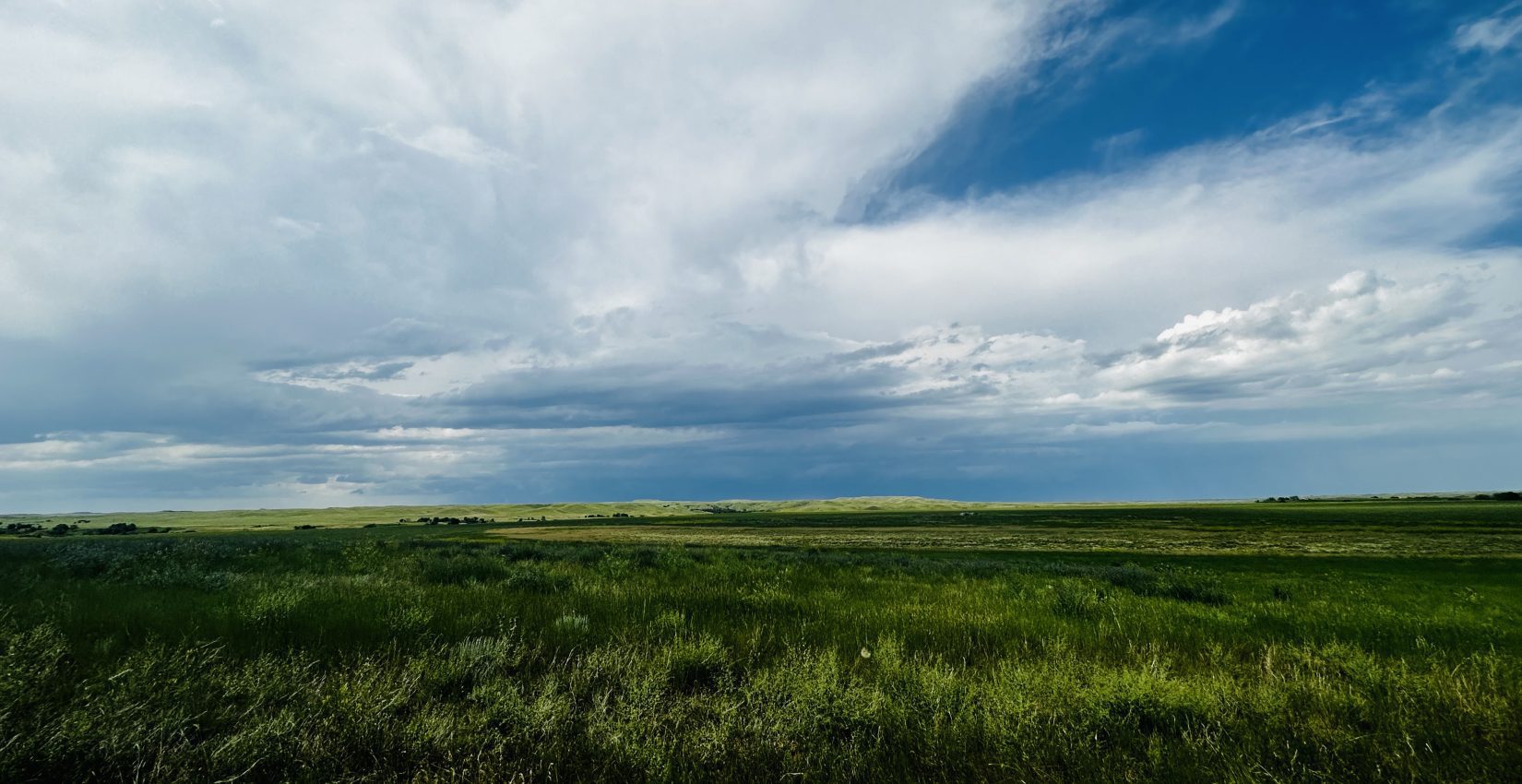
So, what do we mean by regenerative? Something like this. Most of the grass you see on the Great Plains was introduced from Eurasia well more than a century ago. Some of it came inadvertently, a stray seed in the bottom of a bag of flour. Still, some was deliberately introduced by well-meaning busybodies, thus reinforcing — once again — the “law of unintended consequences.” The invasive species choked out native grasses. They don’t provide more nutrition per square foot than native grasses. They are biological bullies. Restoring the native grass is exceedingly expensive (where is the Farm Program when you need it?), time-consuming (years, maybe decades), and the seeds one needs are relatively hard to get at any price anyone but Ted Turner could afford.
Meanwhile, the grasses of the Great Plains have been severely over-grazed until very recently (and still in some pockets). Thus the soil health is not great. It may seem insane for white settlers to have replaced native grasses that have evolved on the plains over millions of years, which supported what the writer Dan Flores calls the “American Serengeti” — buffalo, prairie dogs, coyotes, wolves, pronghorn antelope, elk, two varieties of deer, grizzly bears, falcons, hawks, and eagles, and widely dispersed human communities that had found a way to thrive in this place sustainably. We displaced most of those beings, including Native Americans, plowed up as much land as possible, and then watched an estimated 1.2 billion tons of soil blow away forever during the Dust Bowl years. During a Congressional hearing in Washington, D.C., in March 1935, elected representatives walked outside to view a dust storm that had traveled all the way from the Great Plains. The New Deal helped to stop the carnage: Soil Conservation Districts, Shelter Belts, the Civilian Conservation Corps, County Extension Agents.
Even so, nobody can argue that the grass of the Great Plains today is as healthy as it was in 1805 when Lewis and Clark wandered through. Dan and Jill O’Brien are not alone in their quest to restore the flora and fauna of the Great Plains, but they have won great respect, including international respect, for their exemplary practices.
They raise buffalo for the market. They supervise the butchering of every critter in a mobile truck that is fitted out not to replicate the factory conditions of America’s huge slaughterhouses. The O’Briens sell the meat (order at wildideabuffalo.com). The buffalo hides go to Portugal where they are made into high-quality boots. They sell some of the buffalo skulls; most are repurposed in an environmentally responsible way. They host tours. And Dan gets some royalty checks for his books. But it’s mostly about psychic income. As Jill said over dinner, “Everyone here has a side gig.”

O’Brien’s is dedicated to regenerating the natural ecosystem of the Great Plains. (Photo by Clay Jenkinson)
Here’s the part of what they are doing that blew my mind if I may use a technical term. Dan said the buffalo help restore the native grasses. Just how is a little unclear to me. He said the native seeds are still in the ground after all this time and all they need are the right conditions to recover. And when this is done right — via buffalo grazing, not pesticides — the grasslands begin to regenerate. Properly managed, the native grasses start to overcome the invasive species. It sounds mystical, but I’m sure there are reliable evolutionary explanations. A cow is not a buffalo. A buffalo is not a cow. They eat the same stuff, but they work the land differently. Perhaps it is not beyond the realm of possibility that the buffalo know what they want to eat and have the ingenuity to make sure it can grow again! The Lakota, Cheyenne, Mandan, Hidatsa, Crow, and Blackfeet regarded the buffalo as sacred. Who are we, who regard cattle as commodity and grass as fodder, to think we know better?
I wasn’t at the ranch very long — not long enough. But I know how to get there now, and Dan and Jill invited me back to observe and perhaps help out when they are butchering.
And there is more. Among other things, Dan O’Brien is a falconer. That instantly gets my attention. The art of falconry dates back to at least 2000 BCE in Mesopotamia and probably much longer. You can find references to it in one of the oldest pieces of world literature, the Epic of Gilgamesh (ca. 1500 BCE). Homer’s Odysseus is said to have brought the art of falconry back to Ithaka and Greece at the end of the Trojan War. Falconry was the avocation of Elizabethan aristocrats (and today’s Saudi princes). We had a long discussion about falconry in Shakespeare. One of my heroes, Sir Richard Francis Burton (1821-1890), published a masterful book called Falconry in the Valley of the Indus in 1852. I’ve observed the superb falconry program at the U.S. Air Force Academy, thanks to my old friend Hal Bidlock (aka Alexander Hamilton, I’m sorry to say). I want to see Dan work the birds.
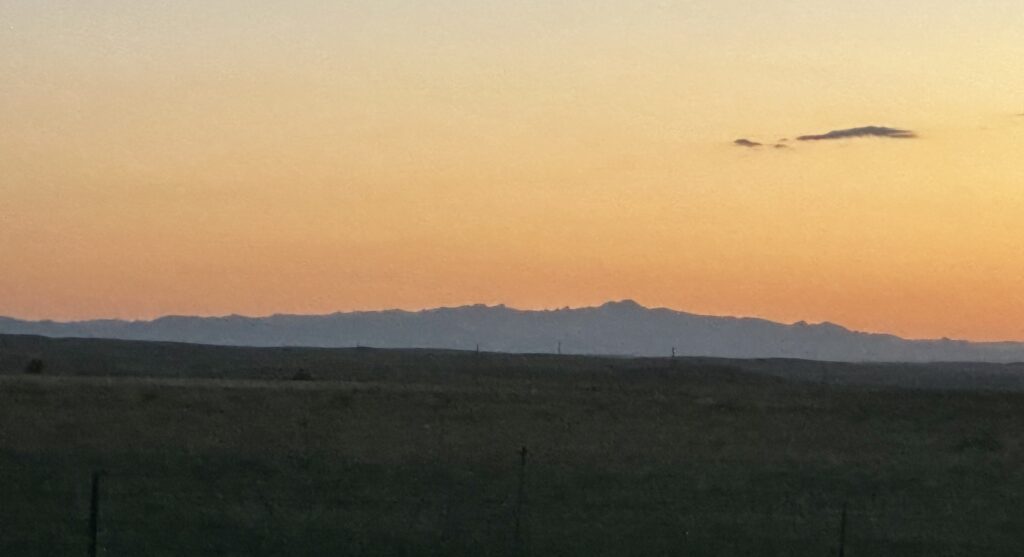
My goal in Listening to America is to get out from under the echo sphere of cable media and the surface discourse of polarization and rage and search for America where it percolates. I believe millions of people are doing good and creative things all over what Steinbeck called “this monster land,” tens of thousands or hundreds of thousands of people engaged in cutting-edge and game-changing initiatives like the O’Briens. I want to cheer up about America. I want to remind myself — and you — that major media is a dangerous distortion mechanism that exaggerates the ways we disagree and ignores the geographic, political, economic, and cultural “commons.”
In other words, America is better, healthier, and less divided than it seems when your lens is FOX or MSNBC.
Learn more about the Cheyenne River Buffalo Ranch and Wild Ideas “beef.”
Book a tour and buy Wild Ideas products.
You can find a complete list of books by Dan O’Brien in the usual places. I recommend:
- Buffalo for the Broken Heart: Restoring Life to a Black Hills Ranch
- Wild Idea: Buffalo and Family in a Difficult Land
- The Contract Surgeon: A Novel (about Valentine McGillycuddy, see above)
- Great Plains Bison
- Equinox: Life, Love, and Birds of Prey
- In the Center of the Nation: A Novel

John Steinbeck and Me in Beach, North Dakota
John Steinbeck spent the night of October 12, 1960, in Beach, North Dakota, just a few miles from the Montana border. He was about to fall in love with Montana.
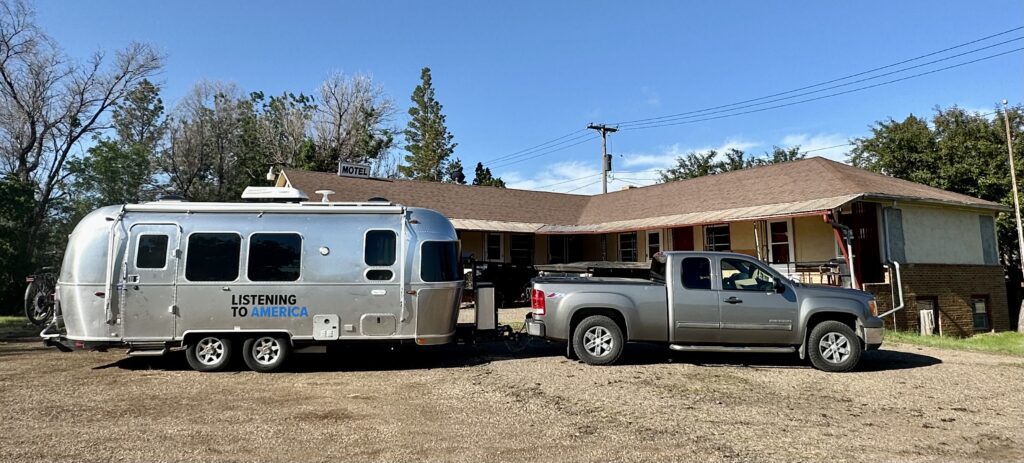 Clay’s LTA rig parked out front of the now defunct Westgate Motel, in Beach, N.D. where Steinbeck spent the night on his 1960 cross-country trek.
Clay’s LTA rig parked out front of the now defunct Westgate Motel, in Beach, N.D. where Steinbeck spent the night on his 1960 cross-country trek.In homage to Steinbeck, I spent night one of Phase Two of my national John Steinbeck Travels with Charley tour in Beach, even though it is only 158 miles from my home in Bismarck.
Today, Beach has a population of 981. In 1960, the population was 1,460. Ten years earlier, it had topped out at 1,461. North Dakota has scores of towns with a population of under 1,500 — and falling.
Thanks to the investigative work of a reporter named Bill Steigerwald — often mentioned in my Travels with Charley dispatches — we now know that Steinbeck almost certainly stayed at the Westgate Motel on the main drag of Beach on the night of Columbus Day 1960.
The Westgate is defunct. A local rancher and developer named Mark H. is gutting it inside with the plan to transform it into a 21st-century Airbnb sort of place. He generously permitted me to park my Airstream in the motel parking lot for the night.
Steinbeck wrote a letter to his wife, Elaine, on the little desk in his room. He reported that he had begun the daylong transit of North Dakota on old U.S. Highway 10 at 6 a.m. “I get a little tired, particularly tonight,” he wrote. “The roads were very rough and the wind high.” That certainly sounds like North Dakota!
“I’m staying in a motel called the Dairy Queen,” he wrote. “Reason? The only public telephone in forty miles. The Dairy Queen has a large, beautiful tub and I’m going to get into it almost at once.” Steinbeck may have been confused, or maybe he was making a joke, but there never was a Dairy Queen motel. He was merely identifying the Westgate by way of the Dairy Queen across the street.
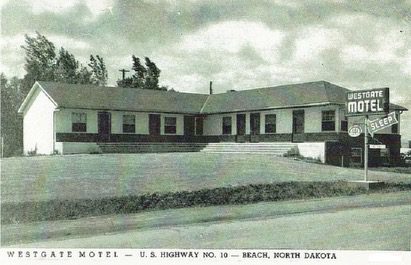
Steinbeck wondered out loud in his letter why the town is called Beach. At first glance, it seems like a perfectly absurd name since Beach, North Dakota, is 1,076 miles from the Pacific Ocean, 1,978 miles from the Atlantic Ocean, and 2,172 miles from Hudson Bay. As they say, “There ain’t no beach in Beach.” Steinbeck didn’t have internet access, of course, and although he was aware of the outstanding WPA guides available to individual states, he did not include any of the volumes in his traveling library. Thanks to revolutionary tools that were unavailable in 1960, we can immediately learn that Beach was named for U.S. Army Captain Warren C. Beach, who led a team of railroad surveyors through Dakota Territory in 1880.
Not that you really want to know anything about W.C. Beach — yet another obscure Army officer or railroad engineer for whom a town along the Northern Pacific Railroad was named — but here is a bit. He graduated in the West Point class of 1865. That means that he did not see service during the Civil War. During Reconstruction, he was stationed in a number of places in the former Confederacy: Vicksburg, Mobile, and Galveston. Then, he was transferred to frontier duty, first at Fort Concho, Texas, and later at the Cheyenne Agency (Eagle Butte, South Dakota) in Dakota Territory. He was stationed at Fort Abraham Lincoln (near Bismarck, North Dakota) from 1879 to 1881. During this stint, he captained a railroad survey crew for America’s second transcontinental railroad.
Ode to Bill Steigerwald
Bill Steigerwald retraced Steinbeck’s Travels with Charley journey in real time in 2010, on the 50th anniversary of the Pulitzer Prize-winning author’s 11,500-mile trip. Bill doesn’t like being called a Steinbeck detractor, but that is how he is universally perceived in the “Steinbeck community.” If you title your book, Dogging Steinbeck: Discovering America and Exposing the Truth about “Travels with Charley,” it’s going to be difficult to deny that you are a detractor.
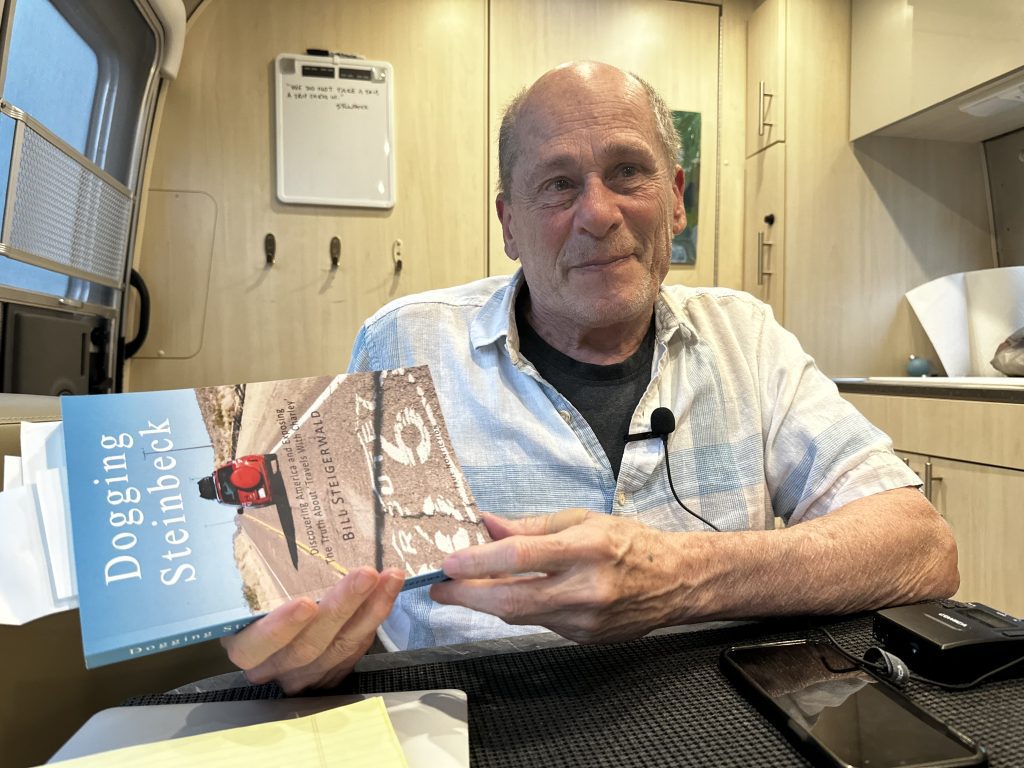
Bill Steigerwald, author of Dogging Steinbeck talking with Clay.
Steigerwald’s investigative discoveries can be summarized in this way. 1. Steinbeck did not sleep in his pickup camper as often as we are led to believe in Travels with Charley. 2. His third wife, Elaine, was with him on the journey more frequently and for longer periods than the book would have us believe. 3. Steinbeck tended to rush from Elaine encounter to Elaine encounter, which meant he had little time to have meaningful encounters with the American people, especially in the West. 4. Some episodes and incidents in Travels with Charley, including some of the most famous, did not occur. 5. Steinbeck was a rich and entitled literary celebrity who loved the good life and was not particularly comfortable roughing it in a truck camper with a chemical toilet. 6. Steinbeck’s New Deal/Great Society Adlai Stevenson and LBJ politics are obnoxious (to Steigerwald, a self-styled libertarian).
I agree with some of this, but I very strongly disagree both with the accusatory (aha! And gotcha!) approach Steigerwald took to his investigations and with the allegation that many of the incidents in the book either didn’t happen at all or not in the way Steinbeck reports them. I believe that almost all of the encounters actually occurred while acknowledging that Steinbeck (like all other writers, including Bill Steigerwald) shaped his experiences when he put them to paper. This is what writers do. Life is almost never as tidy, linear, or straightforward as the stories we tell about life in retrospect.
Put it this way. Travels with Charley is a work of literature based on an actual journey that John Steinbeck took in 1960. Bill Steigerwald naively (in my opinion) wanted to read Travels with Charley as if Steinbeck intended a rigorous book of reportage, as if there were a Charley-cam from which an actual transcript of the conversations could be drawn and a snarky fact-checker should be able to verify that every incident occurred 1) where it is placed in the book and when; 2) precisely as it is narrated in the book; 3) with no embellishments or imaginative reconstruction of dialogue; and that there are no errors of omission or commission. Since Steinbeck didn’t travel with a tape recorder, and he did not have the capacity to memorize every stray conversation on the journey, he inevitably reconstructed those conversations when he wrote the book, and OF COURSE, he brought his enormous gift for storytelling to the enterprise.
Steigerwald and I are now friends. He sat for a two-hour interview in my Airstream way back in Phase One, at Bethany, West Virginia, at a mobile home and RV park that might have been the poster for the Rust Belt. He has mellowed quite a bit in the last decade — his exposé was published in 2014. When I contacted him to set up the interview in his zip code, he invited me to park in his driveway. And he said, “Heck, if you need a hot shower and a comfortable bed, we can provide them.” To which I said, “Hey, wait a minute. You cannot fool me. If I take a shower in your house, you’ll wind up denouncing me for faking the purity of my travels.”
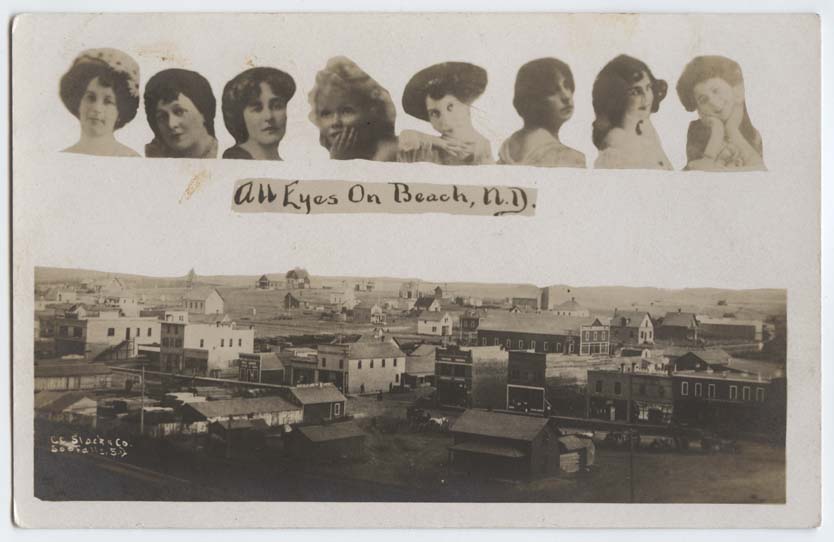
During his journey through North Dakota in October 2010, true to his self-description as an investigative journalist, Steigerwald tracked down the son of the man who built the Westgate Motel in Beach. Doug Davis of Bozeman said his father built the motel, his uncle “designed it,” and his mother managed it. Steigerwald wrote, “His mother had died a few weeks earlier, and he and his older brother found all the motel’s registration books, including those from the fall of 1960, stored at her house — and immediately pitched them in the trash.”
Alas. If those records had been preserved just a few more weeks, Steigerwald might have been able to determine a: whether Steinbeck registered at the Westgate on or about October 12, 1960, and b: what room he stayed in. It is possible, of course, in that more innocent era, that Steinbeck, who insisted that he traveled America incognito in 1960, registered under an alias. Now, if Steigerwald were really a top investigative journalist, he would have found the landfill in question and excavated those registration records. The Search for Truth has its limits.
I had dinner in Beach with old friends and new. We agreed that making more of Steinbeck’s visit would be an asset to the community. We talked about the plight of small towns in rural America. We group-gushed at how much we love the plains, the buttes, and the badlands of North Dakota.
 Robert Louis Stevenson’s book Travels with a Donkey in the Cevennes.
Robert Louis Stevenson’s book Travels with a Donkey in the Cevennes.
Steinbeck did not keep a journal during his 1960 trek. He wrote several letters to his wife Elaine back in New York and called her once or twice a week from somewhere on the road. He was dependent, of course, on the telephone infrastructure of his times. It was on one of those calls that his book got its title. Elaine was listening to his account of his misadventures with the poodle Charley. Suddenly, she said, your adventures remind me of Robert Louis Stevenson’s book Travels with a Donkey in the Cevennes. Steinbeck immediately said, that’s it, that’s my title. You have given me the title for the book. This was not the first time a Steinbeck spouse gave him a world-class title. His first wife, Carol Steinbeck, suggested the title The Grapes of Wrath for his greatest book. It’s hard now to think of the novel by any other name.
Every Steinbeck scholar studies his countless letters with great care. He was a voluminous letter writer, and he often used his morning letters as a warm-up ritual to process the artistic ideas he was struggling with and to tune up his prose. The Travels with Charley letters are essential background reading for anyone trying to make sense of the 1960 journey. It’s hard to think of any American writer whose letters are as essential to understanding their work as are those of Steinbeck. Lovers of his last big novel East of Eden, know that the letters he wrote most mornings to his longtime publisher and intimate friend Pascal Covici were published posthumously as Journal of a Novel: The East of Eden Letters, which themselves represent an American classic.
In the letter from Beach to Elaine, Steinbeck reveals several details that never found their way into Travels with Charley. The book (published in 1962, written in NYC and Barbados) does not mention a motel and leaves the reader believing that he spent the night in the badlands in his truck camper. Not so. Score one for Steigerwald! He needed a telephone. He wanted a bath. “The Dairy Queen [motel] has a large, beautiful tub, and I’m going to get into it almost at once.” Steinbeck loved his baths
In the letter, he writes what amounts to the first draft of one of the most famous passages in Travels with Charley, the one in which he says that it is the Missouri River at Bismarck and Mandan, North Dakota, where the map should fold. Here’s the passage from Steinbeck’s letter:
“North Dakota is like the great plains anywhere, and then — Wham! The Missouri River instantly becomes the West, brown hills, and then the moon country of the Badlands.”
In the book, this becomes:
“Someone must have told me about the Missouri River at Bismarck, North Dakota, or I must have read about it. In either case, I hadn’t paid attention. I came on it in amazement. Here is where the maps should fold. Here is the boundary between east and west. On the Bismarck side it is eastern landscape, eastern grass, with the look and smell of eastern America. Across the Missouri on the Mandan side, it is pure west, with brown grass and water scorings and small outcrops. The two sides of the river might well be a thousand miles apart.”
Reread the passage from the letter to Elaine and then the finished product in Travels with Charley. You immediately get a glimpse into the creative process, how a brief observation in an informal letter becomes — months later — an example of literary genius. This creative transformation may be seen as a metaphor for the entire literary gestation of Travels with Charley.
In the letter to Elaine, he provides additional details about his impressions of North Dakota, particularly the badlands. The West country features “what you call painted canyons [he drove past Painted Canyon Scenic Overlook on Highway 10] all blue and red. It was rainy at first and then the sun burst out and whopped it up. Charley has had his dinner now and peed on a rock and is sitting there watching me with a look of amused satisfaction on his face.” I’ve read this letter dozens of times over the years, and yet this is the first time I noticed the rain.
Steinbeck announces that after his luxurious bath, he will “then wash shirts and sox.” In the tub, one guesses.
And he says that he ventured a block or two to one of the taverns of Beach but “there was nothing talked but deer hunting. I’ve seen about six go by on car fenders today.” October was deer hunting season — and Dakotans, then and now, take the short deer hunting season very, very seriously. Now the detract. … I mean the investigative journalist Steigerwald did not pin down which bar Steinbeck visited on Columbus Day evening, perhaps because one of the few enterprises small towns have in multiples are bars — and churches. There are, for example, even now two Lutheran churches in Beach. And to his great credit, Steigerwald is one of the only Steinbeck re-tracers who does not obsess about food and IPA beers.
The other night, I was able to tour the inside of the Westgate Motel’s shell. Most of the interior walls have been knocked down, but there are still four old bathtubs right where they sat in Steinbeck’s time. I reckoned that the laws of probability favored at least one of those tubs in which Steinbeck soaked his weary body. The tubs were pretty short, and Steinbeck was pretty tall (6 feet even). I got in one fully clothed as part of my pilgrimage but did not lie down.
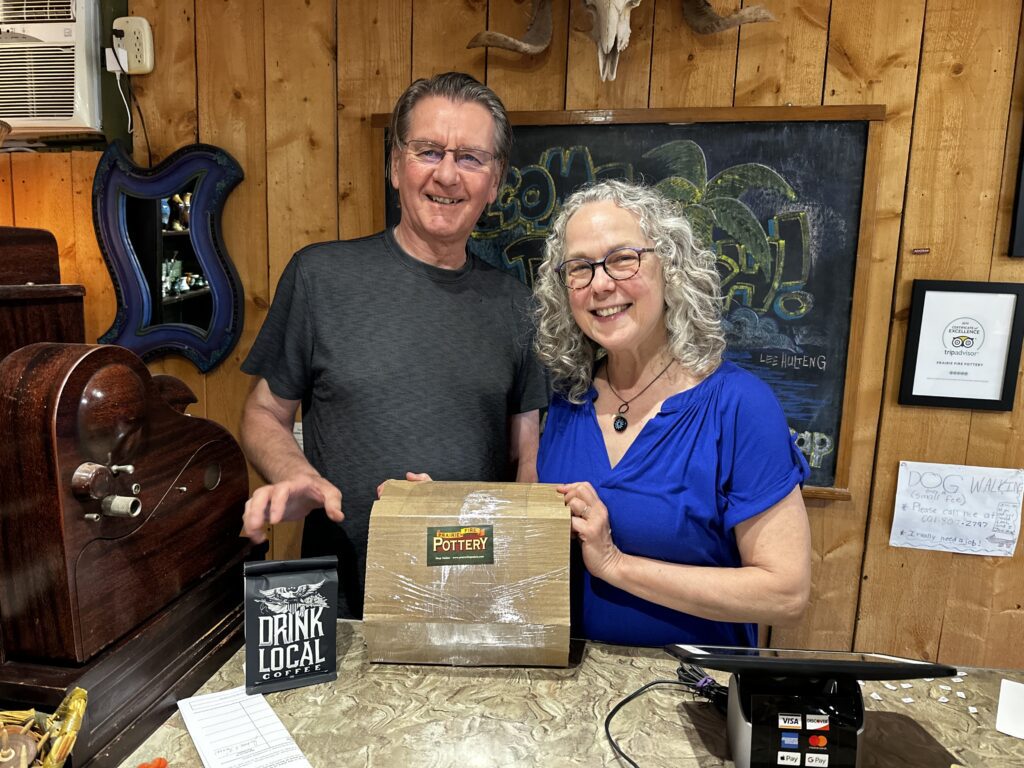
Tama and Jerry of Prairie Fire Pottery.
It was a wonderful stop on the Steinbeck Trail. I can attest (I would swear) that I have not fabricated any person, event, place, or encounter from my 20 hours in Beach. There are considerable omissions, of course, the kind that bring down the wrath of the Steigerwaldians. I walked across the street to buy a sponge at the Dollar General store; in some quarters, that is rural town sin. At dinner, I ordered the San Francisco Sourdough patty melt, but I did not eat all of it. I had a glass of pinot grigio (or, in Beach’s nomenclature, White) with dinner. Some local ruffians fired off bottle rockets, Roman candles, and firecrackers in the middle of the night at close range to my Airstream. I took delivery of an exquisite ceramic bowl from Beach’s superb potter Tama Smith, an old dear friend, the kind of North Dakotan we could use a lot more of. I did not pee in the Badlands.
I hope these additional details satisfy my friend Bill. If he finds out later it was Merlot (i.e., Red), he’ll go after me like a badger.
Let me make the following statement for the record. I said these words to Steigerwald in the Airstream in Bethany, West Virginia, and he very nearly blushed. “No future Steinbeck scholar working on Travels with Charley will be able to avoid coming to terms with Dogging Steinbeck.” Steigerwald did absolutely important legwork during his 2010 re-enactment (that nobody had bothered previously to do), and the facts he ascertained from excellent and dogged research change the way we see the man, the novelist, the husband, the great book he wrote about it.
The next hotel I know Steinbeck stayed in is not until San Francisco, and our Listening to America budget will not permit an honorary stay even for a night. So, one takes the identifiable Steinbeck hotels/motels one gets.
From the Eastern Heart of Montana- Video Dispatch
July 6, 2024
There are not many places on the John Steinbeck Travels with Charley tour where you know you are PRECISELY where Steinbeck and his companion Charley were, because so much has changed on the American highway system. Only a tiny fraction of the Interstate Highway System was in place when he traveled the country in his pickup camper.
This morning I crossed the great Yellowstone River 27 miles west of Glendive on old Highway 10. This bridge was of course in place in 1960. Because U.S. 10 has been reduced to mere “frontage road” status in this part of Montana, and therefore 99% of all traffic crosses the Yellowstone here on the four-lane interstate, I could actually stop my rig right in the middle of the steel bridge. A luxury.
Last night, Beach, North Dakota, the westernmost town in North Dakota. Tonight Billings, the largest city in Montana (population 120,000).
The Little Bighorn Battlefield National Monument- Video Dispatch
This is the era of statue removal and the systematic reinterpretation of American history. It’s all good, I believe, except for the excesses and historical ignorance of some iconoclasts, who would prefer to be righteous than to understand the nuances and deep complexities of American history.
I’ve been to the Little Bighorn perhaps 10 times in my life. I made this visit this time because Steinbeck did, on October 13, 1960. I’m not sure why he made the detour. He wasn’t much interested in historic sites at this point in his career. And what he wrote about the battlefield is cursory. I quote the passage in its entirety:
“At Custer we made a side trip south to pay our respects to General Custer and Sitting Bull on the battlefield of Little Big Horn. I don’t suppose there is an American who doesn’t carry Remington’s painting of the last defense of the center column of the 7th Cavalry in his head. I removed my hat in memory of brave men, and Charley saluted in his own manner but I thought with great respect.”
That’s it! Again, Charley lifts his leg and steals the show.
At the end of my time at the national monument, I visited in the Native American semi-subterranean circle. It amazed me how quiet it was in the circle, how everyone’s voice dropped a few decibels, and how perfectly modulated the interpretive panels were.
You can watch a brief video of my reflections above.
It's a Dog's Life- Billings, Montana
John Steinbeck’s French poodle Charley is the star of Travels with Charley. The dog must have been remarkable because he steals the show in every scene he’s in. Steinbeck wrote about him with great grace, affection, and humor.

Clay’s campsite at the KOA in Billings, Montana, came with its own fenced-in dog pen but no dog.
Billings, Montana — The question I am most often asked as I retrace Steinbeck’s 1960 journey is, “So do you have a dog?” Keep in mind that I am traveling the country to try to assess the national mood as we approach our 250th birthday. I’m wondering if we are still one country or two or more. I’m asking people what they think of the present national and international crisis of democracy. I’m asking them if we still can agree on a consensus national narrative. I’m asking what the industrial world should do about global climate change. I’m asking the people I meet if they think the republic will survive.
And all they want to know is whether I have a poodle and if not, why not.
I tell them I travel so much I can’t even keep a Chia Pet alive. Few laugh and some don’t even smile.
I can tell you that before I left on Phase One of my great journey, three of my friends offered to lend me their dogs for all or part of the trip. One of the dogs would be absolutely ideal — it has the perfect temperament, size, and look — but I declined for two reasons: first, I did not want to be responsible for someone’s beloved pet, lest it bolt across the LA freeway when I opened the door; second, it felt a little as if I would be ordering up a companion dog from central casting.
Three people have given me stuffed dogs to keep me company, one of them provided by one of my dearest friends. Also, someone sent me a poodle decal to adhere to the side of my Airstream. No bark, no bite, no feeding, no poop scoop.

Clay’s growing collection of pooches.
I’ve been racking my brain for a solution to my problem. At the Christian dinosaur museum in Glendive, Montana, the other day, I bought a stuffed Triceratops, thinking it might become the Charley of my journey (Terry the Triceratops? Trigger? Trump?) or perhaps like the soccer ball in Tom Hanks’ Castaway, it would become my Wilson. But last night I woke up to find it goring my back with its three horns and gnawing away at my calf. So that was the end of that. Never anthropomorphize some inanimate object unless you want to deal with its in it animated state.
I acknowledge that some sort of karma or cosmic justice may be at play here. When I checked into the KOA campground in Billings, Montana, they assigned me slip 170. After I had spent an hour or so trying to back into my slot, I noticed that next to my Airstream door there was my own exclusive chain link dog pen of about 15 feet in every direction. It’s a high occupancy time of year in America’s campgrounds so I thought nothing of it. I threw the Triceratops into the pen in the middle of last night but it somehow burrowed under the fence and is now said to be terrorizing the KOA population. Note to self: leave in a hurry tomorrow morning.
But when I went out tonight to do some reading (James Boswell’s London Journal) in the cool of the evening before it got dark, I discovered that the two deck chairs and the fire pit were inside the fenced pen. Nevertheless I sat down in one of the chairs, but it occurred to me that anyone looking at me from the outside would assume either that I was feral or that someone had put me in timeout. It seemed ludicrous, even monstrous, to be forced to sit next to a fire pit as if I had been assigned to a minimum security prison.
So the dog crisis continues. I may have to go pick out a rescue dog at the pound in Spokane. People who could not name a single character in any of Steinbeck’s books, including the Pulitzer Prize winning Grapes of Wrath, and who have never read Travels with Charley, somehow know that Steinbeck traveled with a remarkable poodle at his side, and they think less of me when they discover that I am wandering America without the most important asset imaginable.
It’s a dog’s life.
Steinbeck, Charley, a Stop in Yellowstone, and the Call of the Wild
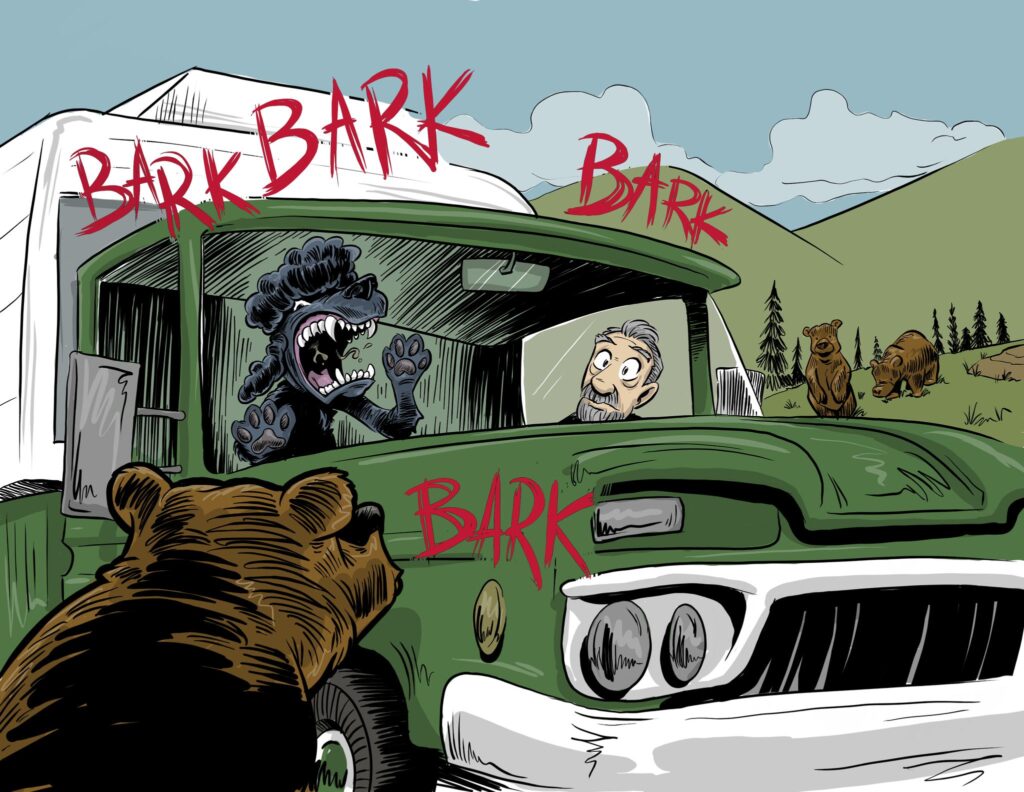
John Steinbeck and Charley visit Yellowstone National Park. ( Sketch by Nate Calderone of Salida, Colorado for LTA).
John Steinbeck was not fond of the national parks. Strange, but true. Introducing his chapter on his brief and abortive visit to Yellowstone National Park in mid-October 1960, Steinbeck wrote, “I must confess to a laxness in the matter of National Parks.” He said he could not get excited about “the greatest waterfall, the deepest canyon, the highest cliff …” He said the only reason he dipped down to Yellowstone National Park was that if he didn’t, his friends would chide him: “You mean you were that near Yellowstone and didn’t go?” Steinbeck huffed, “Yellowstone National Park is no more representative of America than is Disneyland.”
On his 11,500-mile road trip, without traveling too far out of his way, Steinbeck might have visited Acadia National Park (1929), Mount Rainier (1899), Crater Lake (1902), Glacier (1910), Grand Canyon (1919), Great Smoky Mountains (1934), Big Bend (1944), and of course Theodore Roosevelt National Memorial Park (as it was then called, established 1947). He may have entered Theodore Roosevelt NMP, though he never mentions the badlands by that name. He never mentions the Little Missouri River, the heart of the badlands of North Dakota. Clearly, national parks were not important to Steinbeck, or at least not worth seeing for himself.
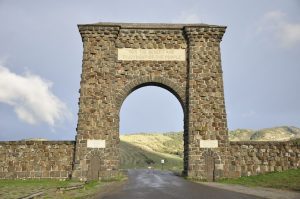
Roosevelt Arch, North entrance of the Yellowstone National Park. (Wikimedia)
Steinbeck drove south of Livingston, Montana, to the Roosevelt Arch at Gardiner, the North Entrance of Yellowstone, to shut up his friends. At the entrance kiosk, a ranger warned him to keep his poodle Charley on a leash. Steinbeck asked why. “Because of the bears,” the ranger said. At that point, Steinbeck gave a long speech about what a coward and pacifist Charley was. He wouldn’t disturb a caterpillar. “His greatest fear is that someone will point out a rabbit and suggest that he chase it.” Charley stood for “peace and tranquility.” The ranger repeated his warning, but Steinbeck just laughed him off.
One mile into the park, Steinbeck and Charley encountered a bear.
Let Steinbeck tell the story:
“Instantly, a change came over Charley. He shrieked with rage. His lips flared, showing wicked teeth that have some trouble with a dog biscuit. He screeched insults at the bear, which, hearing, the bear reared up and seemed to me to overtop Rocinante. Frantically, I rolled the windows shut and, swinging quickly to the left, grazed the animal, then scuttled on while Charley raved and ranted beside me, describing in detail what he would do to that bear if he could get at him.”
Look at what a great writer Steinbeck is. He lightens the tone with the quip about the biscuit and then has Charley “describing in detail what he would do to that bear. …”

Steinbeck said he had never been so astonished in his life. So far as he knew, Charley had never encountered a bear before. Up to now, Charley “had showed great tolerance for every living thing. ”A little deeper into the park, they encountered two more bears. “The effect was doubled. Charley became a monster. He leaped all over me; he cursed and growled, snarled and screamed. I didn’t know he had the ability to snarl.” Steinbeck cuffed the dog to settle it down without effect. As soon as they were away from the pair of bears, Steinbeck stopped on the side of the road and locked Charley in the camper. But when they came upon bears again, the dog went berserk back there. “I could hear canned goods crashing as he struggled in his mania.”
Steinbeck turned his pickup around and drove quickly out of the national park. “It was too nerve-wracking,” he explained, “a shocking spectacle, like seeing an old, calm friend go insane.” Steinbeck stopped to apologize to the ranger as he drove through the gate. He understood now. He drove back to Livingston and got a room in “a pretty auto court” (i.e. the kind of motel where you can drive right up to your room).
So, John Steinbeck lost his one chance to camp in Yellowstone National Park.
When they got into the room at the auto court, Steinbeck inspected Charley. “He was dazed. His eyes held a faraway look and he was totally exhausted, emotionally no doubt. Mostly he reminded me of a man coming out of a long, hard drunk — worn out, depleted, collapsed. He couldn’t eat his dinner, he refused the evening walk, and once we were in he collapsed on the floor and went to sleep. In the night I heard him whining and yapping, and when I turned on the light his feet were making running gestures and his body jerked and his eyes were wide open, but it was only a night bear.”
Steinbeck concludes the chapter with grace and wisdom: “I wonder why we think the thoughts and emotions of animals are simple.”

This incident happened back in the day when tourists fed the Yellowstone bears by the side of the road. That era, fortunately, has passed (though it would be kind of cool). In principle, I’m against any effort to anthropomorphize wild creatures, such as “adopting” individual wolves in Yellowstone and bestowing names on them or grizzly bears, one of which is known to smarmy tourists as Raspberry.
Steinbeck indicates an understanding that the park boundaries do not delimit the movement of wild creatures like mountain lions, buffalo, wolves, moose, and bears. “I was reluctant to camp [north of the park boundary],” he said, “for fear there might be some unofficial non-government bears about.” Again, Steinbeckian humor. Though massive, Yellowstone National Park embraces only one-tenth of what is known as the “Greater Yellowstone Ecosystem.” Wild creatures do not conform to arbitrary human boundaries — this is the source of a great deal of confusion, conflict, and misunderstanding in and near Yellowstone and other national parks.
So national parks did not have any allure for John Steinbeck. He was even ho-hum about Niagara Falls, which he visited only to shut up his friends. The only historical sites he visited were the Little Bighorn battlefield south of Billings, and then only for a short and uneventful visit, and Fremont Peak in Monterey County, California.
So the question is: besides his wife Elaine, whom he missed sorely on the journey, and his stubborn commitment to drive the entire perimeter of the United States (once begun, he could hardly throw in the towel), what interested Steinbeck on his journey, what caught his attention, what did he choose to explore and observe?
That’s the question I am trying to answer as I retrace his journey.
I asked my friend, Nate Calderone of Salida, Colorado, to draw one of his splendid caricatures to depict the moment when the highly refined French aristocratic poodle (a known coward and poltroon) heard the call of the wild.
Archives
The Steinbeck Collection at the National Steinbeck Center started with a small donation of Steinbeck first-edition books in the 1960s. From humble origins and with the careful collecting and stewardship across decades by people dedicated to Steinbeck’s legacy, the Collection has grown to include approximately 40,000 items, ranging from manuscripts to newspaper clippings, and films to artwork.
The mission that drives the collection, preservation, and sharing of the items in the Steinbeck Collection is to document and share Steinbeck’s legacy. To that end, the collection includes items as varied as John Steinbeck’s life and experiences as a student, war correspondent, novelist, State Department emissary, and Nobel Laureate.
The highlights of the Collection are further described below. For more information about other parts of the Collection, such as foreign editions of Steinbeck’s works, critical analysis and review of Steinbeck’s life and writing, art, or film, please contact the Archivist at archives@steinbeck.org
Contact the Archivist
Please contact Guest Services for Archive Showings or Docent-led Tours at 831.775.4721
Resources
In an effort to support our amazing educators, we have officially launched the National Steinbeck Center’s Educational Resources web page, where you will find interactive lesson plans from our award-winning Red Pony curriculum, fun activities, interactive content and more that can be enjoyed from the comfort of your home.
The Time the Wolves Ate the Vice Principal
January 11, 2024
Interactive Activity 8 – Teaching The Pearl Curriculum Guide: Writing an I AM Poem
April 21, 2020
Poetry is a creative form of writing that allows people to express their feelings and ideas through the use of distinctive style and rhythm. Use the “I AM” model below to craft a poem from the point of view of a character from John Steinbeck’s novels or short stories. You can also choose to write one after a literary character that you read about recently. The poem should be no longer than one page. Study the poem on the second page to give you a better idea of how your poem can look like.
Let’s celebrate National Poetry Month together by show us your dramatic reading abilities and recording yourself (with your parent/guardian’s permission) reading it out loud portraying the character you chose and hash tagging #SteinbeckFromHome for a chance to be featured in our social media accounts. Be creative and have fun!
Interactive Activity 7 – Share Your Family Stories
April 7, 2020
Did you know that John Steinbeck’s maternal grandfather, Samuel Hamilton, was from Ireland and was one of the pioneer settlers of the town of Salinas during the 1850s? Steinbeck’s family history can be traced all the way back to his European roots. While we are all spending more quality time with our families at home, why not dive into your families’ histories and discover new tales about your past and ancestors.
Straight from our National Steinbeck Center Vault we are sharing a set of bilingual activities from our “A Century Ago in Steinbeck Country” Curriculum for Grade 3 that will provide students with a model for asking the right questions to dig deeper into their family history and find some true gems. Download the “Family Stories Lesson Plan for Grade 3” activities from the link above or click here!
Interactive Activity 6 – Steinbeck Scavenger Hunt
March 31, 2020
Today we invite you to take your Steinbeck knowledge and powers of deduction by participating in our virtual scavenger hunt! Download the clues from the link above (or click here) and use our virtual museum tour by visiting here (or here: www.steinbeck.org/visit/virtual-tour) to find the answers to the questions.
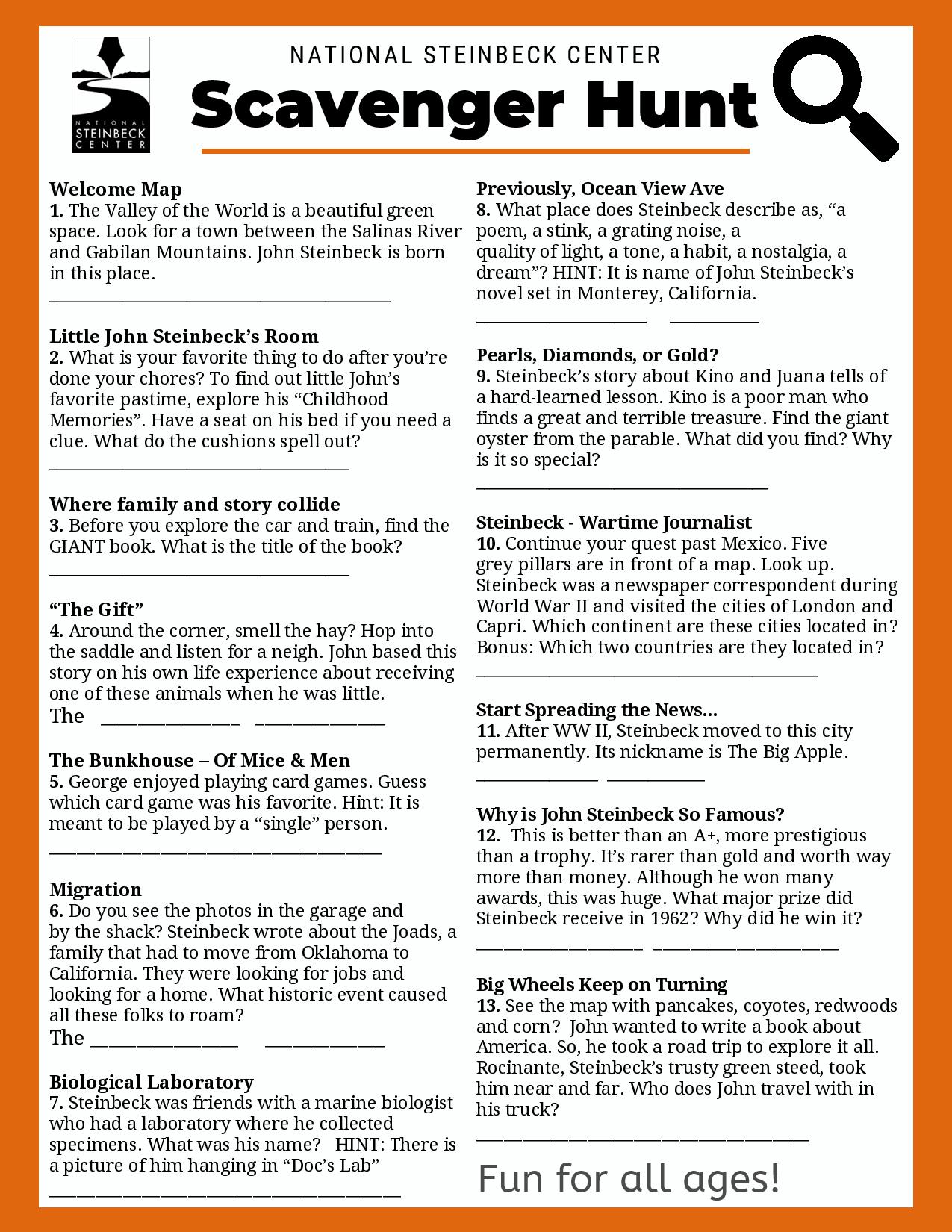
Record the time that it takes you to complete it and share it on our social media: www.facebook.com/nationalsteinbeckcenter!
Interactive Activity 5 – Interactive Activity 5 – Steinbeck Crossword Puzzle
March 29, 2020
Interactive Activity 4 – “Steinbeck Lotería / Mexican Bingo” Lesson Plan
March 24, 2020
Today we’re going to have a fun bilingual activity with “Steinbeck Lotería / Mexican Bingo”!
All the materials you will need to play this game are available on the download link above, including instructions and “Lotería” game cards. If you have any questions or if you’d like to suggest more interactive lesson plans, please send us an email to: SYA@steinbeck.org.
We also invite you to take a video or photo of your favorite board games and tag us @steinbeckcenter on your posts and we will share our favorites on our Instagram stories.
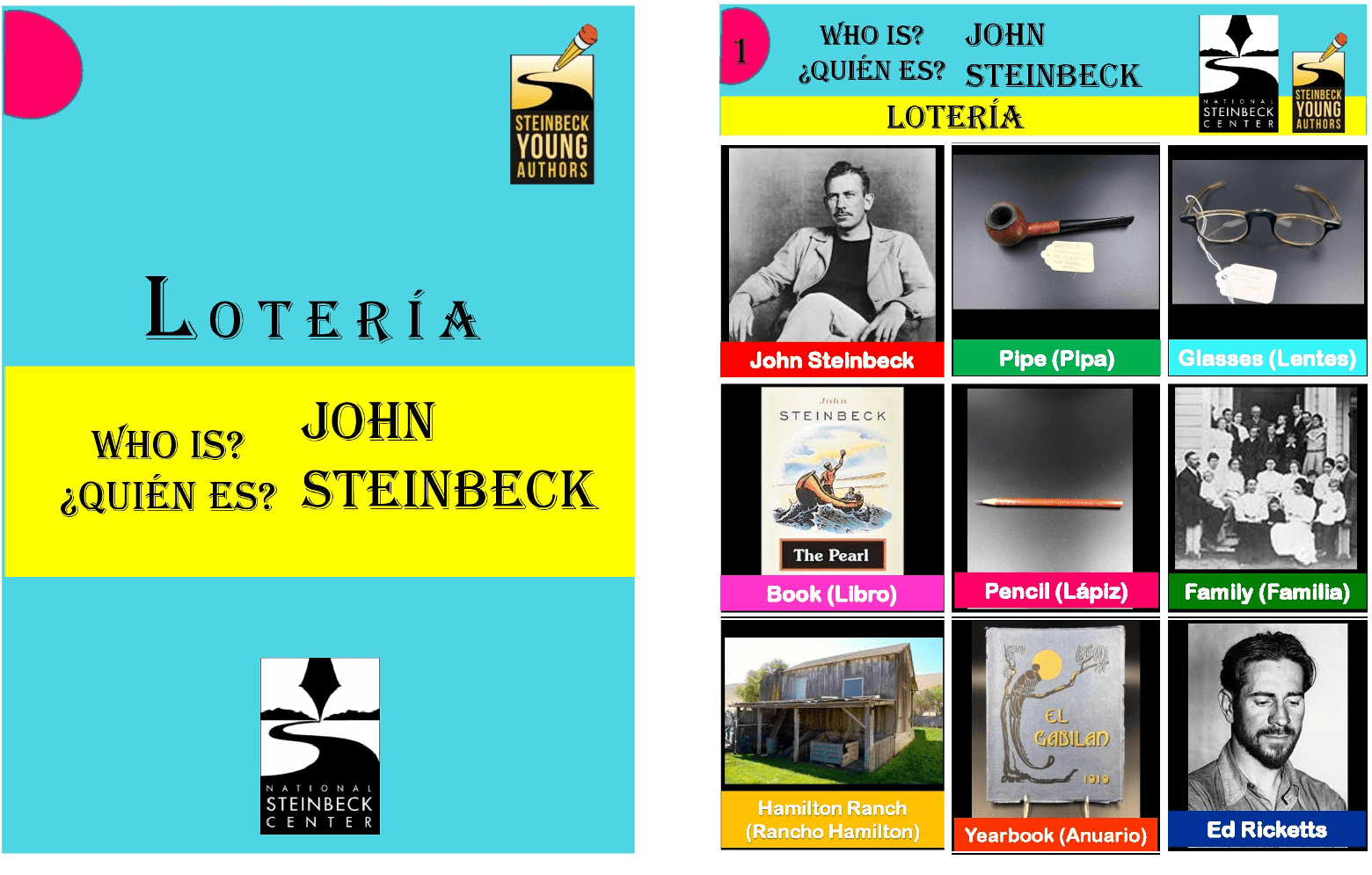
Interactive Activity 3 – “Preparing a Veterinarian Report” Lesson Plan
March 23, 2020
Today we’ll discover what it’s like to be a vet and learn about the fascinating world of horses! Tag us on social media with the hashtag #SteinbeckCenter with your favorite animal friend for a chance to be featured in our stories!

“No matter how good a man is, there’s always some horse can pitch him.”
-John Steinbeck, The Red Pony
Interactive Activity 2 – “Writing a Letter” Lesson Plan
March 20, 2020
Nowadays, writing letters can be a fun and quarantine-compliant way to show solidarity with one another. Learn to write a compelling letter to your favorite recipient by downloading our Red Pony curriculum “Writing a Letter” lesson plan from our Educational Resources web page.
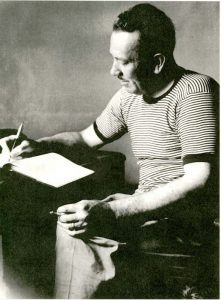
During John Steinbeck’s lifetime, letter writing was one of the most popular forms of communication.
Interactive Activity 1 – Steinbeck Coloring Sheets
March 19, 2020
Bibliography
Newsletter Archives
Summer 2023

Spring 2023
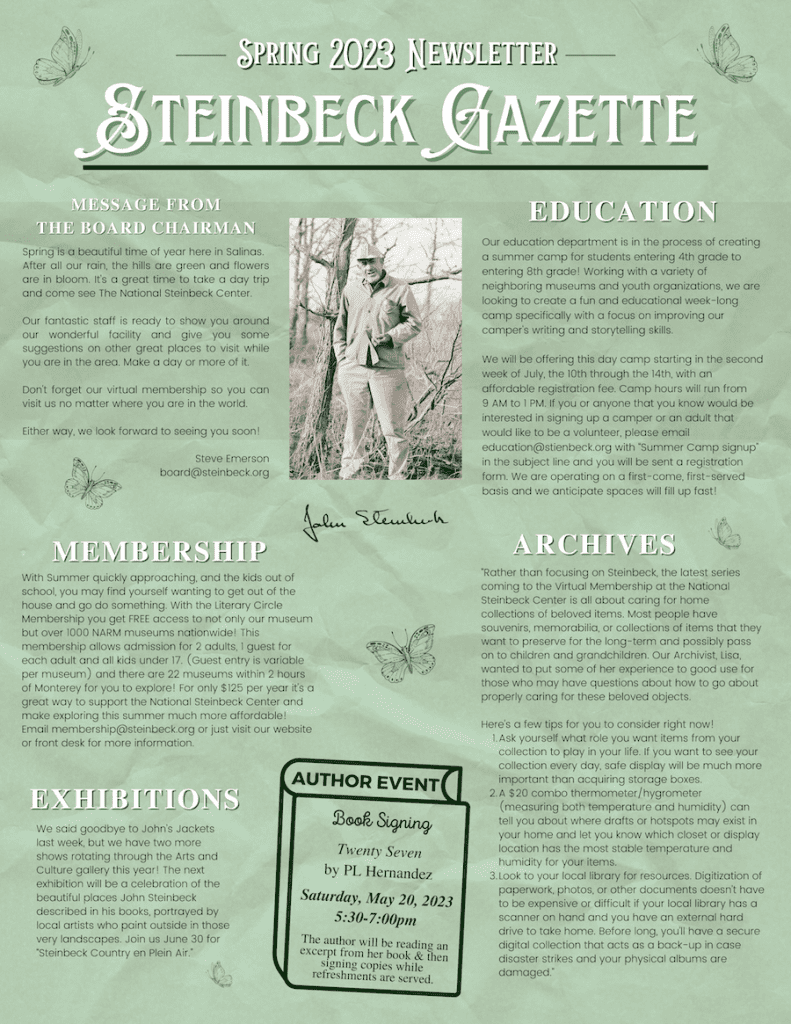
Early Spring 2023
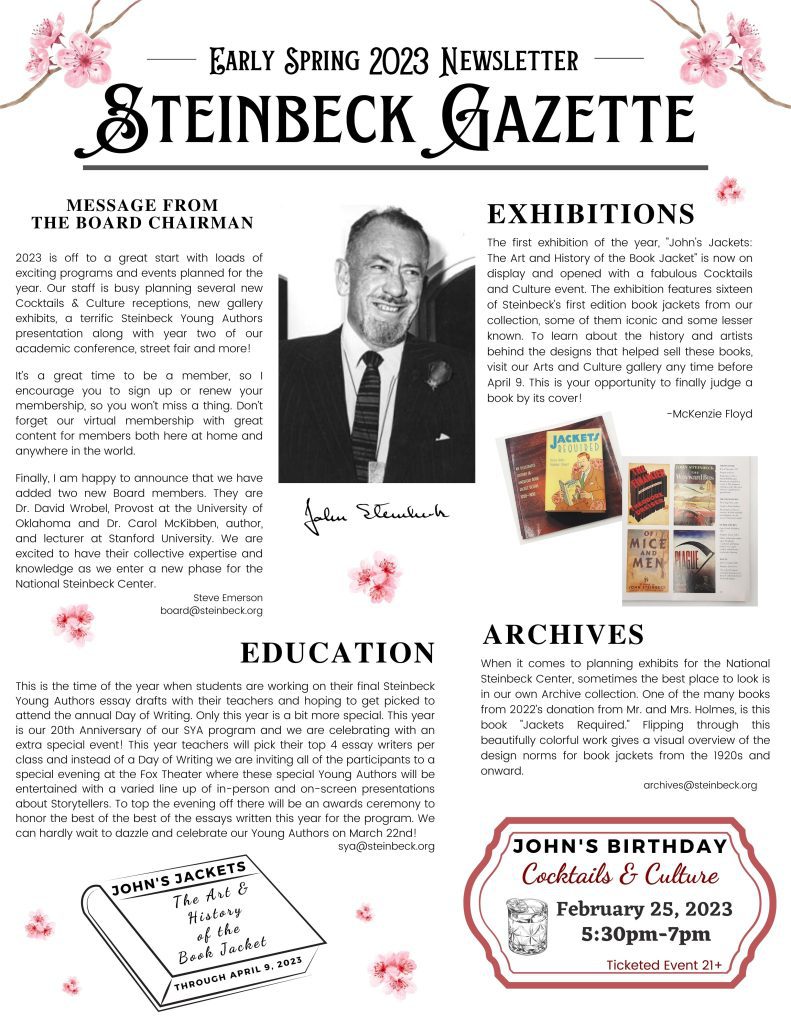
Winter 2022
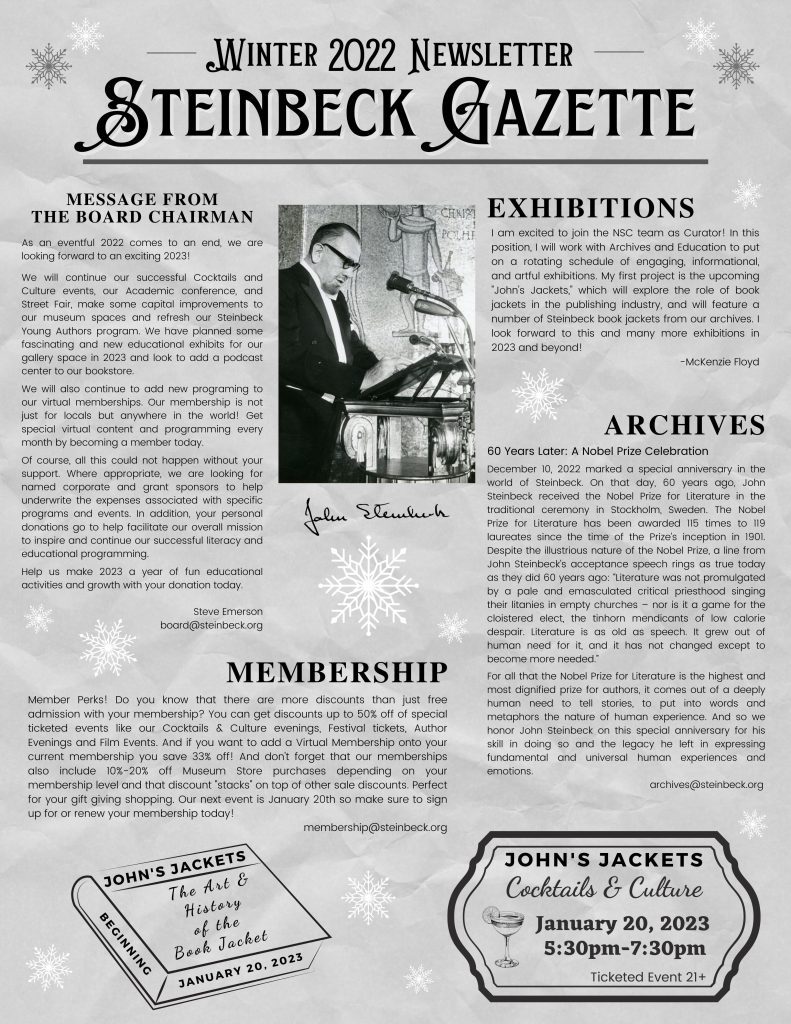
Fall 2022
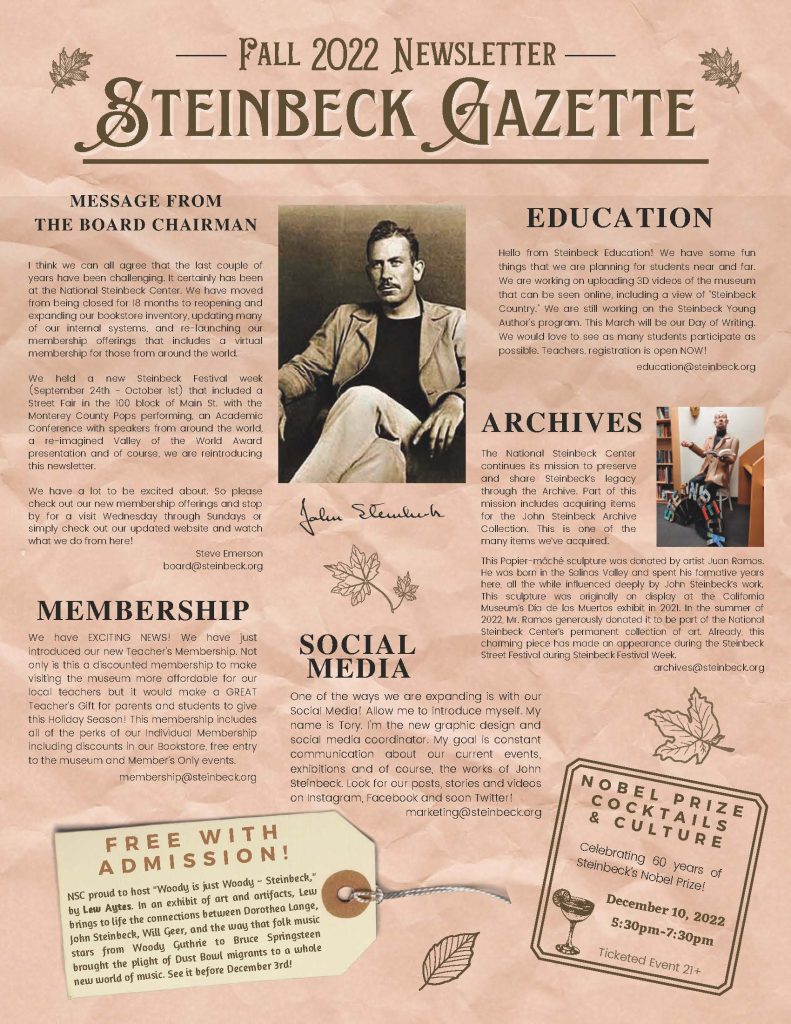
Join our email list and be the first to know about special events and more!
Visit Us
1 Main St, Salinas, CA 93901
831.775.4721
- Privacy Policy
- Terms of Use
Contact Us
National Steinbeck Center © 2021. All Rights Reserved.




